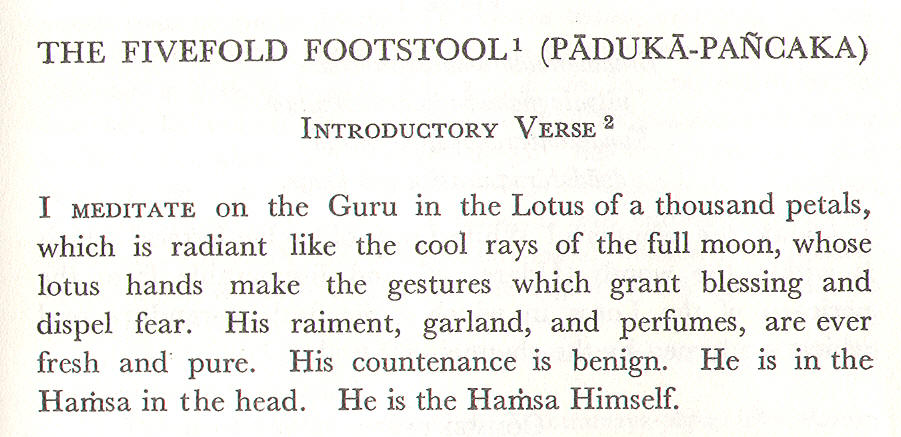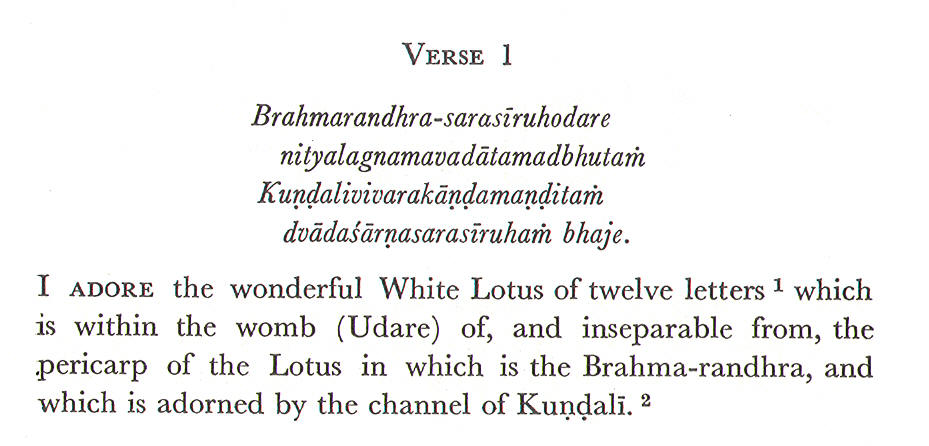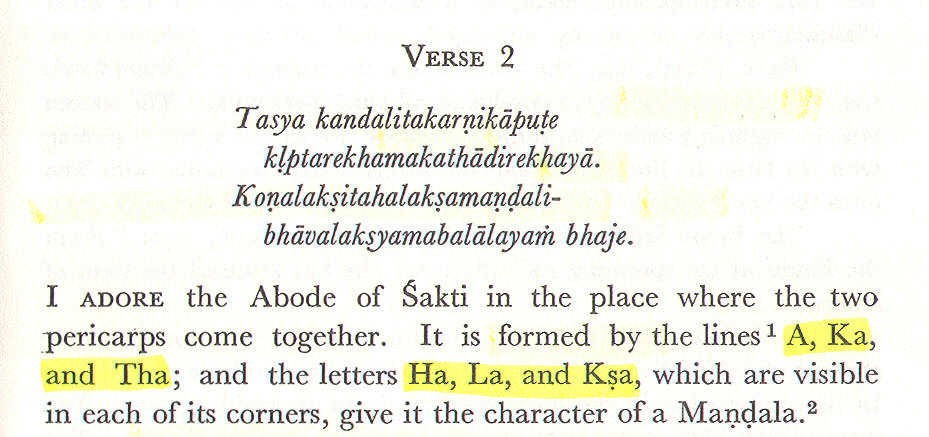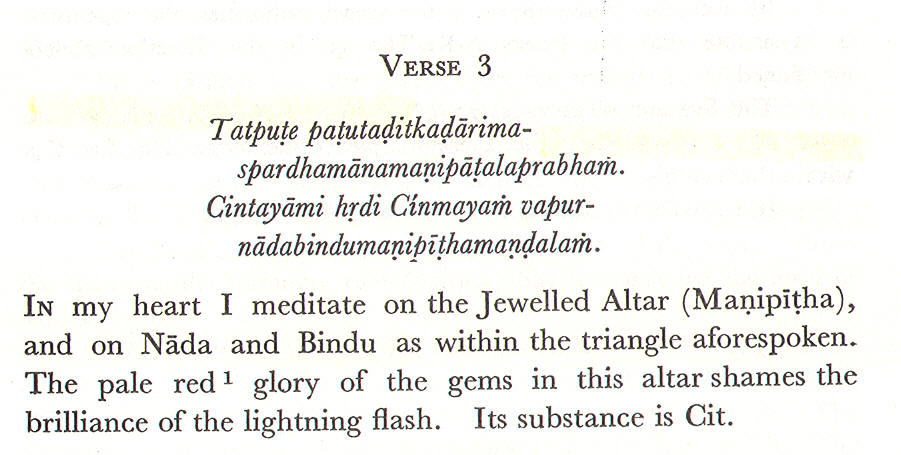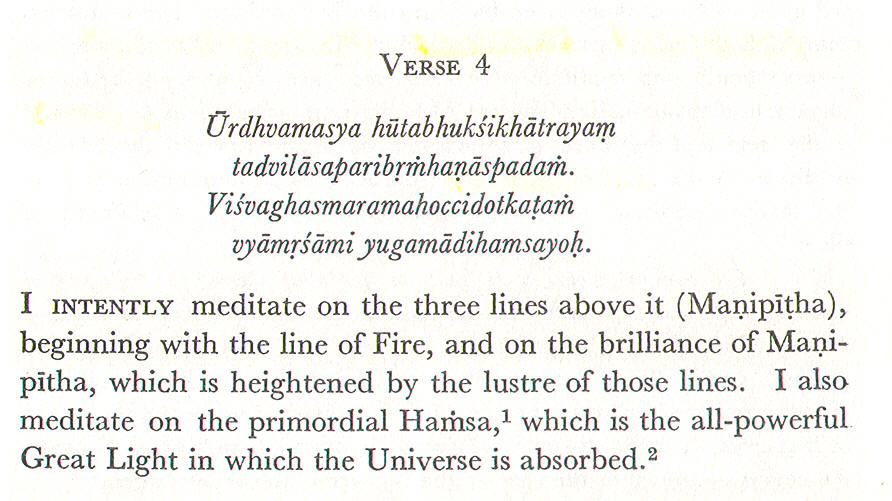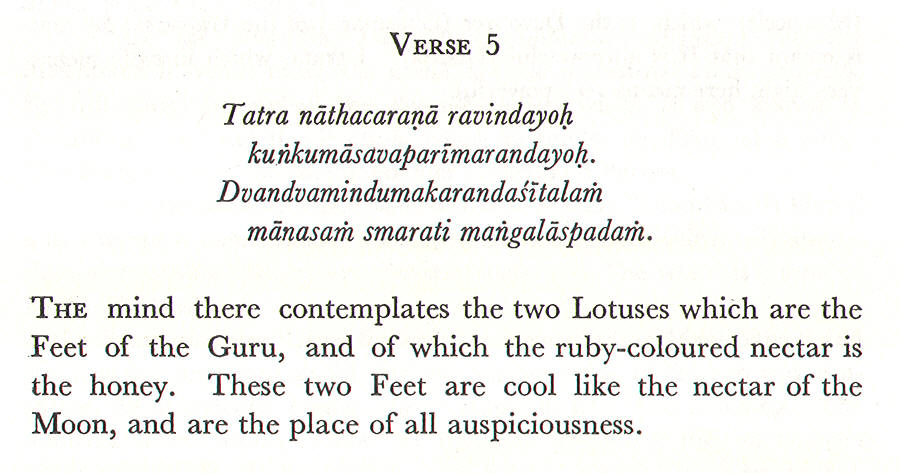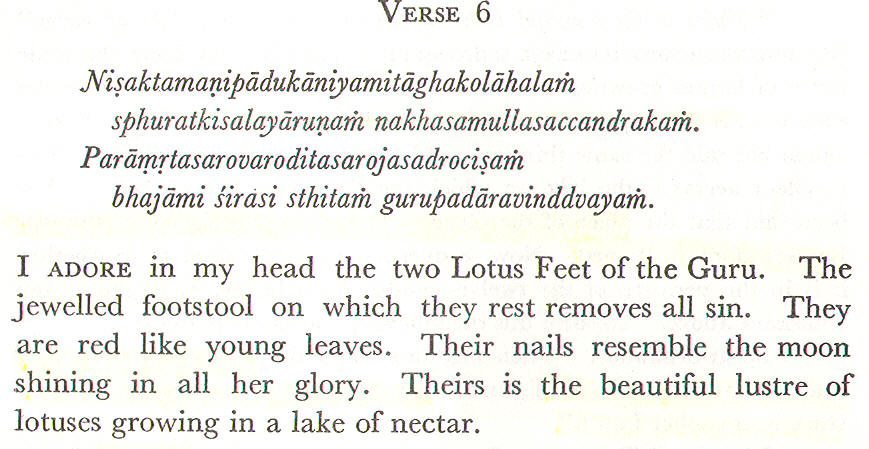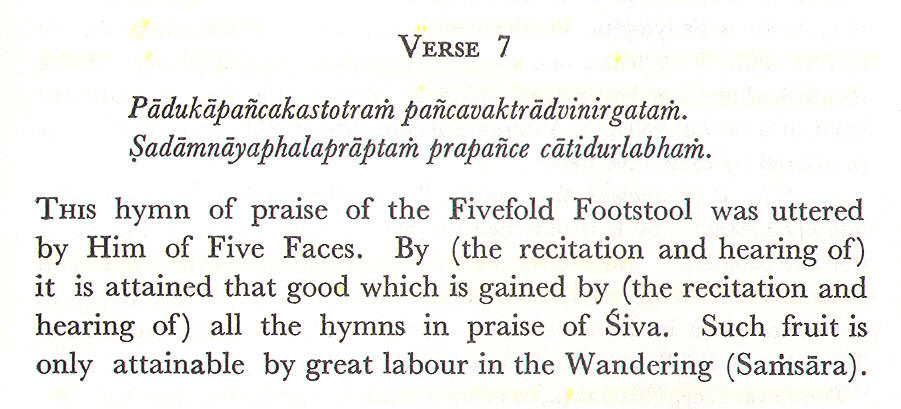Author: Purnananda-Svami (1526 CE)
Commentary: Kalicarana in Sanskrit
English Translation: Sir John Woodroffe
Source: the Serpent Power
Flowcharts, illustrations, Commentary: Veeraswamy Krishnaraj
Sat-Chakra-Nirupana
Six-Chakra Investigation
Description of and Investigation into the Six Bodily Centers
By Tantrik Purnananda-Svami (1526 CE)
Sat-Chakra Nirupana is the Premier Composition on Kundalini Chakras.
The Commentary was by Kalicarana in Sanskrit.
This article is about Kundalini Chakras as described by Swami Purnananda.
Go to Kundalini Power for more details on Kundalini Yoga.
Pūrnānanda a Brahmana of Kasyappa Gotra wrote Sat-Chakra-Nirupana (1526 CE, SAka year 1448) and achieved Siddhi in VasisthAsrama, about seven miles from Gauhati, Assam, India. He wrote many other Tantrik works. This work is part of Sri-Tattva-Cintamani.
English translation by Woodroffe (Serpent Power) is full in some verses; short, condensed in some verses; and modified in other verses. Some verses have extensive commentaries and illustrations by me. This includes my comments, additions, flowcharts, drawings, montages....
Translation of some Sanskrit words and phrases follows the Monier Williams dictionary and may differ from that of Woodroffe. For your convenience, segments of the verses and their translation are color-coded for easier identification by sight.
Preliminary verse:
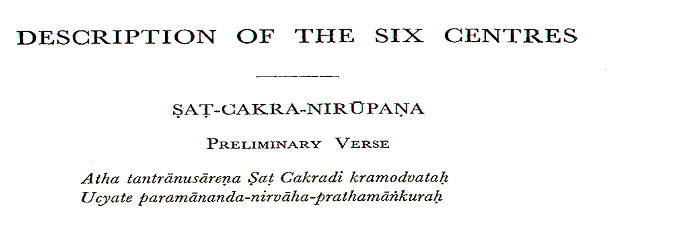
Atha tantrānusāreṇa ṣaṭ chakradi kramodvatah
Ucyate paramānanda-nirvāha-prathamāṅkurah
Now I speak of (the first step) sprouting shoot of the Yoga plant of complete realization of the Brahman, which is to be achieved, according to the Tantras, by means of the six Cakras and so forth in their proper order.
Ucyate ParamAnanda = Says Paramananda. Atha = Now. tantrAnusArena = following the Tantras PrathamAnkurah = First step. nirvAha- = Complete realization Sat Cakradi Kramodvatah = Achieved by means of the six Chakras and other things.
The six Chakras are Muladhara, Svadhisthana, Manipura, Anahata, Vissuddha and Ajna. The accomplished Kundalini Yogi only can explain the principles of Kundalini Yoga. Neither the best of the wise nor the most advanced in age can explain them without the mercy of the Guru. It is full of the greatness of śa, ṣa, Ha ( श ष ह the last three letters of the Sanskrit alphabet). ṣa, Sa, Ha point to Brahma, Vishnu, and Siva.
ParamAnanda is Supreme Bliss and Nityam, Vijananam and Anandam (Eternal, Knowledge, Bliss). Other things refer to Nadis, Lingas, the five elements, Siva Sakti.... presentation: Veeraswamy Krishnaraj
Verse 1

Merorbāhyapradeśe śaśi mihirasire savyadakṣe niṣaṇṇe
Madhye nādi suṣuṁnātritaya-guṇamayi candrasūryagnirūpā
Dhattūra-smera-puṣpagrathita-tamavapuḥ kandamadyacchirahstā
Vajrākhyā meḍhradeśā cchirasi parigatā madyameऽsyā jvalanti
In the space outside the Meru, placed on the left and the right, are the two Siras, Sasi and Mihira. The Nadi Susumna, whose substance is the threefold Gunas, is in the middle. She is the form of Moon, Sun, and Fire; Her body, a string of blooming Dhatura flowers, extends to the middle of the Kanda to the Head, and the Vajra inside Her extends, shining, from the Medhra to the Head.
Commentary: Here is the mention of Nadis and Chakras, the knowledge of which is necessary for Kundalini Yoga. Meru is literally a mountain, the central pole of the world; likewise Meru is the vertebral column of the human body. Siras and Sasi are the Moon and the Sun, Ida and Pingala Nadis of the left and right side. Gunas refers to the qualities of the central Susumna Nadi as Sattva, Rajas and Tamas. www.bhagavadgitausa.com/Sat-Chakra-Nirupana-Kundalini Chakras.htm
bāhyapradeśe = in the space outside. śaśi-mihira-sire = Moon and Sun Nadis = Ida and Pingala nadis. Meru = Meru mountain = spinal column from the Muladhara Chakra to the neck. savyadakṣe niṣaṇṇe = placed on the left and right. Madhye-nādi-suṣuṁnā = the central Nadi or canal = susumna Nadi. Remember these Nadis are subtle and not anatomical. Susumna Nadi extends from Muladhara to Brahma Randhara-the anterior fontanel area. tritaya-guṇamayi = whose substance is the three Gunas or modes: Sattva Rajas and Tamas. There is a central Nadi which has three components, a tube within a tube, three tubes in all: Citrini Nadi is Sattva; Vajra Nadi is Rajas; Susumna Nadi is Tamas. Serpent Power: Page 150 lists Susumna Nadi, Vajrini Nadi, Citrini Nadi and the central Brahma Nadi or canal. candrasūryagnirūpā = Moon-Sun-Fire form. Citrini Nadi is pale and of the form of Moon. Vajrini is of the form of Sun. Susumna is fiery red like Fire. kandamadyacchirahstā = Kanda-MadhyAt-SirahsthA = from the middle of the Kanda to the head. Kanda means bulbous root, present in the Uro-genital Triangle in man, the point being two fingers above the anus and two fingers below the root of the phallus (medhra). 72K Nadis emerge from the Kanda, of which only three are the most important: Ida, Pingala, and Susumna. Susumna goes to the neck, emerges from the spine, goes to the forehead, passes between the eyebrows united with Kundali, goes near the Brahma Randhra and ends near the 12-petalled lotus. Susumna clings on to the stalk of Sankhini as it goes up the spinal cord. Sankhini is a Nadi that starts at Kanda, reaches the throat, divides into two branches, one branch going to the left ear and the other goes to the crown. madyameऽsyā = Vajrah inside her = Inside Susumna Nadi. presentation: Veeraswamy Krishnaraj
Verse 2

Tanmadhye citriņī sā praṇavavilāsitā yoginām yogagamyā
Lūtātantūpameyā sakalasarasijān merumadhyāntarasthān
Bhittva dedipyate tad-grathana-racanayā śuddha-bodha-svarūpā
Tanamadhye brahmanāḍī harakukha-kuharadādi-devāntarātmā.
Inside her is Citrini, who is lustrous with the lustre of the Pranava and attainable in Yoga by Yogis. She (Citrini) is subtle as a spider's thread, and pierces all the Lotuses which are placed within the backbone, and is pure intelligence. She (Citrini) is beautiful by reason of these (Lotuses) which are strung on her. Inside her (Citrini) is the Brahmanadi, which extends from the orifice of the month of Hara to the place beyond, where Adi-deva is.
Tanmadhye = Inside Her (Vajra). praṇavavilāsitā = lustrous within the luster of Pranava (om). She absorbs the luminosity from Pranava in Ajna Chakra as she passes through it. Lūtātantūpameyā = like a spider's thread. She is fine like a spider's thread. sakalasarasijān merumadhyāntarasthān Bhittva dedipyate = She pierces all the lotuses. Tanamadhye = inside Her. Within Citrini is Brahma Nadi, through which Kundalini goes from Muladhara to Parama Siva. Kundalini is of the from of Sabda Brahman. harakukha-kuhara = The orifice of mouth of Hara. It is the orifice at the top of the Svayambhu Linga in Muladhara. Adi Deva is the Supreme Bindu in the pericarp of the 1000-petalled lotus.
Susumna = Su + Sumna = Excellent + musical hymn, happiness or joy = perfect harmony. All these important Nadis are called Susumna. Essentially Susumna consists of the substance of the spinal cord with the three Nadis inside it, placed one tube inside the other. There is the central Nadi (Brahma Nadi), middle Nadi is Chitra Nadi (AKA Citrini) and the outer Nadi (Vajra Nadi). Kundalini passes through the Central Brahma Nadi. Remember these are subtle channels, canals or Nadis and not anatomical entities. Chitra Nadi = Citrini = The Nadi is anthropomorphized and deified.
See the Diagram below
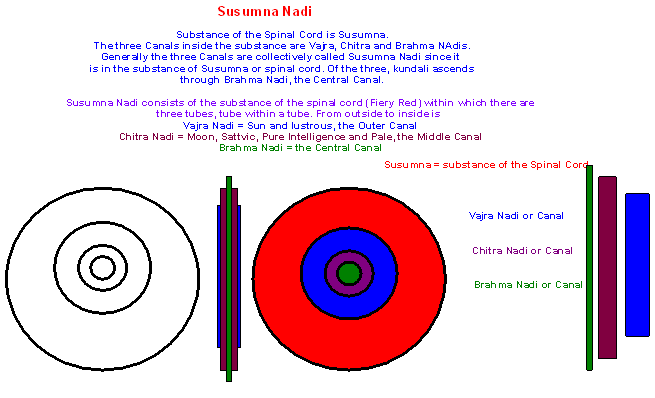
Verse 3
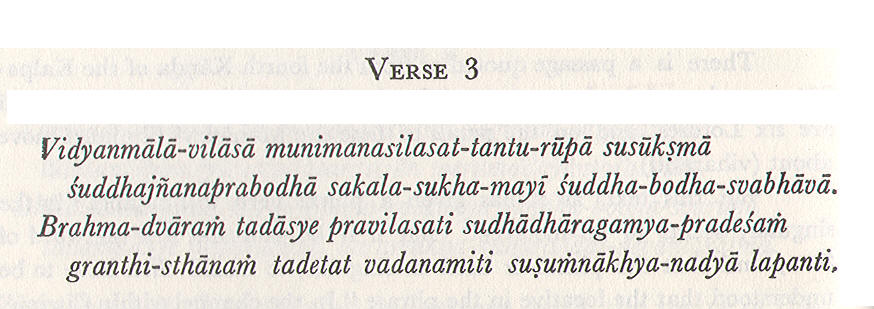
Vidyanmālā-vilāsā manimanasilasat-tantu-rūpa susūkṣmā
śuddhajṅanaprabhodhā sakala-sukha-mayī śuddha-bodha-svabhāvā
Brahma-dvāraṁ tadāsye pravilasati sudhādhāragamya-pradeśaṁ
Granthi-sthānaṁ tadetat vadanamiti suṣuṁnākhya-nadyā lapanti.
She1 is beautiful like a chain of lightning and fine like a (lotus) fibre, and shines in the minds of sages. She is extremely subtle; the awakener of pure knowledge; the embodiment of all Bliss, whose true nature is pure Consciousness. The Brahma-dvara shines in her mouth. This place in the entrance to the region sprinkled by ambrosia, and is called the Knot, as also the mouth of Susumna. presentation: Veeraswamy Krishnaraj
She1 = Citrini who ascends through Brahma Nadi, the innermost tube of Susumna Nadi. Also known as Chitra Nadi.
lasat-tantu-rūpa = Fine like a (lotus) fiber and shines (because of the presence of Kundalini). sakala-sukha-mayī = Sukha is Ananda or Spiritual Bliss. She is the source of all Bliss. Sukha = (literal meaning) pleasant, gentle, agreeable. śuddha1-bodha2-svabhāvā3 = Whose true nature is Pure Consciousness. Literal meaning = Pure1 Consciousness2 by natural constitution3. Brahma-dvāraṁ = Brahma's opening, gate, entrance or exit for Kundalini and Her ascent to Siva or descent from Siva. tadāsye = her mouth. the mouth of Brahma Nadi. tadetat = the place near the entrance. sudhā1dhāra2gamya3-pradeśaṁ4 = literal meaning = Pure-containing- union of [Parma-Siva and Sakti]-place = The place that contains Ambrosia (Suddha) which comes from the union of Siva and Sakti. Here the union (StrIpum-yogAt = woman-man union) is symbolic. Granthi-sthānaṁ = Knot-place = the place where there is a knot at the root of all Nadis.
sva-bhāvā: Kalicarana says it means one's nature. Sankara says it means Jnana which is Paramatma or divine or spiritual Jnana. Sankara reads śuddha-bodha-svabhāvā as śuddha-bhāvā-svabhāvā. www.bhagavadgitausa.com/Sat-Chakra-Nirupana-Kundalini Chakras.htm
Verse 4
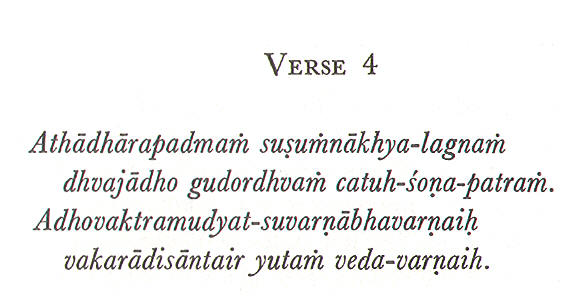
Athādhārapadmaṁ suṣuṁnākhya-lagnaṁ
Dhvajādho gudordhvaṁ catuh-śoṇa-patraṁ.
Adhovaktramudyat-suvarṇābhavrṇaih
Vakarādisāntair yutaṁ veda-varṇaih.
Next we come to the Adhara Lotus1. It is attached to the mouth of the Susumna, and is placed below the genitals and above the anus. It has four petals of crimson hue. Its head (mouth) hangs downwards. On its petals are the four letters from Va to Sa, of the shining colour of gold.
From Verses 4 to 13, Paramanand describes the Muladhara Chakra. Adhara Lotus1 = Support-Lotus = Muladhara Chakra Lotus at the base of the spine in the Uro-genital triangle.
suṣuṁnākhya-lagnaṁ = It is
attached to the mouth of Susumna. Four Petals of the Muladhara Chakra are
present at the junction of Kanda and Susumna. Dhvajādho gudordhvaṁ = from below
the root of the genitals to Susumna. catuh-śoṇa-patraṁ. = four red petals. Red or
crimpson. Vakarādisāntair yutaṁ veda-varṇaih. = The four
letters are Va, śa (palatal), ṣ (cerebral), and Sa. Vedavarna =
Veda character = means four Vedas. The letters on the petals are to be
meditated upon in a clockwise fashion. Here Veda stands to mean four. The letters of the alphabet
on each of the petals of the six lotuses are to be meditated upon going round a
circle from the right (Dakṣināvartena: clock-wise direction.)

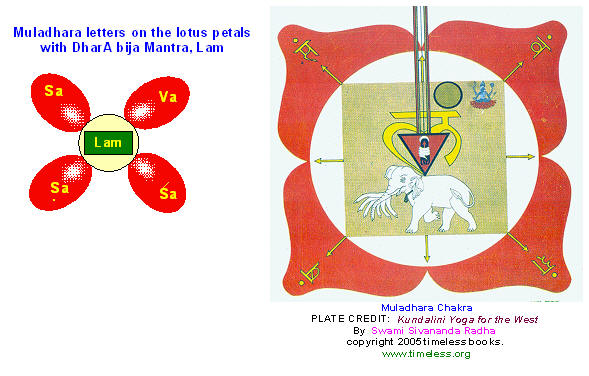
Verse 5
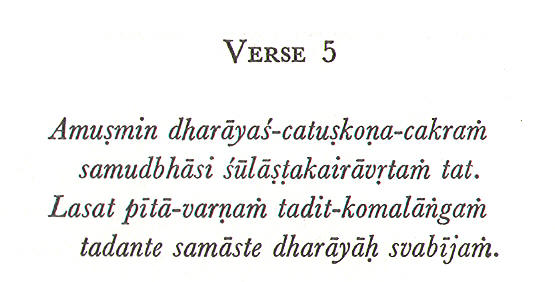
Amuṣmin dharāyaś-catuṣkoṇa-cakraṁ
Samudbhāsi śūlāṣṭakairāvṛtaṁ tat.
Lasat pītā-varṇaṁ tadit-komalāngaṁ
Tadante samāste dharāyāḥ svabījaṁ
In this (Lotus) is the square region (Cakra) of Prthivi, surrounded by eight shining spears. It is of a shining yellow colour and beautiful like lightening, as is also the Bija of Dhara which is within.
Parts of the translation are not by Woodroffe.
Amuṣmin dharāyaś-catuṣkoṇa-cakraṁ = In this (Lotus), Earth's four-angle Chakra. dharāyāḥ svabījaṁ: Bija of Dhara: it is the Root mantra of Earth, Lam. Prithvi is Earth, which is a Tattva, principle or building block of the world. śūlāṣṭa = Asta + Sula = 8 spears. Eight spears meaning eight directions or points of compass. Lasat pītā-varṇaṁ tadit-komalāngaṁ = shining yellow color, beautiful like a lightning, having a tender body. Tadante samāste dharāyāḥ svabījaṁ= within it seated Bija of Dhara: it is the Root Mantra of Earth, Lam. Prithvi is Earth, which is a Tattva, principle or building block of the world. Tad-ante = inside the region of Prithvi (Dhara Mandala), which is the Bija of Earth: Lam. This Bija is of shining yellow color (Lasat-pIta-varnam = shining yellow color). lam is Aindra-BIja (Bija of Indra) of yellow color possessed of four arms, holding the thunder in one hand, mighty and seated on the elephant Airavata.
The Kundalini Chakras from Sahasrara to Muladhara centers are the home for the building blocks of the human body. Ajna Chakra is the home for the mind, Vishuddha for Ether, Anahata for air, Manipura for fire, Svadhistana for water and Muladhara for earth. All the elements are assigned a shape and color: Earth is yellow and square; Water is translucent and crescent-shaped; Fire is red and triangular; Air is blue and circular; Ether is smoky and oval. www.bhagavadgitausa.com/Sat-Chakra-Nirupana-Kundalini Chakras.htm

In the pericarp of the lotus is present the square Earth. Earth is round but its representation here is a square and of yellow color. The four angles and four side have the eight spears (see the arrows). The tips of the spears are shaped like the breast of a woman or the mountain. Remember the name of Wyoming's majestic mountains, 'Grand Tetons' of Grand Teton National park. Woodroffe quotes Nirvana Tantra by saying that the eight spears are like the seven Kula Mountains: Nilacala, Mandara, Chandr Sekhara, Himalaya, Suvela, Malaya, and Suparvata. The spears are those of Deity Dakkini, one of the Bhairavis (Consort of Bhava--Siva) BHAIRAVI
The Bija Mantra (Lam) is right in the middle of the square earth. It is of yellow color. It is the Bija of Indra (the god of thunder and lightning of the Indo-Aryans) who holds the thunderbolt in one hand sitting on the elephant Airavata. The Bija of Earth and of Indra are the same. It is said that Indra has mighty arms; the tips of his fingers reach the knees. Indra is the chief of gods and his physiognomy and body habitus are different from human beings. Long hands reaching the knee in an earth-bound person are characteristic of Marfan's syndrome. http://en.wikipedia.org/wiki/Marfan%27s_syndrome President Lincoln had Marfan syndrome and I doubt, is an incarnation of the Thunder and Lightning God Indra of Indo-Aryans.
Indra is MAhA-bAhu, possessed of great long arms--sign of prowess. AjAnu-lambita-bAhu = Arms reaching the knees. The elephant of Indra in the Chakra denote qualities of Tattva and the vehicles of the devata therein. The Chakra is inhabited by DAkinI, one of the great BhairavIs. presentation: Veeraswamy Krishnaraj
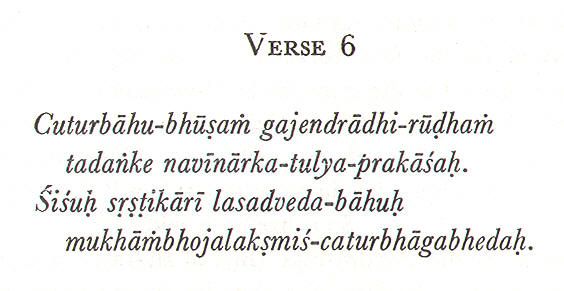
Cuturbāhu-bhūṣaṁ gajendrādhi-rūḍhaṁ
tadaṅke navīnārka-tulya-prakāśaḥ.
śiśuḥ sṛṣṭkārī lasadveda-bāhuḥ
mukhāṁbhojalakṣmiś-caturbhāgabhedaḥ.
Ornamented with four arms and mounted on the King of Elephants, He carries on his lap the child Creator, resplendent like the young Sun, who has four lustrous arms, and the wealth of whose lotus-face is four-fold.
Cuturbāhu-bhūṣaṁ gajendrādhi-rūḍhaṁ = Ornamented with four arms and mounted on the king of elephants. tadaṅke navīnārka-tulya-prakāśaḥ. = on his lap (of Dhara Bija) resplendant like the young sun. śiśuḥ sṛṣṭkārī = the child creator = Brahma. lasad-veda-bāhuḥ = glowing four arms. Veda = Vedas or four (as in four Vedas). mukhāṁbhojalakṣmiś-caturbhāgabhedaḥ. = The bounty of whose lotus-face is fourfold. By this is meant the four-faced Brahma. here some replace Bhedah with Veda meaning that Vedas emanated from the four lotus-faces of Brahma.
Dhara Bija (Earth Bija Mantra) is in Muladhara and Creator Brahma dwells in its Bindu which is above Nada. The king of Immortals, Indra, is seated on the elephant.
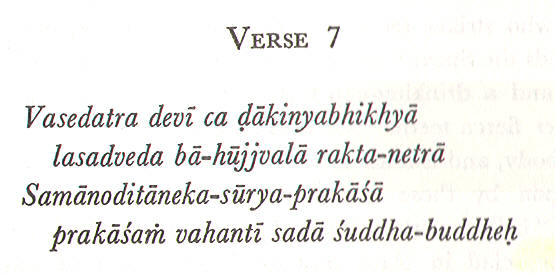
Vasedatra devī ca ḍākinyabhikhyā
lasadeva bā-hūjjvalā rakta-netrā
Samānoditāneka-sūrya-prakāśā
prakāśaṁ vahantī sadā śuddha-buddheḥ
Here dwells the Devi Dakini by name; her four arms shine with beauty, and her eyes are brilliant red. She is resplendent like the lustre of many Suns rising at one and the same time. She is the carrier of the revelation of the ever-pure Intelligence.
Vasedatra devī ca ḍākinyabhikhyā lasadeva bā-hūjjvalā rakta-netrā = Here dwells the Devi Dakini by name; her four arms shine with beauty, and her eyes are brilliant red. Samānoditāneka-sūrya-prakāśā = resplendent like the lustre of many Suns rising at one and the same time. prakāśaṁ vahantī sadā śuddha-buddheḥ = She is the carrier of the revelation of the ever-pure Intelligence.
Dakini Sakti, the presiding deity, is in Adhara or Muladhara Chakra and enables the Yogi to acquire knowledge of the Tattva (Tattva Jnana). Dakini is the queen of Muladhara Chakra and also the door keeper. Dakini, Rakini, Kakini, Lakini, Sakini and Hakini (all named after the initial Sanskrit letters, Da, Ra etc) are the queens of the respective Chakras.
Meditation of Dakini is as follows: Meditate on her, the red-eyed Dakini, in the Muladhara, who strikes terror in the hearts of Pasus, who holds in her two right hands the spear and the khatvanga and in her two left hands the sword and a drinking-cup filled with wine. She is of fierce temper and shows her fierce teeth. She crushes the whole host of enemies. She is plump of body, and is fond of Payasanna. It is thus that she should be meditated upon by those who desire immortality.
She has Tilaka, forehead mark of vermilion, and eyes ornamented with collyrium, is clad in black antelope skin and decked with varied jewels.
khatvanga = A staff with human skull at the upper end. Pasus = The unillumined ones. sword = used in sacrifice of animals. Payasanna = a kind of milk pudding with boiled milk, rice, butter, sugar, raisins, saffron. Tilaka is the red vermilion mark worn on the forehead to indicate their life with a living husband.
The lotus is turned up in the path of renunciation (Nivrrti Marga) and return to Para Brahman and turned down in life of action (Pravrrti Marga), as said by Siva to Parvati.
We as earthlings are on the Pravrrti Marga, the path of Evolution, a path away from the Supreme Consciousness. We are afflicted with impurities (mummalam: three impurities, Anava, Maya and Kanma Malams. more on them at: Primer in Saiva Siddhanta. Those on Nivrrti Marga are making the centripetal journey towards the Supreme Consciousness and merge with Him. The are devoid of impurities.

Vajrākhyā viaktradeśe vlasati satataṁ karṇikā-madhyasaṁsṭhaṁ
koṇaṁ tat traipurākhyaṁ taḍidiva vilasat-komalaṁ kāmarūpam
kandarpo nāma vayur nivasati satataṁ tasya madhye samantāt
jīveśo bandhu-jīva-prakaramabhί-hasan koṭisūrya-prakāśaḥ
Near the mouth of the Nadi called Vajra, and in the pericap (of the Adhara Lotus), there constantly shines the beautifully luminous and soft, lightening-like triangle which is Karmarupa, and known as Traipura. There is always and everywhere the Vayu called Kandarpa, who is of a deeper red than the Bandhujiva flower, and is the Lord of Beings and resplendent like ten million suns. www.bhagavadgitausa.com/Sat-Chakra-Nirupana-Kundalini Chakras.htm
The Triangle of Mulachakra in the pericarp is described. The triangle according to Visvanatha and Gautamiya Tantra is Iccha-Jnana-Kriyatmaka (the powers of the Will, Knowledge, and Action). The Triangle is the charming Sakti Pitha, above DharA-Bija. The three lines are VAmA, JyestA and Raudri. TANTRA7.gif shows the triangle under the verse 37.
Vajrākhyā viaktradeśe = near the mouth of the Nadi called Vajra. koṇaṁ tat traipurākhyaṁ = Triangle is so called because of the presence of Devi Traipura within the Ka inside the Triangle, the latter ka is the chief letter of KAma Bija. Tantraraja Siva says to Devi, 'the letter Ka is thy form.' Thus Kam is the Bija of KAmini adn Klim is the Mantra. Go to TANTRA to see the Triangle.
This Muladhara Triangle is the Sthula (gross) aspect of Suksma (subtle) Kamaraja Triangle in Sahasrara Chakra. presentation: Veeraswamy Krishnaraj
komala = soft = oily and smooth. kāmarūpam = that by which KAma is caused to be felt. It is the embodiment of the devotee's desire. It is MadanAgArAtmaka meaning Chamber of Madana (Deva of Love)--the Yoni. kandarpa = This is the Kandarpa-Vayu in the Triangle. jīveśa = Lord of Beings. Continuation of Life is dependent on kAma or Kandarpa-Vayu. Vayu = air. PrAna dwells in the heart; ApAna in the anus; Kandarpa-VAyu is part of the ApAna-VAyu. ApAna and PrAna draw each other, thus preventing each other from leaving the body. When they are in accord, they leave the body. Kandarpa, being part of ApAna is the Lord of Life and prevents the PrAna from leaving the body. PrAna and ApAna are the maintainers of animate being. koṭisūrya-prakāśaḥ = resplendent like ten million suns. Go to BG04 for description of Airs or Vayus.
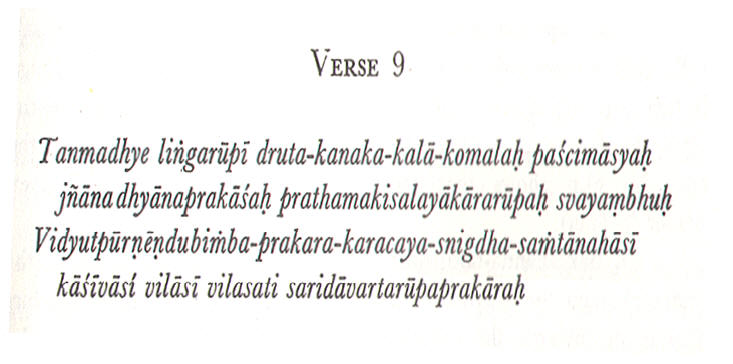
Tanmadhye lingarūpī druta-kanaka-kalā-komalaḥ paścimāsyah
Jñāna dhyānaprakāsaḥ prathamakisalayākārarūpaḥ svayṃbhuḥ
Vidyupūrṇēṇdubimba-prakara-karacaya-snigdha-saṁtānahāsī
Kāsīvāsī vilāsī vilasati saridāvartarūpaprakāraḥ
Inside it (the triangle) is Svayambhhu in His Linga-form, beautiful like molten gold, with His head downwards. He is revealed by Knowledge and Meditation, and is of the shape and colour of a new leaf. As the cool rays of lightening and of the full moon charm, so does His beauty. The Deva who resides happily here as in Kasi is in forms like a whirlpool.
Svayambhhu = Self-originated, Self-existent. Siva-Linga's other name. Svayambhu is both Parabrahman and SabdaBrahman meaning by Jnana we realize His attributelessness (Brahman) and by DhyAna the attributefulness (Isvara).
There are two kinds of Brahmans: ParamBrahman and SabdaBrahman (Supreme Brahman with no attributes and Sound Brahman who is the creator of the universe. Parabrahman gives rise to Sabda or Soundbrahman (Bindu, Kundalini) which is the origin of sounds, alphabets, syllables, words, prose, poetry and the universe of beings and matter. By Spiritual Knowledge we apprehend Parabrahman and by meditation the Sabdabrahman or Isvara. Simply put, we all originated from thought, sound and word of Sabdabrahman or God (logos).
Tanmadhye lingarūpī svayṃbhu = Inside it (the triangle) is Svayambhhu in His Linga-form. druta-kanaka-kalā-komalaḥ = His body has the soft luster of molten gold. paścimāsyah = His head downwards. The ever-blissful Svayambhu being inactive has his head down, ready to be moved by KAma-Bija. Jñāna- dhyāna-prakāsaḥ = Revealed by Knowledge and Meditation. prathama-kisalayā-kāra-rūpaḥ = The shape and color of new leaves. This refers to the Svayambhu Linga like the tapering shape of the new unopened leaf-bud. (He is beautiful and blue-green Siva --Sivam-SyAmala-Sundaram. Vidyut-pūrṇēṇdu-bimba-prakara-karacaya-snigdha-saṁtāna-hāsī = As the cool rays of lightning and of the full moon charm, so does His beauty. Kāsīvāsī vilāsī = The Deva who resides happily here as in KAsi. sarid-āvarta-rūpa-prakāraḥ = Like a whirlpool (Whirlpool is the depression on the top of the Linga.
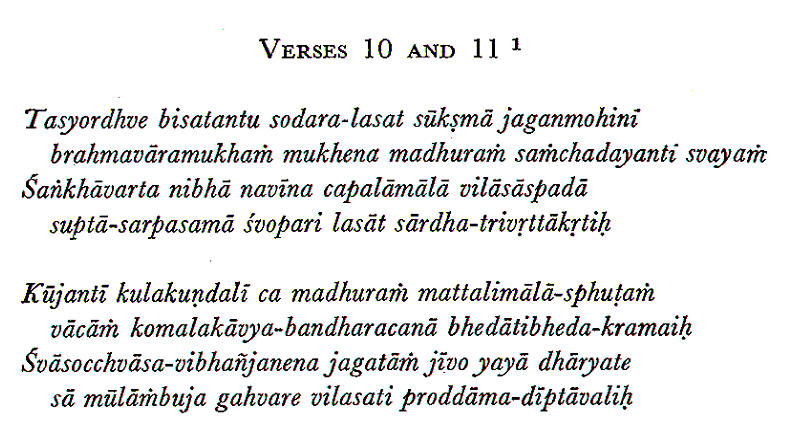
10. Tasyordhve bisatantu sodara-lasat sūkṣmā jaganmohini
brahmavāramukhaṁ mukhena madhuraṁ saṁchadayanti svayaṁ
śakāvarta nibhā navīna capalāmālā vilāsāspadā
suptā-sarpasaṁā śvopari lasāt sārdha-trivṛttākṛtiḥ
11. Kūjantī kulakuņdalī ca madhuraṁ mattalimālā-sphuṭaṁ
vācāṁ komalakāvya-bandaracanā bhdātibheda-kramaiḥ
śvāsocchvāsa-vibhañjanena jagatāṁ jīvo yayā dhāryate
sā mūlāmbuja gahvare vilasati proddāma-dīptāvaliḥ
Over it shines the sleeping Kundalini, fine as the fibre of the lotus-stalk. She is the world-bewilderer, gently covering the mouth of Brahma-dvara by Her own. Like the spiral of the conch-shell, Her shining snake-like form goes three and a half times round Siva, and Her lustre is as that of a strong flash of young strong lightning. Her sweet murmur is like the indistinct hum of swarms of love-mad bees. She produces melodious poetry and Bandha and all other compositions in prose or verse in sequence or otherwise in Samskrta, Prakrta and other languages. It is she who maintains all beings of the world by means of inspiration and expiration, and shines in the cavity of the root (Mula) Lotus like a chain of brilliant lights.
Purport: Kundlini Sakti is in the Svayambhu-Linga. Devi-Kundalini maintains the existence of individual beings (Jiva and Jivatma) by functions of inspiration and expiration. She makes the sound of humming bees and is the source of speech. She dwells in the triangular hollow in the pericarp of the Muladhara Lotus resting on the svayambhu-Linga. Over it shines the sleeping Kundalini and Her shining snake-like form goes three and a half times round Siva = She as the snake wraps around the Linga three and half times and over it with Her head. world-bewilderer = Siva says, "This Supreme Sakti is in me, and is Brahman Itself. This MAyA is dear to Me, by which this world is bewildered." Her sweet murmur is like the indistinct hum of swarms of love-mad bees = When She is awakened She makes this sound. This indicates, according to Sankara, the Vaikhari state of Sound (Articulated sound). Go to Sabda or Sound for full description of Sound. melodious poetry and Bandha = The composition of the verse (s) is arranged to look alike a diagram or picture, example: A lotus (padma-Bandha), a horse (Asva-Bandha), Pictorial appearance of the verse. inspiration and expiration, = It is said that man makes 21600 cycles of inspiration and expiration. Without Her, there is no breathing.
10. Tasyordhve bisatantu sodara-lasat sūkṣmā jaganmohini ---Verse 10 line 1
brahmavāramukhaṁ mukhena madhuraṁ saṁchadayanti svayaṁ ---Verse 10 line 2
śakāvarta nibhā navīna capalāmālā vilāsāspadā ---Verse 10 line 3
suptā-sarpasaṁā śvopari lasāt sārdha-trivṛttākṛtiḥ ---Verse 10 line 4
vācāṁ komalakāvya-bandaracanā bhdātibheda-kramaiḥ Verse 11 line 2
bisatantu sodara-lasat sūkṣmā = Shines fine as the fibers of the lotus stalk. jaganmohini = World-bewilderer. madhuraṁ = Sweet. She drinks the nectar coming by the sweet Brahma-dvara. navīna- capalā-mālā vilāsāspadā = A strong flash of young lightning. Lit., 'possessed of the wealth of a strong flash of young lightning.' komala-kāvya-banda-racanā-bhdātibheda-krama = She produces melodious poetry.
Devi Kundalini is Srsti-rupa meaning she is of the form of Creation itself. She is Srsti-Stithi-layatmika meaning She is Creation, Existence and Dissolution. She is VisvAtitA meaning She is beyond the universe; She is Immanent and trascends the universe. She is Jnana-Rupa meaning She is of the form of Consciousness. She is Urddhva-VAhini meaning She goes upwards from Muladhara to Sahasrara Chakras. She is Ista-Deva-SvarUpini, meaning that She is meditated upon as The Particular Devata. "She is a damsel of sixteen in the full bloom of Her first youth, with very large and beautifully formed breasts, decked with all the varied kinds of jewels, lustrous as the full moon, red in color, with restless eyes." Kundalini is always meditated upon as red (RaktA) in color. She is SyAma, a woman who is warm in winter and cool in summer and lustrous like the molten gold. Before she pierces the Chakras, She, the Brahman Itself, is resplendent like million of moons rising at the same time and has four arms and three eyes. Her hands make the Vara and Abhaya Mudras (Granting Boons and Fear-Not Pose of hands), and hold a book and a Vina--musical instrument. She sits on a lion and as She passes to Her own abode (Muladhara Chakra) the Awe-inspiring One assumes different forms.
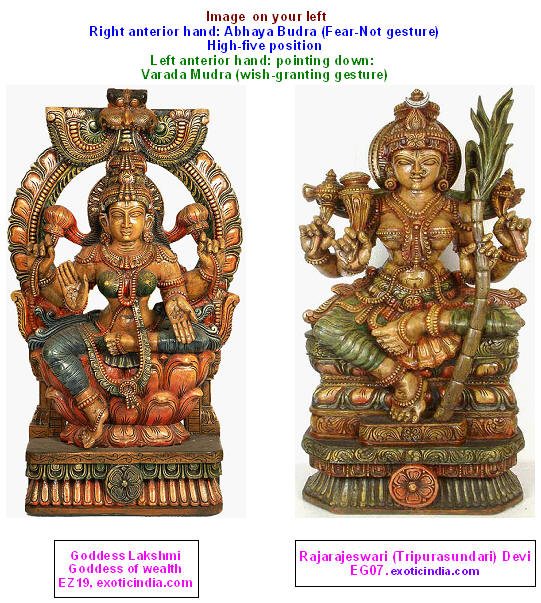
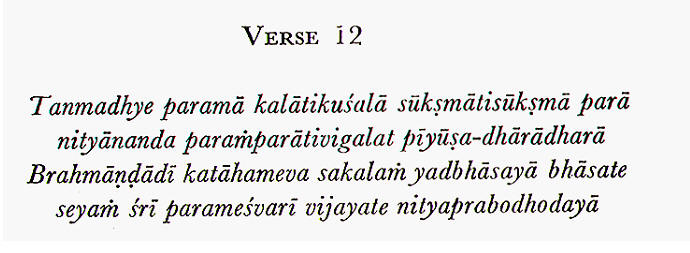
Tanmadhye paramā kalātikuśalā sūkṣmātisūkṣmā parā
Nityānada paraṁparātivigalat pīyūṣa-dhārādharā
Brahmāņḍādī katāhameva sakalaṁ yadbhāsayā bhāsate
seyaṁ śrī parameśvarī vijayate nityaprabhodhodayā
Within it reigns dominant Para, the Sri-Paramesvari, the Awakener of eternal knowledge. She is the Omnipotent Kala who is wonderfully skilful to create, and is subtler than the subtlest. She is the receptacle of that continuous stream of ambrosia which flows from the Eternal Bliss. By Her radiance it is that the whole of this Universe and this Cauldron is illumined. presentation: Veeraswamy Krishnaraj
Within it = Within Svayambhu-Linga. Para = AKA: Kundalini, Brahmani. In Kundalini is the ParA state of Sabda or sound.
Verse: KalA: Cit-KalA is Devi who is Consciousness-Brahman and its part or fragment is resident in the mind of humans; human consciousness is derived from Cit-KalA; so She is Cit-KalA. It is the Brahman-Consciousness, a fragment of which is incorporated in the human mind, which cannot function without Cit-KalA. In Bhagavad-Gita Bhagavan says: 15.7: A fragment of My own Self becomes the eternal living soul in this world of Jivatmas and draws the senses of material nature (Prakrti), of which the mind is the sixth. Cit-kalA unites with Lakshmi and appears as a tapering flame. To relinquish all sins, meditate upon Kundalini within, above, below the flame as Brahma, Siva, SUra (Sun) and Paramesvara; Vishnu, Prana, KAlAgni (The destructive Fire at Dissolution) and Chandra (moon). atikuśalā = She is wonderfully skilful to create. Nityānada paraṁparātivigalat pīyūṣa-dhārādharā = She is the receptacle of that continuous stream of Ambrosia flowing from Eternal Bliss (Brahman). Nityananda = Eternal Bliss = Nirguna Brahman = Attributeless Brahman = Unqualified Brahman. Parampara = linear descent (connected step by step) as follows: Nirguna-Brahman→ Saguna-Brahman→ Sakti → NAda → Bindu → Kundalini. Cit-KalA is another form of Kundalini. The Ambrosia trickles down step by step to Paramesvari AKA CitkalA, who is Nityananda-Parampara, a descendant of the original Nirguna-Brahman. Another way of looking at this flow of Ambrosia. From Nityananda, this nectar comes down to Para-Bindu, passes through Ajna Chakra, Visuddhar Chakra, Anahata, Manipura, Svadhistana, and reaches Muladhara. ativigalat pīyūṣa-dhārādharā = She is the receptacle of the stream of Ambrosia which flows copiously from Nityananda.
Cauldron = Cauldron shape of the lower half of Brahmanda (Brahma's egg =Universe).
Swami Paramananda talks about the Staff-like Para-Sakti, who is like a straight thread above Kundalini, who is coiled round Svayambhu-Ling. Sri-Paramesvari, whose radiance illumines this Universe and its cauldron, dwells in the Svayambhu-Linga above where Kundalini is coiled and holds supreme sway.
paramā = Omnipotent. She is Supreme MAyA. kalā = is a form of NAda-Sakti.

Dhyātvaitan-mūlacakrāntaravivaralasatkoṭisūryaprakāśāṁ
Vācāmēśo narendrah sa bhavati sahasā sarvavidyāvinodī
Ārogyaṁ tasya nityaṁ niravadhi ca mahānandaittāntarātmā
Vākyaiḥ kāvyaprabandhaiḥ sakalasuragurūn sevate śuddhaśilaḥ.
By meditating thus on Her who shines within the Mula-Cakra, with the lustre of ten million Suns, a man becomes Lord of speech and King among men, and an Adept in all kinds of learning. He becomes ever free from all diseases, and his inmost Spirit becomes full of great gladness. Pure of disposition by his deep and musical words, he serves the foremost of the Devas.
Mula-Cakra = Root Chakra = Muladhara Chakra.
mūla-cakra antara-vivara-lasat-koṭisūrya-prakāśāṁ = She shines in the Muladhara Chakra like ten million suns shining at one and the same time. Vākyaiḥ kāvya-prabandhaiḥ = His deep and musical words. sevate = He serves. He uses his words in hymns of praise and for purpose of a like nature. He pleases them by words of adoration. sakala-sura-gurūn = all-devas-guru-like excellence. All the foremost of the Deities. Sura-Gurun refers to Brahma, Vishnu, and Siva, the Trinity of Hinduism. GurUn like Simha (lion), SArdUla (Tiger), NAga (serpent) are appended to male names to imply excellence. Example: He is lion of a man.
Summary: Muladhara is a Lotus of four red petals having on them gold letters Va, Śa, Ṣa, Sa. In the Pericarp is the DharA-mandala with eight spears and in the lower part is the DharA-Bija (Lam) who has four arms and is seated on the elephant Airavata. He is yellow, and holds Vajra (thunderbolt) in his hands. Inside the Bindu of DharA-Bija is the four-faced child Brahma, who is red in color, and has four hands with Danda (staff), Kamandalu (gourd), Rudraksa rosary and Abhaya-Mudra (Fear-not pose). In the pericarp besides Brahma there is a red lotus on which is seated red-colored, four-armed Sakti DAkini, the presiding deity of the Chakra (ChakrAdhisthAtrI), holding SUla (spear), KhatvAnga (skull-mounted staff), Khadga (sword), and Casaka (drinking-cup). In the pericarp, there is lightning-like triangle, inside which are kAma-VAyu and KAma-Bija, both of which are red. Above this is the Svayambhu-Linga which is SyAma-Varna (black color) and above and round this Linga is Kundalini coiled three and half times, and above this last upstands, on the top of the Linga, CitkalA.
![]()
SVADHISTHANA
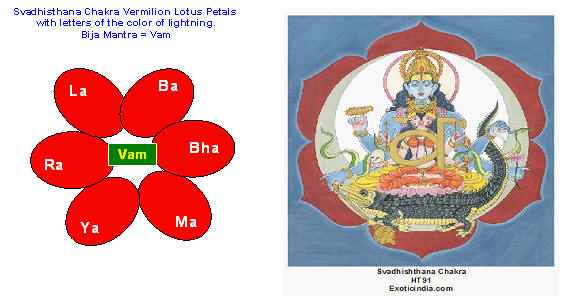
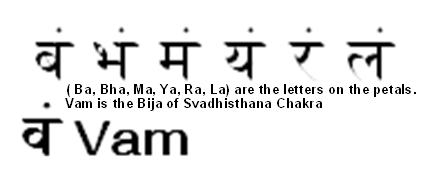
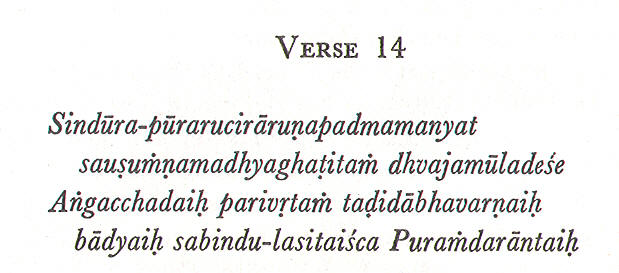
(Svadhisthana)
Sindūra-pūrarucirāruņapadmamanyat
sauṣuṁņamadhyaghaṭitaṁ dhvajamūladeśe
Aṅgacchadaiḥ parivṛtaṁ taḍidābhavarņaiḥ
bādyaiḥ sabindu-lasitaiśca Puraṁdarāntaiḥ
There is another Lotus1 placed inside the Susumna at the root of the genitals, of a beautiful vermilion colour. On its six petals are the letters from Ba to Puramdara2, with the Bindu3 superposed, of the shining colour of lightening. presentation: Veeraswamy Krishnaraj
another Lotus1 = Svadhisthana Chakra. Puramdara2 = the letter La. Bindu3 = The AnusvAra.
Svadhisthana: The place of Sva, meaning Para-Linga, or Supreme Linga. This is the seat of Supreme Linga.
Five verses from 14 to 18 describes Svadhisthana Chakra of vermilion color. www.bhagavadgitausa.com/Sat-Chakra-Nirupana-Kundalini Chakras.htm
Sindūra-pūra-rucirā-ruņa = Of a beautiful vermilion color. sauṣuṁņa-madhya-ghaṭitaṁ = Placed inside the Susumna. Svadhisthana Chakra is within Susumna NAdi. dhvaja-mūladeśe = At the root of the genitals. Aṅga-chadaiḥ = On its six petals. bādyaiḥ sabindu-lasitaiśca Puraṁdarāntaiḥ = The letter La, being the Bija of Puramdara or Indra. The lustrous letters Ba, Bha, Ma, Ya, Ra, La are the six letters, one placed on each of the six Lotus petals.
Susumna = means that Susumna Nadi has three tubes one within the other. The central Nadi or channel is Brahma Nadi, within which is the Svadhisthana Lotus.
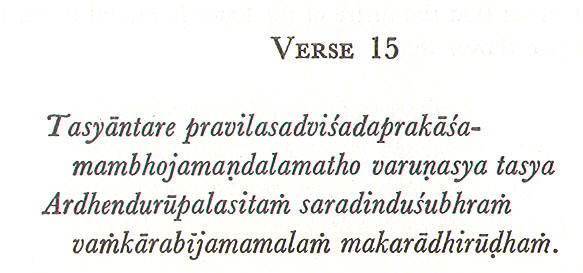
(Svadhisthana)
Tasyāntre pravilasadviśadaprakāśa-
mambhojamaņdalamatho varuņasya tasya
Ardhendurūpalasitaṁ saradinduśubhraṁ
vaṁkārabijamamalaṁ makarādhirūḍhaṁ.
Within it1 is the white, shining,
watery region of Varuna, of the shape of a half-moon2, and therein,
seated on a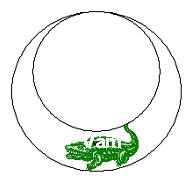 Makara3, is the Bija Vam, stainless and white as the autumnal moon.
Makara3, is the Bija Vam, stainless and white as the autumnal moon.
Within it1 = Within Svadhisthana Lotus Chakra. half-moon2 = Half-moon is the sign of Svadhisthana Chakra and water is the element of this chakra. Makara3 = A legendary animal as seen on the plate.
ambhojamaņdalam = The pericarp of the Svadhisthana Lotus Chakra contains the watery region (Ambhoja Mandalam) of Varuna. Ardhendurūpalasitaṁ = half-moon form shining. viśadaprakāśam = luminously white.
Varuna Bija is white and sits on Makara, the carrier of noose-holding Varuna. Above Varuna is four-armed and blue-colored Hari (Vishnu), worthy of worship. The letter Va in Vruna-Bija belongs to the semivowel group, Ya, Ra, La, Va.
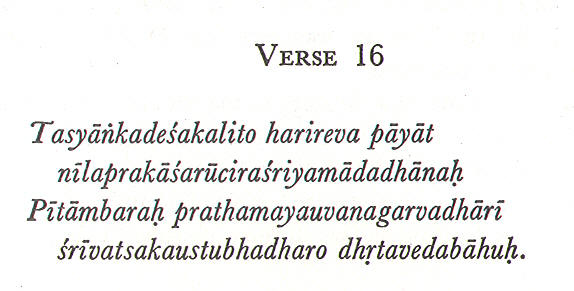
(Svadhisthana)
Tasyānkadeśakalito harireva pāyāt
nīlaprākasaruciraśriyādadhānaḥ
Pītāmbaraḥ prathamayauvanagarvadhārī
śrīvatsakaustubhadharo dhṛtavedabāhuḥ.
May Hari, who is within it1, who is in the pride of early youth, whose body is of luminous blue beautiful to behold, who is dressed in yellow raiment, is four armed and wears the Sri-vatsa2, and the Kaustubha3, protect us!
May Hari, who is within it1 = This verse tells that Vishnu is the Varuna-Bija. Vishnu is within the lap of the Bindu of VAm. Sri-vatsa2 = the favorite of Sri or Lakshmi. This is the auspicious curl of hair on the chest of Vishnu and His Avatara Krishna. It symbolizes Prakrti (the world of matter). Kaustubha3 = The gem worn by Vishnu symbolizes the souls that are united with the Kaustubha gem.
anka-deśa-kalita = Within it. In the Bindu above Varuna-Bija, in the same way as Brahma is in the lap of DharA-BijA (Earth Bija) in Muladhara Chakra. nīla-prākasa-rucira-śriyam = Blue effulgence lustrous splendor. He possesses the enchanting beauty of His blue effulgence. His luminous effulgent blue body (Vishnu) is beautiful to behold. śrīvatsakaustubha = (Vishnu wears) Srivatsa and Kaustubha gem. The gem shines like ten thousand gems; His VanamAla (garland of forest flowers) shines like ten thousand moons. The Srivatsa curl of hair on His right chest shines like ten thousand moons. All these are chanted in eulogizing Vishnu. Meditate on dark-blue Hari (Vishnu) wearing Pitambara (yellow garment) holds the Conch, Discus, Mace and Lotus in His four hands. VanamAla (garland of forest flowers = All-season Forest flower garland of many colors and hues comes down to the level of Vishnu's knees and has in it Kadamba flowers in the middle. The garland symbolizes the elements, Earth, Water, Fire. Air and Ether. prathama-yauvana-garvadhārī : Of prime youth, proud Vishnu.
Vishnu's weapons: Mace or Club symbolizes Mahat (Adi-Buddhi, Universal Intelligence, Divine Mind, Cosmic Intellect, Nous-Greek, Radiation from the Universal Absolute). the Conch: Sattvic Ahamkara. Virtuous self-illumined I-doer. Sattva = Virtue, illumination, enlightening Knowledge. Ahamkara = I-doer, the Universal Ego of Vishnu. The bow = symbolizes Tamasic Ahamkara meaning absorption of the universe. Tamas = darkness. The Sword: Divine Knowledge. Its Sheath: ignorance. Discus: the mind. the arrows: the senses.
In Muladhara, Brahma sits on his transport (Vahana) Hamsa and here Vishnu flies on Garuda ( a mythical bird appearing like an Eagle.
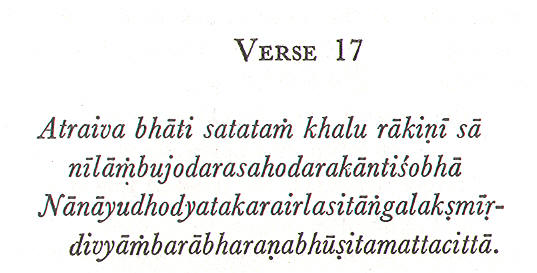 (Svadhisthana)
(Svadhisthana)
Atraiva bhāti satataṁ khalu rākiņī sā
nīlāṁbujodarsahodarakāntiśobhā
Nānāyudhodyatakarairlasitāṅgalakṣmīṛ-
divyāṁbarābharaņabhūṣitaattacittā
kundal190.jpg
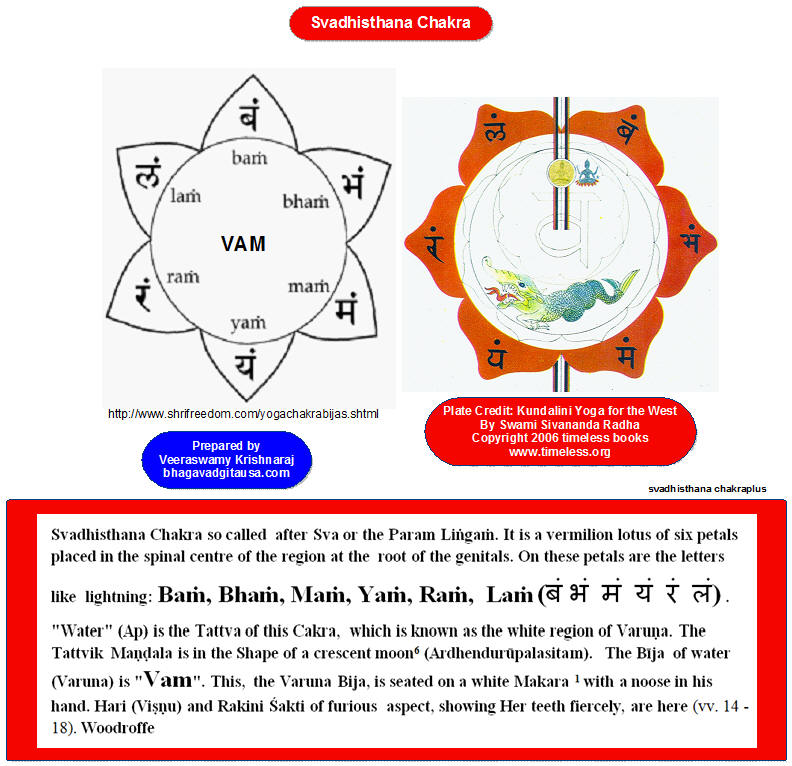
It is here that Rakini always dwells1. She is of the colour of a blue lotus. The beauty of Her body is enhanced by Her uplifted arms holding various weapons. She is dressed in celestial raiment and ornaments, and Her mind is exalted with the drinking of ambrosia.
Rakini always dwells1 = Rakini shines (bhāti) here in Svadhisthana Chakra.
nīlāṁbujodarsahodarakāntiśobhā = Her radiant beauty equals the interior of the blue lotus.
Rakini is the resident Devi of Svadhistana Chakra sitting on the double lotus with a streak of blood running from her nostrils. Meditate of blue-colored Rakini with red eyes and fierce teeth. She is the furious aspect and holds in Her hands a spear, a lotus, a drum, and a battle-axe. She grants wished-for boons and is fond of rice.

(Svadhisthana)
Svādhiṣṭhānākhyametatsarasijamamalaṁ cintayedyomanusya-
stasyāhaṁkāradoṣādiksakalarepuḥ kṣīyate tatkṣaņena
yogīśaḥsoऽpiṃohādbhutatimiracayebhānutulyaprakāśo
gadyaih padyaiḥ parabhandhairviracayati sudhāvākyasandoha lakṣmiḥ
He who meditates upon this stainless Lotus, which is named Svadisthana, is freed immediately from all his enemies, such as the fault of Aha kara and so forth. He becomes a Lord among Yogis, and is like the Sun illumining the dense darkness of ignorance. The wealth of his nectar-like words flows in prose and verse in well-reasoned discourse.
enemies = Enemies of six passions: KAma = Lust. Lobha = Greed. Moha = delusion. Mada = pride. MAtsaryya = envy. All these six enemies arise from Ahamkara, a sense of mineness. kara = Egoism.
The benefits from contemplation of Svadhisthana Lotus Chakra are described.
Ahaṁkāra-doṣādi: the Ahamkara fault and so forth. See above for the six evil predispositions. These six ennemies are destroyed by contemplating on Svadhisthana Lotus Chakra. The darkness of MAyA and MohA are destroyed.
Summary of Verses 14 to 18: Svadhisthana Lotus Chakra of vermilion color has six letters (Ba, Bha, Ma, Ya, Ra, La) of the color of lightning placed on the petals. In the pericarp of the Main Lotus there is a white region with second 8-petalled Lotus with half-moon in its center. Inside this region is the Varuna-Bija, VAM seated on Makara with a noose on hand. In the hollow of Bindu is Vishnu sitting on Garuda holding in His four hands the Conch, the Discus, the Mace, and the Lotus. Vishnu, of youth and pride, wears yellow raiment, a garland of forest flowers, the mark of Srivatsa on His chest and a gem Kaustubha on His breast. Fierce looking Sakti Rakini with three eyes, projecting fangs, and bleeding nostrils, sits in the pericarp of the red lotus, is of syAma varna, holds in her four hands SUla, Abja, Damaru, and Tanaka (a spear, a lotus, a drum, and a battleaxe) and is fond of white rice.
kundal19ab.jpg
MANIPURA
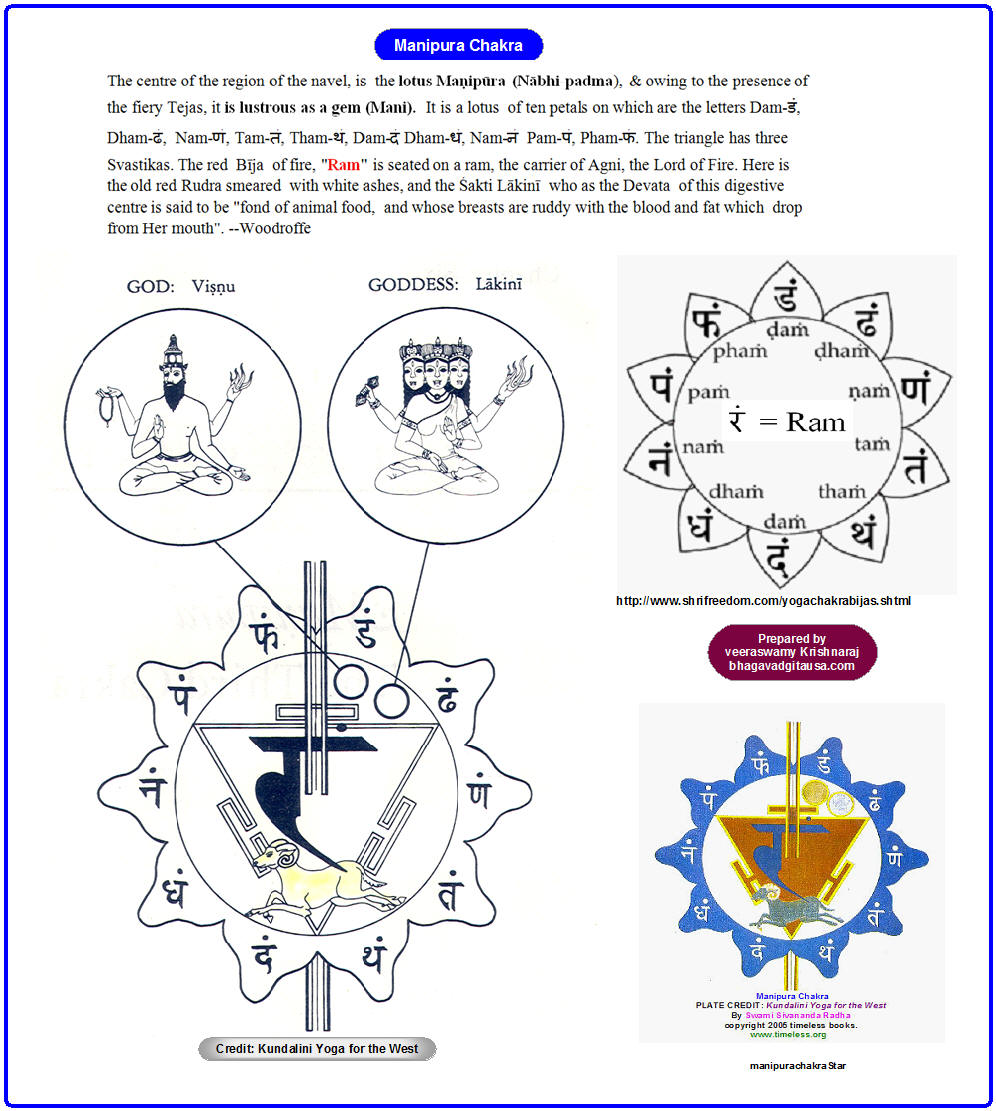
Serpen5.gif
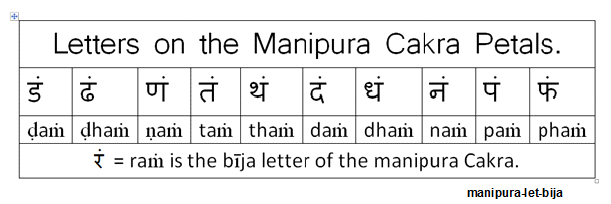

Tasyordhve nābhimūle daśadalalasite pūrṇameghaprakāśe
nīlāmbhojaprakāśairrupahitajaṭhare dādipāntaiḥ sacandraiḥ
Dhāyedvaisvānarauṇamihirasamaṁ maṇḍalam tat trikoṇaṁ
tadbāhye svastikāvyaistribhirabhilasitaṁ tatra vahneḥ svabījam.
Above it1, at the root of the navel, is the shining Lotus of ten petals2, of the colour of heavy-laden rain-clouds. Within it are the letters Da to Pha, of the colour of the blue lotus with the Nada and Bindu above them. Meditate there on the region of Fire, triangular in form and shining like the rising sun. Outside it are three Svastika marks3, and within, the Bija of Vahni himself4.
Above it1 = Above
Svadhisthana Lotus Chakra. the shining
Lotus of ten petals2 = The Manipura Chakra, the seat of the element of Fire, the
sign of which is a triangle. three Svastika marks3 = It is an
auspicious mark In the Indian context, the svastika stands for
universal welfare. "Swasti"
means well-being of one and all, "ka" means symbol. the Bija of Vahni
himself4. = Ram is the seed Mantra of Fire. Vahini =
Fire. 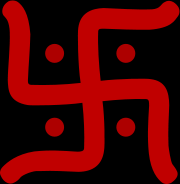
Svastika (Ansate Cross) is derived from the Sanskrit svastika (in Devanagari, स्वस्तिक), meaning any lucky or auspicious object, and in particular a mark made on persons and things to denote good luck. It is composed of su- (cognate with Greek ευ-, eu-), meaning "good, well" and asti, a verbal abstract to the root as "to be" (cognate with the Romance copula, coming ultimately from the Proto-Indo European root *h1es-); svasti thus means "well-being." The suffix -ka intensifies the verbal meaning or confers the sense of 'beneficial', and svastika might thus be translated literally as "that which associated with well-being," corresponding to "lucky charm" or "thing that is auspicious."[1] The word first appears in the Classical Sanskrit (in the Ramayana and Mahabharata epics)-Wikipedia.
Svastika sign is made by drawing a cross and then drawing lines that go in clockwise direction at 90º angles.
Dasa-dala-Lasite = Shining Lotus of ten petals. The Lotus shines by reason of its ten petals. Purna-megha-prakase: of the color of the heavy rain clouds. 2nd line. Nilambhoja-prakasair-upahita-jathare-dadi-phantaihsancandraih = the color of the blue lotus, the ten letters, Ḍa, Ḍha, Na, Ta, Tha, Da, Dha, Na, Pa, Pha on ten petals as seen in the diagram. Sacandraih = Moon dot. The letters have Bindu and NAda over them. Aruna-Mihira-Samam: like the young sun.
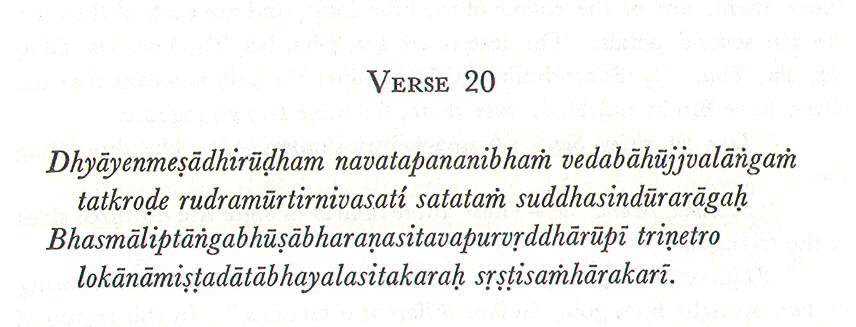
20.Dyāyenmeşādhirūdham navatapanaibhaṁ vedabāhūjvalāṇgaṁ
tatkroḍe rudramūrtiirnivasatī satataṁ suddhasindūrarāgaḥ
Bhasmāliptāṅgabhūşābharaṇasitavapurvṛddhārūpī triṇetro
lokānāmişṭadātābhayalsitakaraḥ sṛşṭstisaṁhārakarī.
Meditate upon him (Fire) seated on a ram, four-armed, radiant like the rising Sun. In his lap ever dwells Rudra, who is of a pure vermilion hue. He (Rudra) is white with the ashes with which he is smeared; of an ancient aspect and three-eyed. His hands are placed in the attitude of granting boons and dispelling fear1. He is the destroyer of creation.
granting boons and dispelling fear1 = the deities exhibit hand poses that give boons (Vara) and quell Fear (Abhaya Mudra)
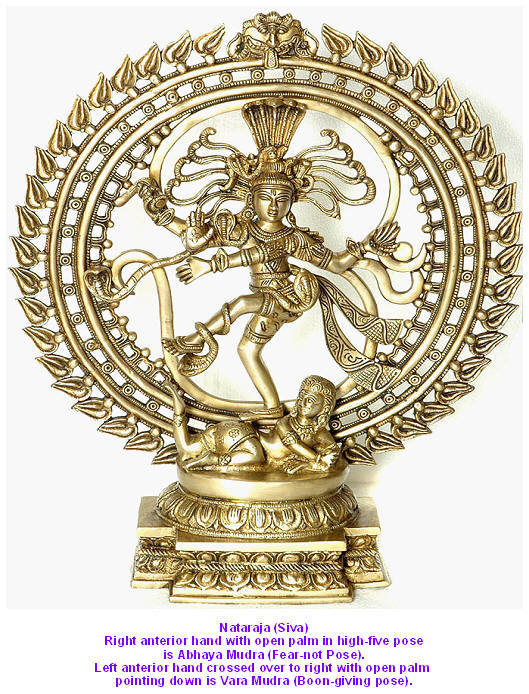
Meditation on Vahni (Fire): Seated on a ram, a Rudraksa rosary in one hand, and Sakti in the other. The other two hands holding no weapons grant boons and quell fear. Rudra is never meditated upon as seated on a bull.
Bhasmaliptanga-bhusabharana-sita-vapu = His body is smeared with ash; His ornaments makes Him look white, though he is of red hue.

21. Atrāste lākinī sā sakalaśubhakarī vedabāhūjjvalāṅgī
śyāmā pītāmbarādyairvividhaviracanālaṁkṛta mattacittā
Dhyātvaitannābhipadmaṁ parabhavati nitarāṁ saṁhṛtau pālane vā
vāṇī tasyānanābje nivasati satataṁ jñānasaṁdohalakşmiḥ.
Here abides Lakini, the benefactress of all. She is four-armed, of radiant body, is dark (of complexion), clothed in yellow raiment and decked with various ornaments, and exalted with the drinking of ambrosia. By meditating on this Navel Lotus the power to destroy and create (the world) is acquired. Vani with all the wealth of knowledge ever abides in the lotus of His face.
Vani = Sarasvati , Devi or Goddess of speech.
lakini = lakini is meditated upon as follows. Let the excellent worshipper meditate upon the Devi Lakini, who is blue and has three faces, and three eyes on each face, fierce aspect, and with the teeth protruding I. Her right hand She holds the thunderbolt and the Sakti (the weapon of Vahini (Fire) and in the left She makes gestures (mudra) of dispelling fear and of granting boons. She is in the pericarp of the navel Lotus with ten petals. She is fond of meat (Mamasi) and Her breast is ruddy with blood and fat which drop from Her mouth.
The navel lotus is called Mani-pura, the city of jewels because it is lustrous like a gem.
vividhaviracanālaṁkṛta = Decked with various ornaments. All her ornamets (pearsls and gems) are arranged in varied and beautiful designs.
Summary of Verses 19 to 21.
The Nabhi Padma--Navel Lotus--is rain-cloud-colored with ten lustrous blue petals having on them the letters: Ḍa, Ḍha, Na, Ta, Tha, Da, Dha, Na, Pa, Pha with Bindu above each of them. Triangular-shaped red region of Fire with Svastika signs on its three sides is in the pericarp, within which is the four-armed Bija of Fire, Ram, who is red in color, sits on a ram, holds in Hsi hands the Vajra (thunderbolt) and the Sakti weapon and makes signs of Vara and Abhaya. Rudra red in color sits on a bull on the lap of Vahni-Bija, is smeared with ash and appears old. Sakti Lakini sits on a red lotus in the pericarp. She is blue, four-armed, three-faced with three eyes on each face, holds the Vajra and Sakti weapons in her two hands and makes abhaya and Vara mudras with the other two hands. She is fierce with protruding teeth, is fond of eating cooke rice and dhal mixed with meat and blood. Here ends the third section.
ANAHATA
Serpen10.jpg
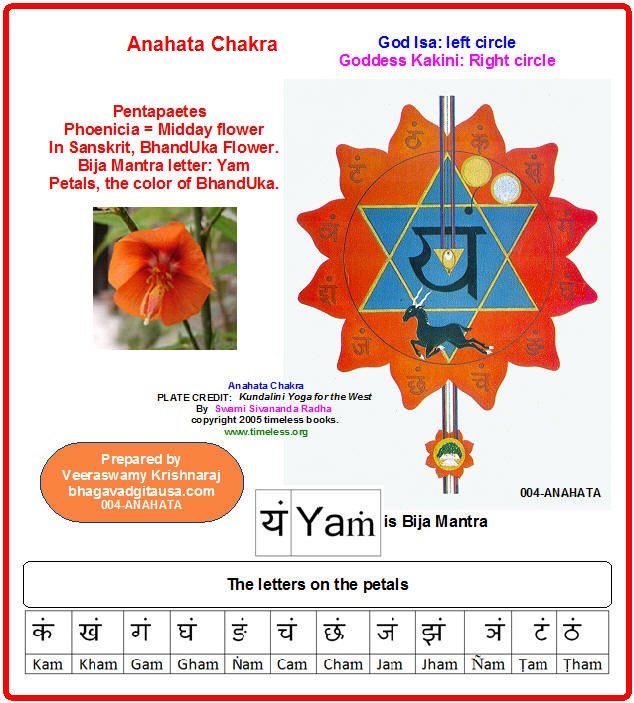
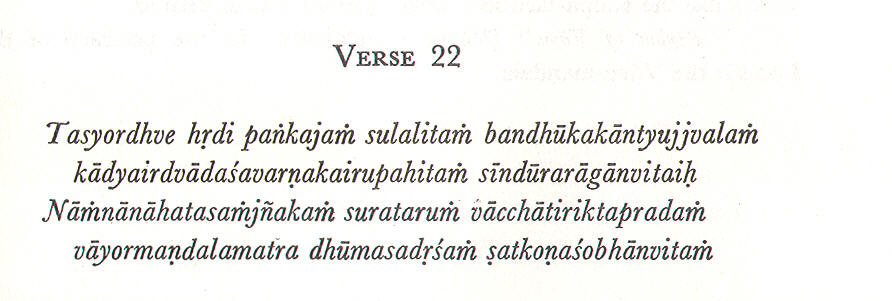
22. Tasyordhve hṛdi paṅkajaṁ sulalitaṁ bandhūkakantyujjvalaṁ
kādyairdvādaśavarṇakairupahitaṁ sīndūrarāganvitaiḥ
Nāṁnāṇāhatasamjñakaṁ surataruṁ vācchātiriktapradaṁ
vāyormaṇdalamatra dhūmasadṛśaṁ şatkoṇaśobhānvitaṁ
Above that, in the heart, is the charming Lotus, of the shining colour of the Bandhuka flower, with the twelve letters beginning with Ka, of the colour of vermilion, placed therein. It is known by the name of Anahata, and is like the celestial wishing-tree, bestowing even more than (the supplicant's) desire. The Region of Vayu, beautiful and with six corners, which is like unto the smoke in colour, is here. www.bhagavadgitausa.com/Sat-Chakra-Nirupana-Kundalini Chakras.htm
charming Lotus: Verses 22 to 27 describes Anahata Lotus Chakra, which is meditated upon in the heart. The 12 letters from Ka to Tha are on the petals: Ka, Kha, Ga, Gha, Ña, Ca, Cha, Ja, Jha, Na, Ṭa, Ṭha. wishing-tree = Kalpa-taru is a wish-tree in the garden (heaven) of the chief of gods Indra. It grants all that is wished for and Moksa (liberation). six corners = see the interlacing triangles with six corners (Sat-kona).
hṛdi paṅkajaṁ = Heart Lotus. dvādaśavarṇa= 20 letters. Nāṁnāṇāhata-samjñakaṁ: name Anahata it is known. Munis called the Lotus Anahata because they heard the sound of sabdabrahman in the Heart Lotus; it is Unstruck Sound, meaning that the sound is not produced by two clanging objects. vāyormaṇdalaṁ = Vayu Mandalam or Region of Air.
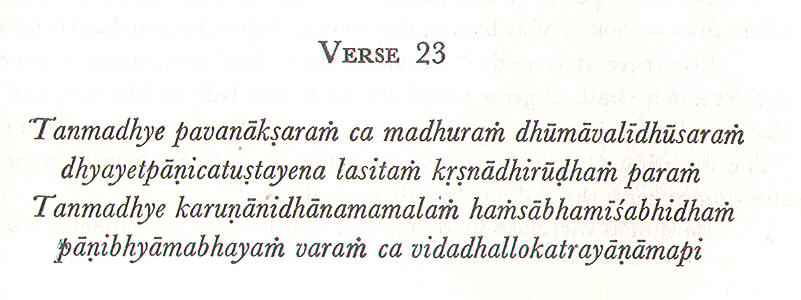
23. Tanmadhye pavanākşaraṁ ca madhuraṁ dhūmāvalīdhūsaraṁ
dhyayetpāṇicatuştayena lasitaṁ kṛşnādhirūḍhaṁ paraṁ
Tanmadhye karuṇānidnamamalaṁ haṁsābhamiśabhidhaṁ
pāṇibhyāmabhayaṁ varaṁ ca vidadhallokatrayāṇāmapi
Meditate within it on the sweet and excellent Pavana Bija, grey as a mass of smoke, with four arms, and seated on a black antelope. And within it also (meditate) upon the Abode of Mercy, the Stainless Lord who is lustrous like the Sun, and whose two hands make the gestures which grant boons and dispels the fears of three worlds. presentation: Veeraswamy Krishnaraj
Purnananda Svami says that VAyu Bija is in the Anahata Chakra. Pavana Bija = The Bija of Yam, grey as a mass of smoke. the Abode of Mercy = Sankara opines that it is a Ocean of Mercy (Kripa Sagar or KarunAvAridhi).Sun = Sun is Hamsa and also the name of the Supreme. Ham means motion. It is Aditya (sun) because it is perpetual motion (SAyana). Hamsa is also AntarAtmA (the Inner Atman or Soul, Paramatman). Hamsa is Mantra of every breath. This chantless Mantra pervades the breath going in and out, the subtle sound sah going in and the subtle sound ham going out. (Sa = Siva, Vishnu, Lakshmi, or Gauri [Parvati or Sakti]; Ham = I am; so = Parvati.} As one chants this subtle-sound Mantra soham, a derivative of sah-ham, Hamsa comes into being by inversion. Sa (Sah) is Sakti and Ha is Siva. Soham, Hamsa and AUM (Pranava) are equipotent. Hamsah is the union of male and female and the universe is Hamsah, according to Woodroffe. Tirumular says that AUM, though a three-letter word, is one-letter Mantra. Soham is the unintonated sound of normal breathing, meaning I am He. Hamsa, meaning Swan as in RamaKrishna Parma-Hamsa, stands for an ascetic --Hamsan. All of us including all air-breathing living beings recite this Mantra Soham unknowingly for a lifetime. This chantless Mantra (Ajapa Japa) is called Ajapa Gayatri. As you are breathing this chantless Soham in and out, you are identifying your individual self with the Great Self of the Supreme Being. Every breath (and the Mantra) that you take pervades the whole universe of your body. This life giving force or Mantra has the Great Self as the basis. two hands = Bija has hands and feet.
Verse Explanation: pavanākşaraṁ = the letter of Pavana (Air). It is Bija Yam. madhuraṁ = sweet and excellent. dhūmāvalīdhūsaraṁ = Dhuma is smoke. Grey as a mass of smoke.
The black antelope, known for its fleetness is the Vahana (carrier) of Vayu (Air), whose carries his Ankusa (goad) in the same way Varuna carries his PAsa (noose). Isa (Siva) is in Vayu Bija.
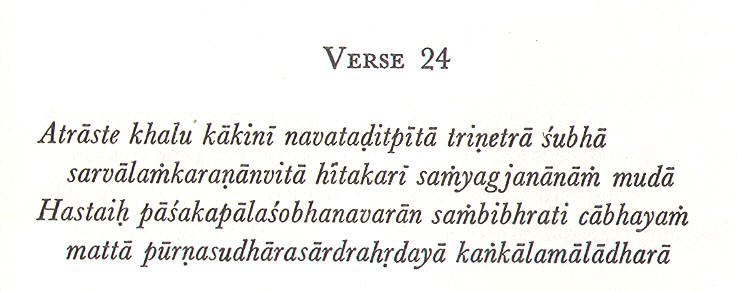
24. Atrāste khalu kākinī navataḍitpītā triṇetrā śubhā
sarvālaṁkaraṇānvitā hītakari saṁyagjnānāṁ mudā
hastaiḥ pāśakapālaśobhanavarān saṁbibhrati cābhyaṁ
mattā pūrṇasudhārasārdrahṛdayā kaṅkālamālādharā
Here dwells Kakini, who in colour is yellow like unto new lightning, exhilarated and auspicious; three-eyed and the benefactress of all. She wears all kinds of ornaments, and in Her four hands She carries the noose and the skull, and makes the sign of blessing and the sign which dispels fear. Her heart is softened with the drinking of nectar.
Pandit Purnananda Svami says that there is Sakti Kakini in Anahata Chakra. mattā = exhilarated. Kakini is exhilarated. pūrṇasudhārasārdrahṛdayā = Totally Pure nectar softens her heart. The nectar flows from Sahasrara Chakra. She wears the skin of a black antelope.
Meditate on Kakini, who is in the Fat holding in her hands a noose (PAsa), trident (SUla), skull (KapAl), Drum (Damaru). She with a bending pose, is of yellow complexion, likes to eat Dadhy-anna (curd and rice) drink VAruni (Rice wine). The Seven Saktis or Yoginis have each an abode in one of the Dhatus (layer, stratum, constituent part , ingredient): chyle , blood , flesh , fat , bone , marrow , semen of which sometimes 10 are given , the above 7 and hair , skin , sinews (tendon).

25. Etannīrajakarṇikāntaralasacchaktistrikoṇābhidha
vidyutkotisamānakomalavapuḥ sāste tadantargataḥ
Baṇākhyaḥ śivalinṅgakoऽpi kanakākārāṅgarāgojjvalo
maulau sūkşma-vibheda-yuṅ maṇiriva prollāsalakşmyālayaḥ
The Sakti whose tender body is like ten million flashes of lightening is in the pericarp of this Lotus in the form of a triangle (Trikona). Inside the triangle is the Siva-Linga known by the name of Bana. This Linga is like shining gold, and on his head is an orifice minute as that in a gem. He is the resplendent abode of Laksmi.
Pandit Purnananda Svami tells of the triangle (Trikona) in the pericarp of Anahata Lotus. trikoṇābhidha = In the form of a triangle. Sakti appears as a down triangle with apex down. The down Triangle is symbolic of female escutcheon or Yoni which also appears like an inverted triangle, which is below Vayu-Bija. Within the Triangle is the BAna-Linga. maulau sūkşma-vibheda-yuṅ maṇiḥ = on his head is a minute orifice as that in a gem. vibheda = piercing. sūkşma = minute. maṇiḥ = jewel. This is the description of Bāna-Linga. The orifice is the little space in the Bindu which is within the half-moon which is on the head of the Linga. The Bindu is in the head of Siva-Linga. prollāsalakşmyālayaḥ = Resplendent abode of Lakshmi. Alaya = temple, abode,
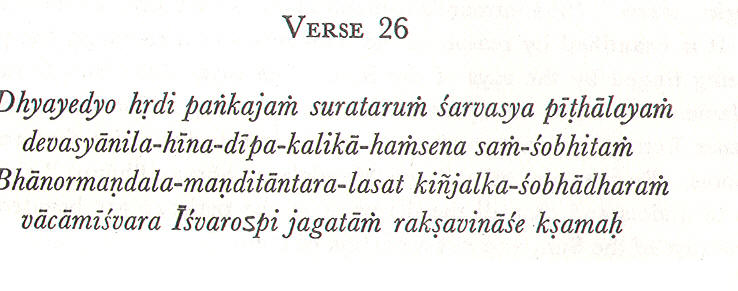
26. Dhyayedyo hṛdi paṅkajaṁ surataruṁ śarvasya pīthālayaṁ
devasyānila-hīna-dīpa-kalikā-haṁsena saṁ-śobhitaṁ
bhānormaṇdala-maṇditāntara-lasat kiñjalka-śobhādharaṁ
vācāmīśvara īśavaroऽpi jagatāṁ rakşavināśe kşamaḥ
He who meditates on this Heart Lotus becomes (like) the Lord of Speech, and (like) Isvara he is able to protect and destroy the worlds. This Lotus is like the celestial wishing-tree, the abode and seat of Sarva. It is beautified by the Hamsa, which is like unto the steady tapering flame of a lamp in a windless place. The filaments which surround and adorn its pericarp, illumined by the solar region, charm. Sarva = Maha-Deva = Siva. Hamsa = Here it stands for Jivatma.
Pandit Purnananda Svami talks about the good gained by meditating on the Heart Lotus. Dhyayedyo hṛdi paṅkajaṁ surataruṁ śarvasya pīthālayaṁ = He who meditates on this Heart Lotus becomes (like) the Lord of Speech, and (like) Isvara he is able to protect and destroy the worlds. anila-hīna-dīpa-kalikā-haṁsena saṁ-śobhitaṁ = Hamsa (Jivatma) is like the steady flame of lamp in a widless place, and enhances the beaty of this Lotus. Surya Mandala is in the pericarp of Anahata Lotus. bhānormaṇdala-maṇditāntara-lasat kiñjalka-śobhādharaṁ = The filaments which surround and adorn its pericarp, illumined by the solar region, charm. The filaments surrounding the pericarp tinged with the rays of the sun give beauty and charm. Anahata Lotus filaments around the pericarp are the only ones thus tinged by the rays of the sun and other filaments of other lotuses are not so touched by the Sun's rays. BhAnu Mandala = Sun Mandala. The region of Vayu covers the whole pericarp. Above it is region of Surya or sun. Above them are the Vayu-Bija and Trikona etc. One should meditate upon all these. Mam is the Mantra of mental worship in the region of Fire with his ten KalAs. Kala = digit, part, portion. The regions of Vahini (Fire), Arka (Sun), and Chandr (Moon) are placed one above the other. īśavar = Creator. rakşavināśe kşamaḥ = Equally able to protect and destroy the world. he can create, maintain and destroy the Universe.
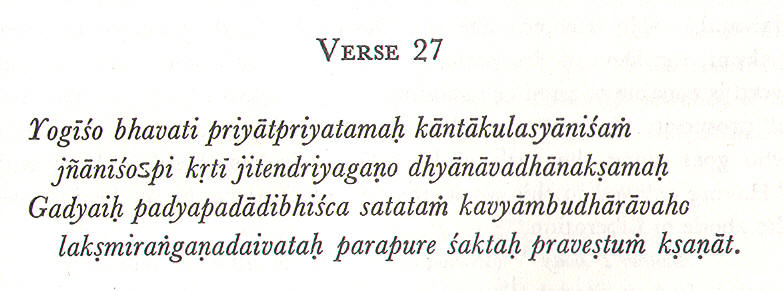
27. Yogīśo bhavati priyātpriyatamaḥ kāntākulasyāniśaṁ
jñānīśoऽpi kṛti jitendriyagaṇo dhyānāvadhānakşamaḥ
Gadyaiḥ padyapadādibhiśca satataṁ kavyāmbhudhārāvaho
lakşmiraṅgaṇadaivataḥ parapure śaktaḥ praveştuṁ kşaṇāt.
Foremost among Yogis, he is ever dearer than the dearest to women, He is pre-eminently wise and full of noble deeds. His senses are completely under control. His mind in its intense concentration is engrossed in thoughts of the Braham. His inspired speech flows like a stream of (clear) water. He is like the Devata who is the beloved of Laksmi and is able at will to enter another's body. Laksmi = Lakshmi is the family Devata, meaning he is always prosperous.
priyātpriyatamaḥ kāntākulasya = dearer than the dearest to women (because he is skilful to please them). Sankara says that he is dearer than their husbands. jitendriya-gaṇḥ = His senses are completely under control. dhyānāvadhāna-kşamaḥ = His mind in its intense concentration is engrossed in thoughts of the Braham. Dhyana is meditation --Brahma-Cintana, and AvadhAna means steady and intense concentration of the mind. The yogi is capable of both. kavyāmbhu-dhārā-vaha = His inspired speech flows like a stream of (clear) water. lakşmī-raṅgaṇa-daivataḥ = He is like the Devata who is the beloved of Laksmi. Slakshmi is the consort of Vishnu. Rangana is good fortune. Having enjoyed in this world th best of pleasure, he in the end goes to the abode of Liberation. parapure = another's body. He is able at will to enter another's body. He gains power to render himself invisible, enter an enemy's fortress, and fly across the sky.
Summary of Verses 22 to 27 on Anahata Chakra.
The Heart Lotus of the color of Bhaduka Flower has vermilion letters from Ka to Tha on its 12 petals with Bindu above them. Hexagonal Vayu Mandala of smoky color is in its pericarp; above it is Surya Mandala with the Triangle shining like ten million flashes of lightning within it. Above it is Vayu-Bija of smoky hue sitting on a black antelope, four armed and carrying a goad (Ankusa). In the lap of Vayu-Bija abides three-eyed Isa who like Hamsa extends His two arms in gestures of granting boons and dispelling fear. In the pericarp of the Anahata Lotus is another red lotus wherein abides four-armed Sakti Kakini of golden hue, yellow raiment, many jewels and garland of bones carrying PAsa (noose), the KapAla (skull), and making Vara (boons) and Abhaya (fear-not) signs. Her heart is softened by the nectar. Golden-colored Siva in the form Bana-Linga with crescent moon and Bindu on his forehead abides in the middle of the triangle. He is joyous with a rush of desire. Hamsa Jivatma below him is like the steady tapering flame of a lamp. Below the pericarp, there is a red lotus of 8 petals with its head turned upward which contains the Kalpa tree, the jeweled altar surmounted with an awning, flags and the like and is the place of mental worship.
VISUDDHA
Serpen1.jpg
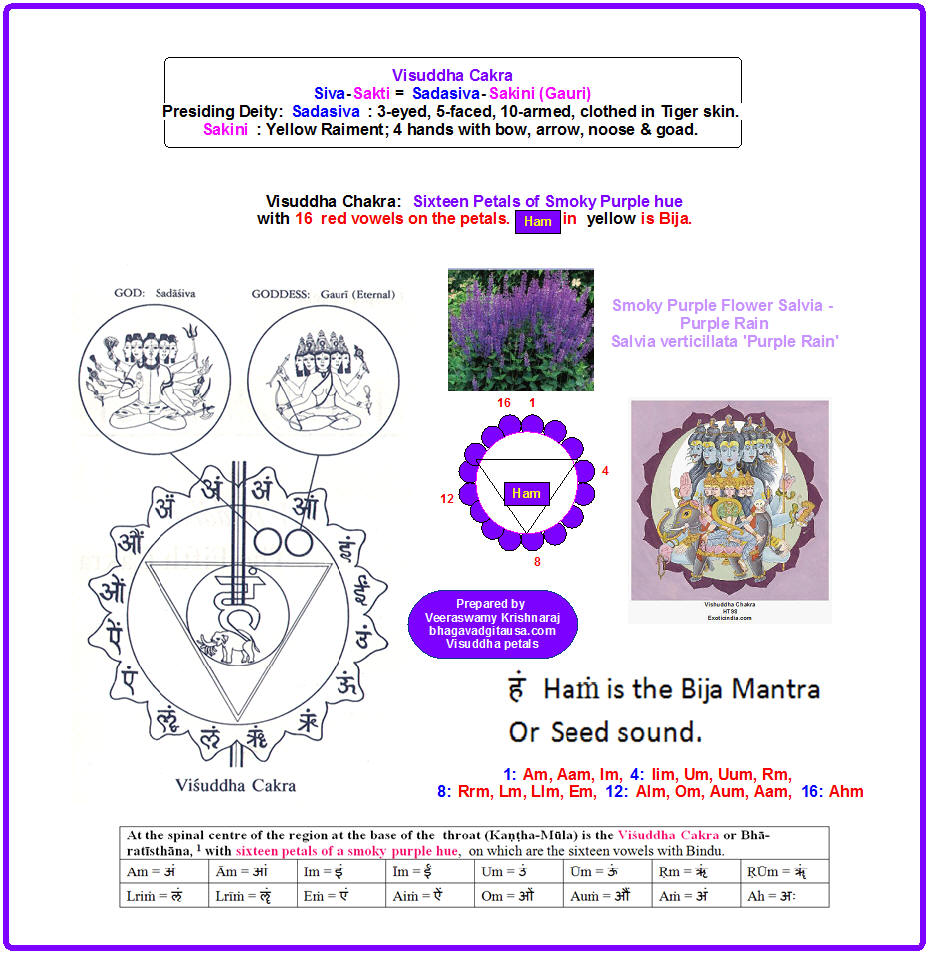
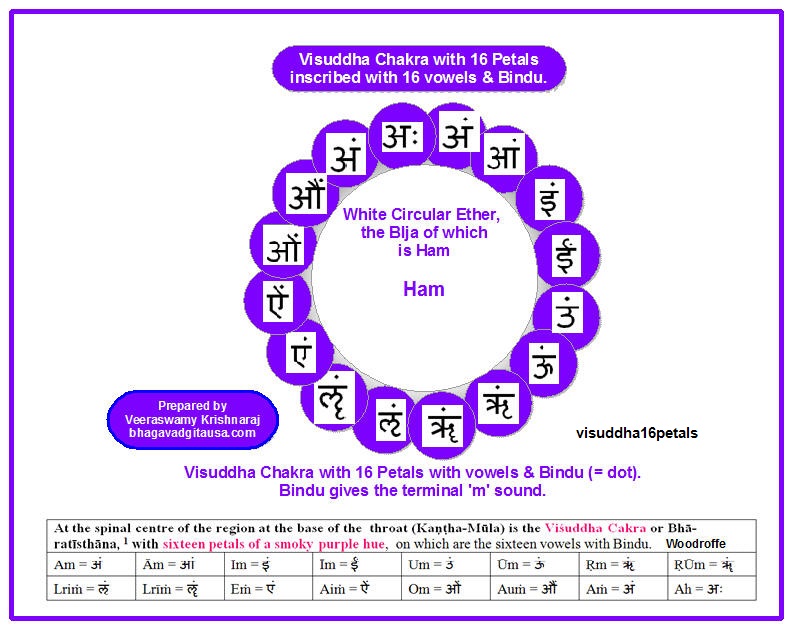
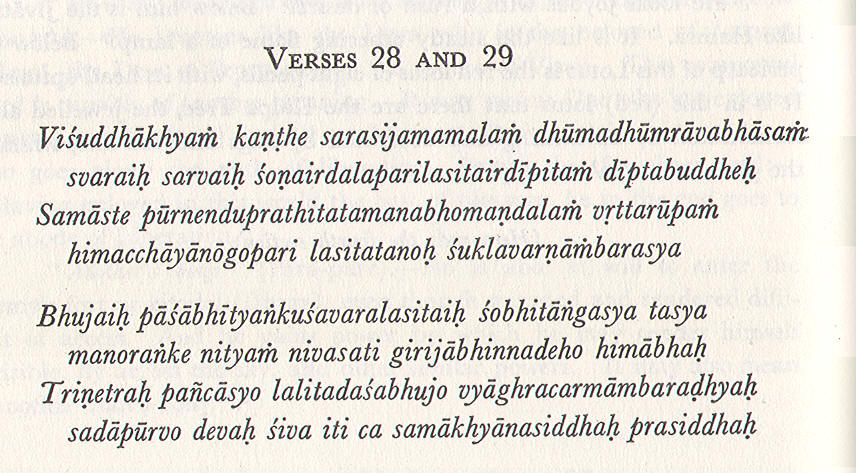
28. Viśuddhākhyaṁ kaṇṭhe sarasijamamalaṁ dhūmadhūmrāvabhāsaṁ
svaraiḥ sarvaiḥ śoṇairdalaparilasitairdīpitaṁ dīptabuddheḥ
Samāste pūrneneduprathitatamanabhomaṇḍalaṁ vṛttarūpaṁ
himacchayanāgopari lasitatanoh suklavarnambarasya
29. Bhujaiḥ pāśābhītyaṅkuśavaralasitaiḥ śobhitāṅgasya tasya
manoraṅke nityaṁ nivasati girijābhinnadeho himābhaḥ
Triṇetraḥ pañcāsyo lalitadaśabhujo vyāghracaramāmbaraḍhyaḥ
sadāpūrvo devaḥ siva iti ca samākhyānasiddhaḥ prasiddhaḥ
In the throat is the Lotus called Visuddha, which is pure and of a smoky purple hue. All the (sixteen) shining vowels on its (sixteen) petals, of a crimson hue, are distinctly visible to him whose mind (Buddhi) is illumined. In the pericarp of this lotus there is the Ethereal Region, circular in shape, and white like the full Moon. On an elephant white as snow is seated the Bija of Ambhara, who is white of colour. www.bhagavadgitausa.com/Sat-Chakra-Nirupana-Kundalini Chakras.htm
Of His four arms, two hold the noose and goad, and the other two make the gestures of granting boons and dispelling fear. These add to His beauty. In His lap there ever dwells the great snow-white Deva, three-eyed and five-faced, with ten beautiful arms, and clothed in a tiger's skin. His body is united with that of Girija, and He is known by what His name, Sada-Siva, signifies.
full Moon: Ether, whose Mandala is a circle (Vrrta-rupa), is the element of Visuddha Lotus Chakra. Bija = Ham is the Bija of Visuddha. Ambhara = Ethereal region. also means raiment. Ambhara, white in his Bija form wearing white raiment, sits on a elephant of the color of snow. His lap: Ham (Nabho-Bija). Girija = Giri is mountain. Mountain-born Devi. Daughter of Mountain King Himavat (Himalaya Mountains). This refers to Androgynous from of Siva-Sakti. Sada-Siva = Ever-Beneficent One.
Four verses from 28 to 31 describes Visuddha Lotus Chakra. Hamsa (the Jiva) attains purity, so this lotus is called Visuddha (pure), Ethereal, Great, and Excellent. Visuddha in the region of the throat is called Visuddha: Pure (amala = without impurity) by reason of its being tejo-maya (purified by Fire and its substance is Tejas) and hence free from impurity. svaraiḥ sarvaiḥ = all the vowels, beginning from A-KAra (A) ending with Visarga, altogether 16 in number. dala-parilasitaiḥ = shining on the petals, 16 in number and red in color with Bindu above them. Its filaments are ruddy and it is adorned by Vyoma-Mandala. Vyoma = Ether. Mandala = region or circle. dīpitam= Distinctly visible. The letters are lighted up as it were for the enlightened mind (Dīpta-Buddhi). dīptabuddheh = Whose mind (Buddhi = Intellect) is illumined. The intellect has become free of impurities of worldly pursuits as a result of constant practice of Yoga. pūrnenedu-prathita-tama-nabhomaṇḍalaṁ vṛtta-rūpaṁ = the Ethereal Region, circular in shape, and white like the full Moon. purnenedu = Full-Moon. nabhomaṇḍalaṁ = Ethereal Region. vṛtta-rūpaṁ = Circular in shape. Various texts have assigned different colors to Ethereal region: white, smoky. hima-cchayanāgopari lasita-tanu = On an elephant white as snow is seated. Nāga is not a serpent but an elephant in this context.
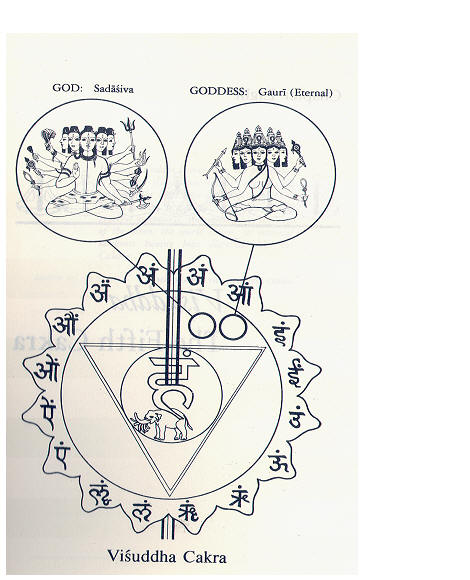
Bhujaih pasabhityankusa-vara-lasitaih sobhitangasya (Bhujaiḥ pāśābhītyaṅkuśa-vara-lasitaiḥ śobhitāṅgasya) = Of His four arms, two hold the noose and goad, and the other two make the gestures of granting boons and dispelling fear. These add to His beauty. tasya manoh = His Mantra = The Bija of Ambara or Ether = Ham. The Bija (root) of a thing is that thing in essence. tasya manor anke = In the lap of His Bija. Ham is Bija of Ether in the pericarp of Visuddha Lotus and we are to meditate on it. girijabhinna-deha (girijābhinna-deha) = the snow-white Deva whose body is united with or inseparable from that of Girija. This means Siva-Sakti body is androgynous, of golden color on the left (Sakti) and snow-white on the right (Siva). He, Sadasiva with white garment, dwells in the lap of Nabho-Bija. Nirvana Tantra says: Within the Yantra (AmA KalA) is the Half-Bull and half-Lion (Simhasana), on which sits the Eternal Gauri (Sakti on half-lion) with Sada-Siva on Her right (on half-bull). Sadasiva has five faces, three eyes in each face, a body smeared with ash, looks like a mountain of silver, and wears the skin of a tiger and a garland of snakes as His ornaments. The Eternal Gauri (SadA-Gauri), half of Siva's body, is the Mother of the Universe. lalita-dasa-bhuja (lalita-daśa-bhuja) = beautiful-ten-arms. Meditate on Him as Deva with ten arms carrying the following weapons, accouterments and offering boons. Ten beautiful arms carry the following.
|
Sula |
Tanka |
Krpana |
Vajra |
Dahana |
Nagendra |
Ghanta |
Ankusa |
Pasa |
Abhitikara |
|
Trident |
Battle-axe |
Sword |
Thunderbolt |
Fire |
Snake-King |
Bell |
Goad |
Noose |
no-fear sign |
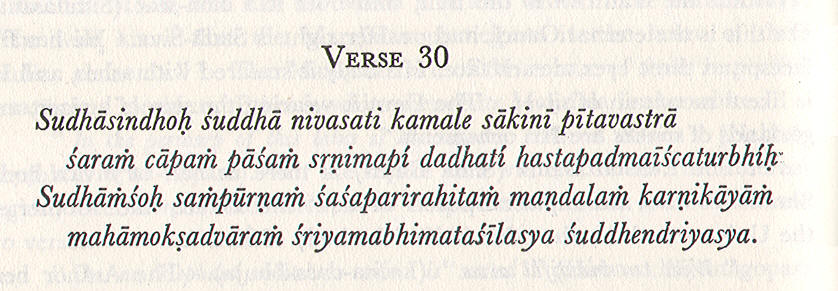
30. Sudhāsindhoḥ suddha nivasati kamale sākinī pītavastrā
śaram cāpaṁ pāśam sṛṇimapi dadhatí hastapadmaīścaturbhíḥ
sudh|mśoḥ saṁpūrṇaṁ śaśaparirahitaṁ maṇdalaṁ karṇikāyāṁ
mahāmokşadvāraṁ śriyambhimataśīlasya śuddhendriyasya.
Purer than the Ocean of Nectar is the Sakti Sakini who dwells in this Lotus. Her raiment is yellow, and in Her four lotus-hands She carries the bow, the arrow, the noose, and the goad. The whole region of the Moon without the mark of the hare is in the pericarp of this Lotus. This (region) is the gateway of great Liberation for him who desires the wealth of Yoga and whose senses are pure and controlled. hare = hare on the moon, stain on the moon, man on the Moon.
Swami Purnananda says that Sakini abides in the pericarp of Visuddha Lotus Chakra.
Sudhasindhoh suddha ( Sudhāsindhoḥ suddha) = Purer than the ocean of Nectar. Sudhasindhu is Chandra or Moon according to Sankara. She is purer and whiter than the nectar in the moon. Sakini who is of the form of light itself (Jyotih-svarupa) is white and heatless. Meditation on Sahini is as follows: "Let the excellent Sadhaka meditate on the Devi Sakini in the Throat Lotus. She is Light itself. She carries in Her Lotus hands the noose, the goad, the sign of the book and makes Jnana-Mudra (thumb and pinky touching at the tips). She makes the Pasus (the uninitiated people) mad and has her abode in the bone (She is the Devata of Asthi-Dhatu. She is fond of milk food and gets drunk and elated on the nectar." The Devi (Sakti Sakini) is the Lunar Region within the pericarp. kamale = in this Lotus. in the pericarp of the Visuddha Chakra. sasa-pari-rahita = In this pericarp is the spotless region of the Moon, without the mark of a hare. maha-moksa-dvaram (mahā-mokşa-dvāraṁ ) = Great-heaven-gate. The gateway to Great liberation-- Nirvana Mukti (in the praise of this Mandala) for those who have purified and conquered their senses, among other practices; by meditating in this in the path of Yoga, they attain Liberation (mukti). sriyambhimata-silasya (śriyambhimata-śīlasya) = Who desires the wealth of Yoga. Sri is wealth (of Yoga). That nature is the gateway to liberation. suddhendriya (śuddhendriya) = Suddha + Indriya = Pure + Senses. Whose senses are pure and controlled. presentation: Veeraswamy Krishnaraj
In
the pericarp of the Lotus of Nabho-Mandala: inside the latter is the triangle,
inside which is the Chandra-mandala, inside which is Nabho-Bija (Ham).
Think of the full-moon in the triangle within the pericarp; there think of the
snowy Akasa seated on the elephant, whose raiment is while. There is the Deva
Sada-Siva whose raiment is white--qualifies Akasa. 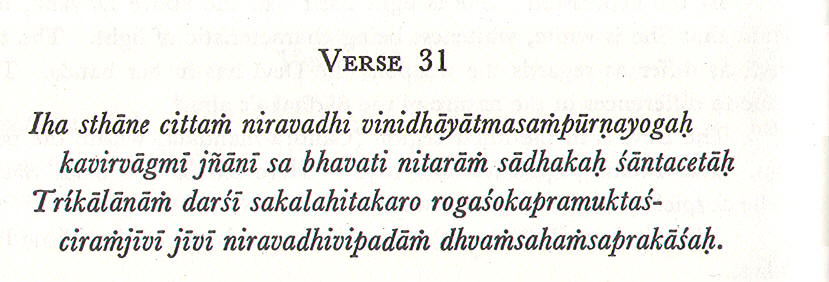
31. Iha sthāne cittam niravadhi vinidhāyātmasampūrṇayogaḥ
kavirvāgamī jñānī sa bhavati nitarāṁ sādakaḥ śāntacetāḥ
Tríkālānāṁ darśī sakalahitakaro rogaśokapramuktaś-
ciramjīvī jīvī niravadhivipadāṁ dhvaṁsahaṁsaprakāśaḥ.
He who has attained complete knowledge of the Atma (Brahman) becomes by constantly concentrating his mind (Citta) on this Lotus a great Sage, eloquent and wise, and enjoys uninterrupted peace of mind. He sees the three periods, and becomes the benefactor of all, free from disease and sorrow and long-lived, and, like Hamsa, the destroyer of endless dangers.
Svami Purnananda speaks of the good gained by meditating on the Visuddha-Chakra.
atma-sampurna-yoga (ātma-sampūrṇa-yoga) = who has attained complete knowledge of the Atman (Brahman) by virtue of the fact that Brahman is all-pervading. Another meaning is One who has obtained perfection Yoga. The one who has attained complete knowledge of Atma reposes like the still waters of the deep. Such a person is a Knower (Jnani). He becomes proficient of all Sastras without instruction therein. "He becomes merciful not looking for any rewards; his Citta is peaceful; He is constant, gentle, modest, courageous, forgiving, self-controlled, pure and the like, and free from greed, malice and pride." Bhagavad-Gita16.2 & 3. Tri-kala darsi (Tri-kāla darśī )= three-periods-seer. he sees the three periods-Past, present and future. He sees the Atma (Self) and all objects of knowledge therein. roga-soka-pramuktah (roga-śoka-pramuktah) = Disease-Sorrow-the Liberated. Free from disease and sorrow--by having attained Siddhi (Spiritual perfection) in his Mantra. He is free of MAyA and thus feels no sorrow. niravadhi-vipadam-dhvamsa-hamsa-prakasah (niravadhi-vipadāṁ dhvaṁsa-haṁsa-prakāśaḥ)_ = endless-dangers-destroying-Hamsa-showing, shining. Like Hamsa, the destroyer of endless dangers. The Sadhaka becomes Hamsa Which is the Antartma (Inner Soul) that dwells by the pericarp of the Sahasrara for he can destroy all such dangers and in the result open the gate of Liberation. Sankara calls Hamsa Sun. Hamsa is the 12-petalled Lotus below Sahasrara.
Summary of the Visuddha Chakra
Visuddha Chakra is in the base of the throat with ruddy filaments, and 16 petals of smoky purple hue and 16 red Vowels on the petals with Bindu above them. Circular and white Nabho-Mandala is in the pericarp inside which is Chandra Mandala with elephant-mounted white, garmented and four-armed Bija Ham above it, which holds in four hands noose and goad, and makes Vara and Abhaya Mudras. In his lap is Sada-Siva seated on a great lion-seat placed on the back of the bull. He is in the form of Ardha-narisvara; half the body snow-white Siva and the other half golden Sakti, with five faces, ten arms holding trident, battle-axe, sacrificial sword, thunderbolt, the great snake, bell, goad, noose, and making Abhaya-mudra. He wears a tiger's skin, ash all over His body, a garland of snakes round His neck, and a down-turned digit of moon on His forehead dropping the nectar. Within the pericarp and in the Lunar region and seated on bones, is Sakti Sakini, white in color, four-armed, five-faced and three-eyed on each face, clothed in yellow and carrying in Her hand a bow, an arrow, a noose, and a goad.
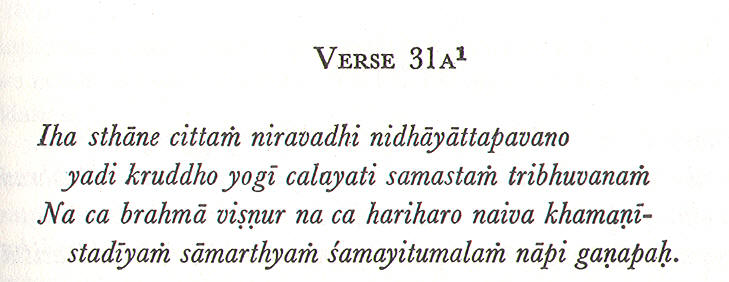
31. Iha Sthne cittaṁ niravadhi nidhāyāttapavano
yadi kruddho yogī calayati samastaṁ tribhuvanaṁ
Na ca brahmā vişṇur na ca hariharo naiva khamaṇī-
stadīyaṁ sāmarthyaṁ śamayatumalaṁ nāpi gaṇapaḥ.
The Yogi, his mind constantly fixed on this Lotus, his breath controlled by Kumbhaka (retention of breath), is in his wrath able to move all the three worlds. Neither Brahma nor Visnu, neither Hari-Hara nor Surya (sun) nor Ganapa (Ganesa) is able to control his power (resist Him). wrath = This is SturivAda = praise of his great powers. If He were to get angry, he could move the three worlds.
Swami Purnannda speaks of the power of Yogi.
Ātta-pavana = his breath controlled by Kumbhaka (retention of breath in Pranayama--breath control). harihara = The Yugala--combined--form of Vishnu and Siva. khamani = the jewel of the sky = the sun.
End of 5th section.
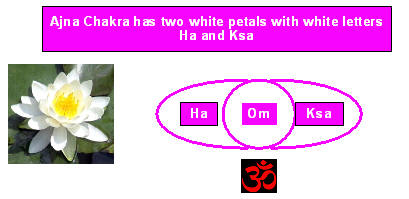
AJNA
Serpen2.jpg
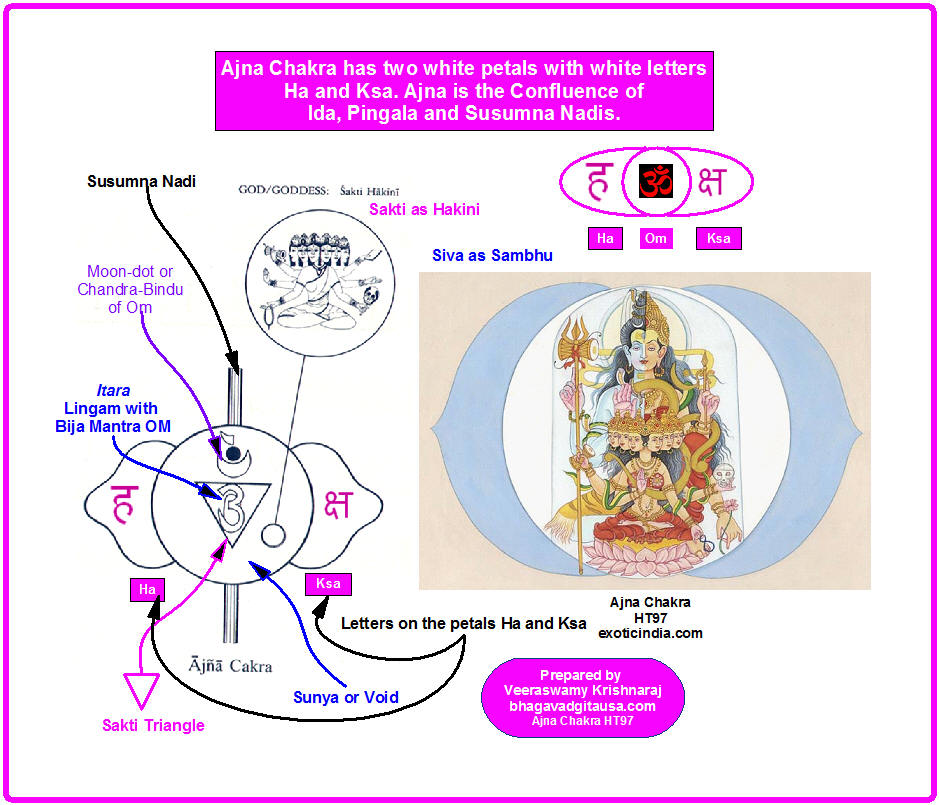
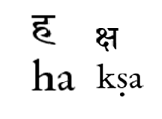 are
the letters on the petals. ! Om is the Bija letter of Ajna
Chakra.
are
the letters on the petals. ! Om is the Bija letter of Ajna
Chakra.

32. Ājñanāmāmbujaṁ taddhimakarasadṛśam dhyānadhāmaprakāśaṁ
hakşābhyāṁ vai kalābhyāṁ parilasitavapurnetrapatraṁ suśubhraṁ
Tanmadhye hākinī sā śaśisamadhavalā vaktraşaṭkaṁ dadhānā
vidyāṁ mudrāṁ kapālaṁ ḍamarujapavaṭīṁ bibhrtī śuddhacittā.
The Lotus named Ajna is like the moon (beautifully white). On its two petals are the letters Ha and Ksa, which are also white and enhance its beauty. It shines with the glory of Dhyana (meditation). Inside it is the Sakti Hakini, whose six faces are like so many moons. She has six arms, in one of which She holds a book; two others are lifted up in the gestures of dispelling fear and granting boons, and with the rest She holds a skull, a small drum, and a rosary. Her mind is pure (Suddha-Citta). Ajna = Command. Name of the Lotus between the eyebrows above Visuddha Chakra. book = Pustaka-Mudra. A hand gesture of Vidya or knowledge.
Swami Purnananda talks about Ajna Chakra from Verse 32 to 38
Verses 32 to 38 describes Ajna Chakra. Ajnanama (Ājña-nāmā) = Ajna name. The Lotus named Ajna. Ajna or Command of the Guru comes down (GurorAjneti) to this Lotus between the eyebrows. Going upwards after entering the throat and palate, the white and auspicious lotus (the place of manas, the mind) between the eyebrows is reached by Kundali. Its 2 petals have Ha and Ksa on them. himakara-sadrsam (hima-kara-sadṛśam) = Like the moon, beautifully white. or Cool like the moonbeams. Hima-kara is Moon. Hima means cool; Kara means causer. The moon is the receptacle of Ambrosial nectar and cool and beautifully white. dhyana-dhama-prakasam (dhyāna-dhāma-prakāśaṁ) = it shines with the glory of Dhyana. Its body shines like the glory of Dhyana Sakti. netrapatraṁ = two petals. Netra = eye. Ha-ksabhyam kalabhyam-parilasitavapuh-susubhram = (Ha-kşābhyāṁ kalābhyāṁ parilasitavapuh su-śubhraṁ) The letters Ha and Ksa which are also white. Hakini sa ( hākinī sā) = She is Hakini, the resident Devata of the Ajna Chakra. mudram (mudrā) = hand poses depicting granting of boons and dispelling fear. vidyam-mudram = this may also mean the hand pose of Knowledge.
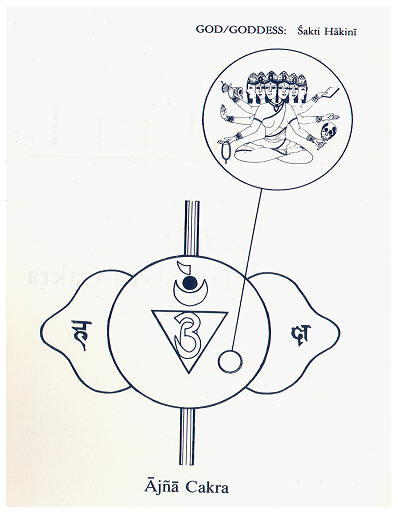
Meditate on Sakti Hakini who is white, abides in the marrow, and holds in her hands the Damaru, the Rosary, the Skull, the Vidya (sign of the book) and the Mudra (hand pose of granting boons and dispelling fear). She has six red faces with three eyes in each. See below. She sits on a white lotus, and likes food cooked with Turmini and feels elated by drinking ambrosia.

33. Etatpadmāntarāle nivasati ca manaḥ sūkşmarūpaṁ prasiddhaṁ
yonau tatkaraṇikāyāmitaśivapadaṁ liṅgacihṇaprakāśaṁ
Vidyunmālāvilāsaṁ paramakulapadaṁ brahmasūtraprabhodaṁ
vedānāmādibījaṁ sthiratarahṛdayaścintayettatkrameṇa.
Within this Lotus dwells the subtle mind (Manas). It is well-known. Inside the Yoni in the pericarp is the Siva called Itara, in His phallic form. He here shines like a chain of lightning flashes. The first Bija of the Vedas, which is the abode of the most excellent Sakti and which by its lustre makes visible the Brahma-sutra, is also here. The Sadhaka with steady mind should meditate upon these according to the order (prescribed). www.bhagavadgitausa.com/Sat-Chakra-Nirupana-Kundalini Chakras.htm
Swami speaks of the Manas, the Mind in Ajna Chakra. Swami Purnananda talks about Ajna Chakra from Verse 32 to 38.
Etatpadmantarale nivasati ca manah suksmarupam prasiddham (Etatpadmāntarāle nivasati ca manaḥ sūkşmarūpaṁ prasiddhaṁ) = Within this Lotus dwells the subtle mind (Manas). The Manas is beyond the scope of the senses. What is the proof of its existence? It is universally accepted (prasiddha) and handed down from AnAdi-Purusa as realized thing. Manas is above the First Bija of the Vedas. linga-cihna-prakasam (liṅga-cihṇa-prakāśaṁ) = shining Phallic form. Sivalinga is in the Yoni within the pericarp. The Itara-Siva in Linga form is within the Yoni. Itara-Sivapada within the triangle in the pericarp is white and crystalline with three eyes. Vidyun-mala-vilasam (Vidyun-mālā-vilāsaṁ) = Linga resembles continuous streaks of lightning flashes. parama-kula-padam = Excellent-Kula-place. which is the abode of the most excellent Sakti. Kula is Sakti of Triangular form. Akula is not Sakti but Siva. Atma is in the form of Pranava in the triangle in the pericarp. Above it, the flaming lamp is the charming NAda and Bindu is MakAra (M of AUM). Manas abode is above these. vedanam-adibijam (vedānāmādibījaṁ) = First Bija of the Vedas. It refers to M of Pranava (AUM) in the pericarp pf the lotus. brahma-sutra-prabhodam (brahma-sūtra-prabhodaṁ)= makes visible the Brahma-sutra. Brahma Sutra is Brahma thread or Citrini Nadi. Sutra is thread and cognate with suture. The luster of Pranava makes the Sutra visible.
The SAdaka should meditate on all of these: Hakini in the pericarp, Manas, Itara Linga and Pranava in the order prescribed.
The vertical linearity of the entities are from below up: First Hakini in the pericarp, Itara Linga in the triangle above her, Pranava in the triangle above Him, Manas at the top.
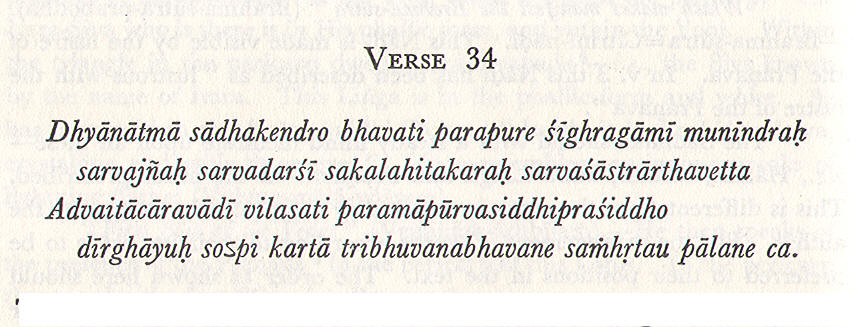
34. Dhyānātmā sādhakendro bhavati prapure śighragāmī munindraḥ
sarvajñah sarvadarśī sakalahitakarah sarvaśāstrarthavettā
Advaitācāravādī vilasati paramāpūrvasiddhipraśiddho
dīrghāyuḥ soऽpi kartā tribhuvanabhavane saṁhṛtau pālane ca.
The excellent Sadhaka, whose Atma is nothing but a meditation on this Lotus, is able quickly to enter another's body at will, and becomes the most excellent among Munis, and all-knowing and all-seeing. He becomes the benefactor of all, and versed in all the Sastras. He realises his unity with the Brahman and acquires excellent and unknown powers. Full of fame and long-lived, he ever becomes the Creator, Destroyer, and Preserver, of the three worlds.
Swami Purnananda talks about the benefits of meditating on Ajna Lotus, from Verse 32 to 38.
munindrah = the most excellent among Munis. Muni literally means the silent one. Maunam is silence. Muni, the silent Yogi is accomplished in meditation and Yoga. Muni-indra = Muni-king = the king among Munis = excellent Muni. sarva-sastrarthavetta (sarva-śāstrarthavettā)= versed in all the Sastras. Versed in the meaning of Sastras.Proficient in sacred texts and Divine Knowledge. Advaitacara-vadi (Advaitācāra-vādī )= He realizes. He knows that universe and beings are Brahman. The universe is Brahman's amsa or fragment. he knows Brahman alone is Real (Sat), everything else is unreal (Asat) and everything shines by the light of Brahman. Advaitavadi is the one who has realized the identity of the individual soul with the Supreme Spirit and preaches it to others. parama-purva-siddhi (paramāpūrva-siddhi) = excellent and unknown powers. prasiddha = full of fame for his excellence. soऽpi karta tribhuvana-bhavane samhrtau palane ca. (so'pi kartā tribhuvana-bhavane saṁhṛtau pālane ca.) = He ever becomes the Creator, Destroyer, and Preserver, of the three worlds. This is Praśaṁsā-Vāda = Praise-statement = Eulogy. The Sadakha becomes absorbed in the Supreme on the dissolution of his body and thus becomes the source of Creation, Preservation and Destruction. (The generally held view is that the individual soul does not merge literally with either Siva, or Vishnu in Vaikuntam, or Mother Goddess. All keep their separate identities. Sayujya, a state of proximity and union is the highest state an individual soul can attain in Vaikuntam or other heavens. It is not a physical union. It is spiritual and yet it is not a fusion. It is like a family gathering; you are all in one place and yet you are separate; the patriarch or matriarch is at the top of the heap. Thus the ability to create, maintain, and destroy is the exclusive domain, privilege and power of the Supreme Being.)
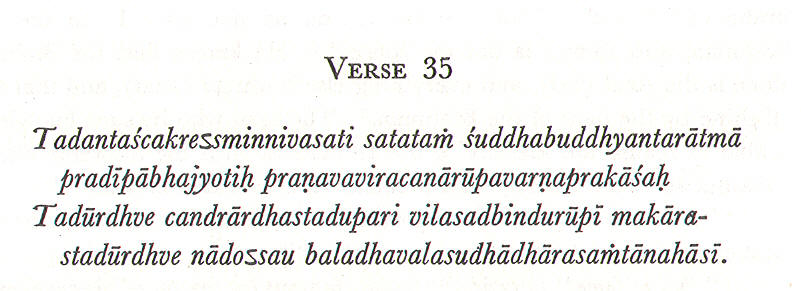
35. Tadantaścakreऽsminnivasati satataṁ śuddhabuddhyantarātmā
Pradīpābhajyotiḥ praṇavaviracanārūpavarnaprākaśah
Tadūrdve candrārdhastadupari vilasadbindurūpī makāra
stadūrdhve nādoऽsau baladhavalasudhādhārasaṁtanahāsī.
Within the triangle in this Cakra ever dwells the combination of letters which form the Pranava. It is the inner Atma as pure mind (Buddhi), and resembles a flame in its radiance. Above it is the half (crescent) moon, and above this, again, is Ma-kara, shining in its form of Bindu. Above this is Nada, whose whiteness equals that of Balarama and diffuses the rays of the Moon.
Swami Purnananda talks about Ajna Chakra from Verse 32 to 38.
letters = That is, a and u, which by Samdhi becomes 0, and with anusvara (m) thus form the Pranava, or mantra Om.
Ma-kara = The letter M in its Bindu form in Candra-bindu. . presentation: Veeraswamy Krishnaraj
Balarama = Samkara reads it as Jala-dhavala, etc., and explains it by "white like water". The last portion may also mean" smiling whiteness equals that of the Moon ".
The author desires to speak of the presence of the Pranava in the Ajna-Cakra and says that in this Cakra, and within the triangle which has already been spoken of, ever dwells the combination of the letters A and U which by the rules of Sandhi make the thirteenth vowel O. This combination of letters is Suddha-buddhyantaratma-i.e., the innermost Spirit manifesting as pure intelligence (Buddhi). The question may be asked if the thirteenth vowel (O) is that. To obviate this the author qualifies it by saying" above it is the half Moon, etc." It is by adding the half Moon (Nada) and Bindu to O that the Pranava is formed.
He next gives its attributes:
Pradipabhajyotih (Pradīpābhajyotiḥ ) = "Resembles a flame in its radiance? But how can this thirteenth vowel by itself be Suddha-buddhyantaratma ? He therefore says:
Tadurdve candrardhah (Tadūrdve candrārdha) = " Above it is the crescent moon" candrārdha = half-moon or crescent moon
tadupari vilasad-bindu-rupi ma-kara (tadupari vilasad-bindurūpī makāra)" And above this, again, is ma-kāra, shining in its form of Bindu" it is thus shown that by the placing of the crescent moon and the Bindu over the thirteenth vowel the Pranava is completely formed. Bindu = AnusvAra = After-sound when AUM is intonated. au is the 13th vowel and m is AnusvAra or the after-sound. AnusvAra is an m with a dot over or under it (eg. ṁ)
The here-depicted AUM/Om shows the dot.
sivagn14.jpg
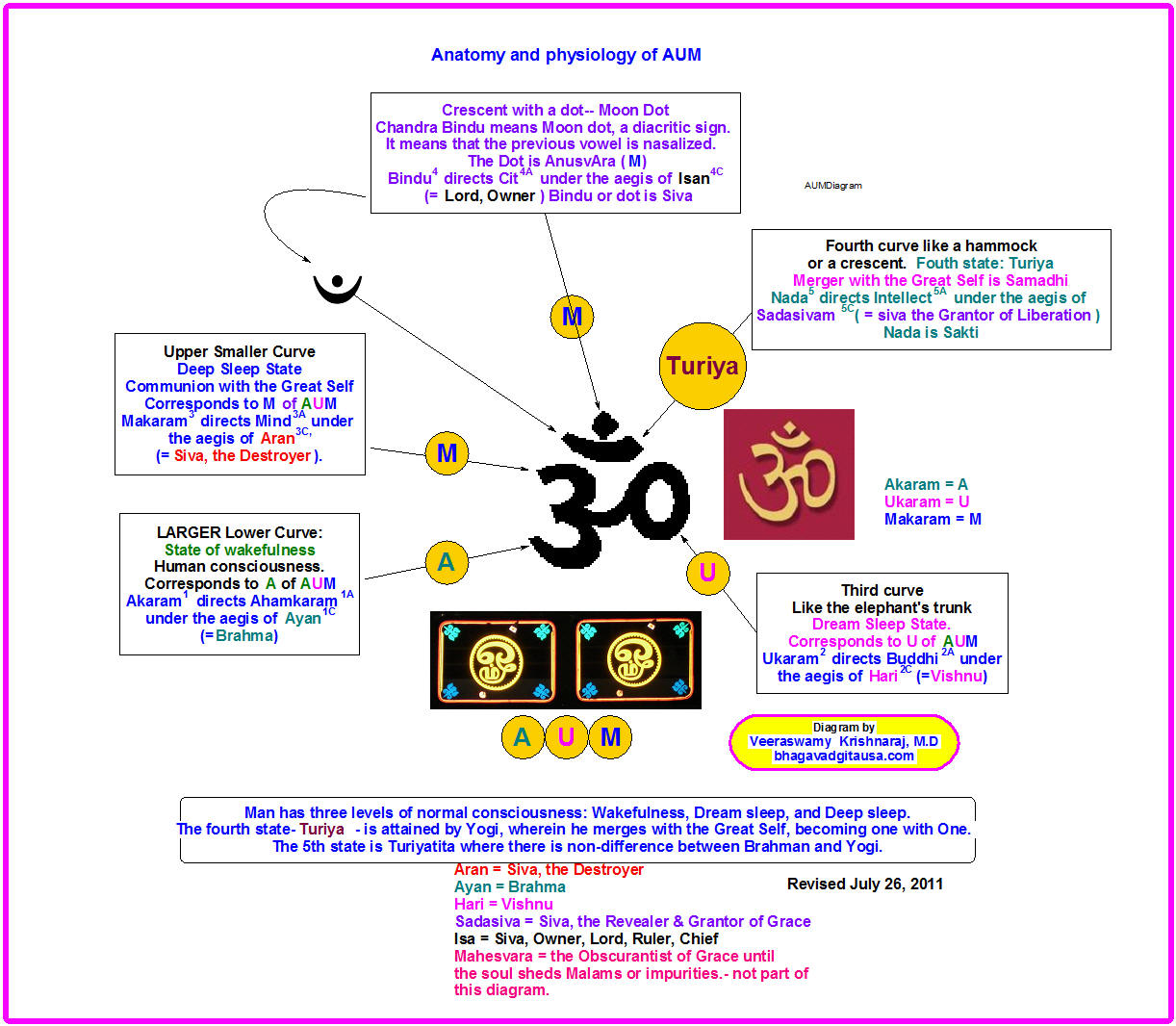
tadūrdhve nādo'sau-" Above this is Nada " i.e., above the Pranava is the Avantara (final or second) Nada, which challenges as it were the whiteness of Baladeva and the Moon (bala-dhavala-sudhā-dhāra-saṁthana-hāsī), By this he means to say that it is extremely white, excelling, in whiteness both Baladeva and the rays of the Moon (Visvanatha says, means multitude of moons).
Some read Tadadye nado'sau (in the place of Tadurdhve nado'sau) and interpret it as, "Below Bindu-rupi Ma-kara is Nada ". But that is incorrect. The text says: "Above this, again, is Ma-kara, shining in its form of Bindu," and there is Nada below it; that being so, it is useless to repeat that Nada is below.
Besides, this Nada is beyond the Nada, which forms part of the Pranava, and is part of the differentiating (Bhidyamana) Para-bindu placed above the Pranava, If, however, it be urged that it is necessary to state the details in describing the special Pranava (Visista-Pranava), and it is asked, "Why do you say a second Nada is inappropriate? " then the reading Tadadye nado'sau may be accepted.
But read. thus it should be interpreted in the manner following: " This Nada shown below the Bindu-rupi Ma-kara is Bala-dhavala-sudhadhara-samthana-hasi (v. ante), and the Nada first spoken of is also so described. Such repetition is free from blame on the authority of the maxim that" the great are subject to no limitations."
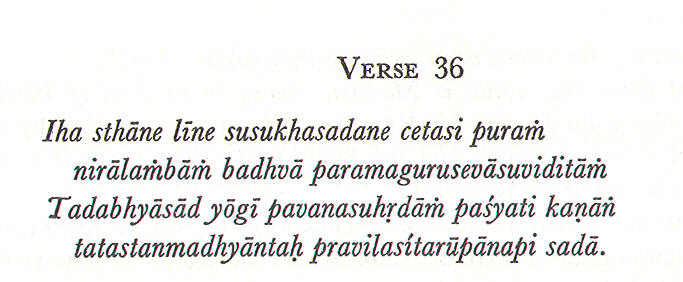
36. Iha sthāne līne susukhasādhane cetasi puraṁ
nirālambām badhvā paramagurusevāsuviditāṁ
Tadabhyāsād yōgī pavanasuhṛdāṁ paśyati kaṇāṅ
tatastanmadhyāntaḥ pravilasítarūpānapi sadā.
When the Yogi closes the house which hangs without support, the knowledge whereof he has gained by the service of Parama-guru, and when the Cetas by repeated practice become dissolved in this place which is the abode of uninterrupted bliss, he then sees within the middle of and in the space above (the triangle) sparks of fire distinctly shining.
Swami Purnananda talks about Ajna Chakra from Verse 32 to 38.
COMMENTARY
Having described the Pranava, he now speaks of its union (with Cetas), i.e., Pranava-yoga.
The Yogi should close the house (Puram baddhva)-i.e., he should, with his mind set on the act, close the inner house; or, in other words, he should make Yoni-Mudra in the manner prescribed and thus effectually close the inner house. The use of the word Pur shows that the Yoni-Mudra is meant. Then, when his Cetas by repeated practice (Abhyasa) or meditation on the Pranava becomes dissolved (Lina) in this place (the Ajna-Cakra), he sees, within and in the space above the triangle wherein the Pranava is, sparks of Fire (Pavana-suhrdarm kanan), or, to put it plainly, sparks of light resembling sparks of fire appear before his mental vision above the triangle on which the Pranava rests. It is by Yoni-Mudra that the inner self (Antah-pUr) is restrained and detached from the outside world, the region of material sense. The Manas cannot be purified and steadied unless it is completely detached from the material sphere. It is therefore that the mind (Manas) should be completely detached by Yoni-Mudra,
without support = Niralarhba-puri. Niralamba (v. post) means that which has no support-viz., that by which the mind's connection with the world has been removed and realization of the infinite established. Akasamamsi= whose flesh or substance is Akasa (Rajanighantu Dictionary.)
Yoni-Mudra: i.e., closes the avenues of the mind and concentrates it within itself.
sparks of Fire = Pavana-suhrd-" He whose friend is air "= Fire. When the wind blows, fire spreads.
Yoni-Mudra, which detaches the Manas from the outside world, is thus defined: " Place the left heel against the anus, and the right heel on the left foot, and sit erect with your body and neck and head in a straight line. Then, with your lips formed to resemble a crow's beak1. draw in air and fill therewith your belly. Next2 close tightly your earholes with the thumbs, with your index-fingers the eyes, the nostrils by your middle fingers, and your mouth by the remaining fingers. Retain the air3 within you, and with the senses controlled meditate on the Marttra whereby you realize the unity (Ekatvam) of Prana and Manas4. This is Yoga, the favorite of Yogis."
That steadiness of mind is produced by restraint of breath through the help of Mudra, has been said by Sruti, "The mind under the influence of Hamsa5 moves to and fro, over different subjects; by restraining Harnsa, the mind is restrained."
(puraṁ badhvā) ="Closes the house".-This may also mean Khecari Mudra6.' This latter also produces steadiness of mind.
As has been said, "As by this the Citta roams in the Brahman (Kha7), and as the sound of uttered word8 also roams the Ether (Kha) , therefore is Khecari Mudra honored by all the Siddhas."
a crow's beak1: KAki = crow. That is, by Kaki-Mudra, Sruti says that when Vayu is drawn in by this Mudra and stopped by Kurnbhaka, steadiness of mind is produced.
. Next2= These and following verses occur in Sarada-Tilaka, Ch. XXV, vv. 45, 46. The first portion of this passage describes Siddhasana.
Retain the air3: That is, by Kumbhaka, Retaining the air in the lungs.
Manas4: 'That is, recite the Hamsa or Ajapa-mantra, or breathing in Kumbhaka.
Hamsa5 = The Jivatma manifesting as Prana.
Khecari Mudra6 = One of the Mudras of Hatha- Yoga. See Introduction.
Kha7 = has three meanings-viz." Ether, Brahman, and space between eyebrows (Ajna). Brahmananda, the commentator of the Hatha-yogapradipika, adopts the last meaning in interpreting this verse (Ch. III, v, 41), and in commenting on v. 55 of the Hatha-yoga-pradipika gives it the meaning of Brahman.
uttered word8 = Lit., tongue.
---------------------------------------------------------------------------------------------------------------------------------
The Citta is Khecara1 when, disunited from Manas and devoid of all attachment to all worldly things, it becomes Unmani2
As has been said3 "the Yogi is united with Unmani; without Unmani there is no Yogi!' Niralamba means that which has no support -namely, that from which the minds' connection with the world has been removed.
" The knowledge whereof he has gained by the service of his Paramaguru parama-guru-sevā-suviditāṁ (Parama-gutu-seva-suviditam).-Parama is excellent in the sense that he has attained excellence in Yoga practice (by instructions) handed down along a series of spiritual preceptors (Gurus), and not the result of book-learning4
."Serving the Guru" .-Such knowledge is obtained from the Guru by pleasing him by personal services (Seva). Cf." It can be attained by the instructions of the Guru, and not by ten million of Sastras."
" The abode of uninterrupted bliss" su-sukha-sādhane (Su-sukha-sadhana-e-i,e. this is the place where one enjoys happiness that nothing can interrupt. This word qualifies place (Iha-sthane-e-i.e., Ajna-Cakra.)
"Sparks of fire distinctly shining" pavana-suhṛdāṁ pravilasítarūpān kaṇāṅ (Pavana-suhrdam pravilasitarupan kanan).-These sparks of Fire shine quite distinctly.
Elsewhere it is clearly stated that the Pranava is surrounded by sparks of light: " Above it is the flame-like Atma, auspicious and in shape like the Pranava, on all sides surrounded by sparks of light."
Khecara1 = What moves about in the sky or ether. It is Manas which deprives the Citta of freedom by causing attachment to the world. On being disunited from Manas it moves freely in the ether, going its own way.
Unmani2 = Unmani is there where, to coin a word, the" Manasness " of Manas; ceases. See note to v. 40. Ut = without, and mani is from Manas.
As has been said3= This is from Jnanarnava-Tantra, Ch, XXIV, v. 37.
book-learning4= Which is well recognized to be insufficient in these matters.
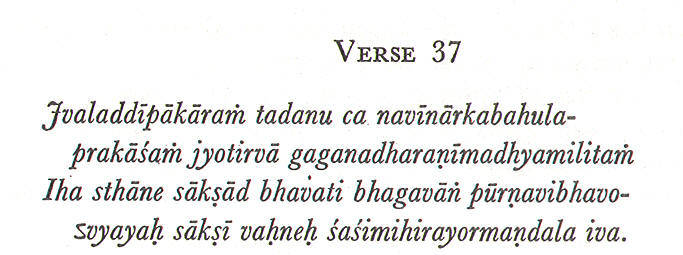
37.JvaladdIpākāraṁ tadanu ca navīnārkabahula-
prakāśaṁ jyotirvā gaganadharaṇīmadhyamilitaṁ
Iha sthāne sākşad bhavati bhagavāṅ pūrṇavibhavo-
svyayaḥ sākşi vaḥneḥ śaśimihirayormaṇdala iva.
He then also sees the Light1 which is in the form of a flaming lamp. It is lustrous like the clearly shining morning sun, and glows between the Sky and the Earth2 . It is here that the Bhagavan manifests Himself in the fullness of His might3 . He knows no decay, and witnesseth all, and is here as He is in the region of Fire, Moon, and Sun4 .
Swami Purnananda talks about Ajna Chakra from Verse 32 to 38.
COMMENTARY
Yogis such as these see other visions beside the sparks of light, After seeing the fiery sparks they see the light.5
(tadanu)-i.e = "Then" after seeing the sparks spoken of in the preceding Sloka. He then describes this Light (Jyotih).
gagana-dharaṇī madhya-militaṁ = " Glows between the Sky and the Earth".-This compound adjective qualifies Jyotil) or Light.
Light1 = Jyotih
Earth2 = See Commentary, post.
His might3 = Purna-vibhava, which, however, as Kalicarana points out post, may be interpreted in various ways. According to Visvanatha, the second chapter of the Kaivalya-Kalika-Tantra contains a verse which says that the presence of the all-pervading Brahman is realized by His action, as we realize the presence of Rahu by his action on the sun and moon.
Fire, Moon, and Sun4 = That is, the triangle on Manipitha within the A-ka-tha triangle. See v. 4 of the Padukapancaka,
the light.5 = The practicle va in the text is used in an inclusive sense. (Practicle = ? participle.)
More on A-Ka-Tha Triangle.
Sabdabrahman (Sound Brahman) is Clinical Brahman or God or Goddess, meaning that He or She is not the impalpable, invisible entity but the palpable, visible entity which is the entire breathing pulsating universe. Everything you see, hear, feel, taste, and touch, the forces of nature, the universe beyond this earth are all goddess. Kamakala is that Sabdabrahman with three saktis: creation, maintenance and destruction. It is the abode of power (Sakti--AbalAlayam = AbalA + Alayam = Sakti + abode). This Sakti is represented by an inverted triangle, the sides being Will, Action and Knowledge. These three entities cannot be put in any other form except a triangle. They are distinct in its parts and yet parts of the whole. The triangle has three corners occupied by three Bindus: VAhini Bindu, fire; Chandra Bindu, Moon; Surya Bindu (Sun). These lines are also called Sakti Vama (creation), Sakti Jyesthi (maintenance) and Sakti Raudri (destruction). The Saktis "sprout from three Bindus." The associated deities are Brahma, Vishnu and Rudra with their respective spouses; gunas, Rajas, Sattva and Tamas; and related portfolios. The lines of the triangle are formed by 48 letters of Sanskrit alphabet starting with Vowels A. The 16 Vowels form one line; the 2nd line is that of 16 consonants starting with Ka; the 3rd line is that of 16 Consonants starting with Tha; thus, the triangle is called A-Ka-Tha Triangle. These lines are also called Vama line, Jyesta line, and Raudri line. The line of Fire is Rajasic Vama line; the line of Moon is Sattvic Jyesta line; the line of Sun is Tamasic Raudri line. This inverted triangle has A at its apex, Ka at the right corner and Tha at the left corner. The remaining alphabets, ha, la, ksha are in the inside corners of the triangle. Sabdabrahman is represented by this triagular kamakala (AbalAlaya = Abode of Sakti). See the diagram below.

37.JvaladdIpākāraṁ tadanu ca navīnārkabahula-
prakāśaṁ jyotirvā gaganadharaṇīmadhyamilitaṁ
Iha sthāne sākşad bhavati bhagavāṅ pūrṇavibhavo-
svyayaḥ sākşi vaḥneḥ śaśimihirayormaṇdala iva. Continued
gagana (sky) is the sky or empty space above Sankhini-Nadi (see verse 40, post), and Dharani (Earth) is the Dhara-mandala in the Muladhara. This light also extends from the Muladhara to the Sahasrara.
He next speaks of the presence of Parama-Siva in the Ajna-Cakra. www.bhagavadgitausa.com/Sat-Chakra-Nirupana-Kundalini Chakras.htm
" It is here" (Iha sthāne)-i.e., in the Ajna-Cakra; Parama-Siva is here, as in the Sahasrara. Bhagavan is Parama-Siva.
" Manifests Himself" (sākşad bhavati)-i.e., He is here1.== (He is seen here.)
"In the fullness of his might" (pūrṇa-vibhava)--This compound word which qualifies Bhagavan is capable of various interpretations.
Purna-vibhava may also be interpreted in the following different ways:
(a) Purna may mean complete in Himself, and vibhava infinite powers, such as the power of creation, etc. In that case the word would mean: "One who has in Him such powers, who is the absolute Creator, Destroyer, and Supporter of the Universe."
(b) Vibhava, again, may mean" the diversified and limitless creation," and purna "all-spreading". In this sense Purna-vibhava means "He from whom this all-spreading and endless (vast) creation has emanated." Cj." From whom all these originated, and in whom having originated they live, to whom they go and into whom they enter" (Sruti2).---> (Tait. Up., 3. 1. 1.)
(c) Vibhava, again, may mean: "omnipresence," and Purna "all-spreading". It would then mean: " He who in His omnipresence pervades all things."
(d) Puma3 may also mean the quality of one whose wish is not moved by the result and is not attached to any object. Purna-vibhava would then mean one who is possessed of that quality. Puma3 = Phalanupahita-visayitanaspadecchakatvam: He whose wish is not moved by the result, and is not attached to any object; or in other words, He whose ways are inscrutable to us, subject as we are to limitations (Maya).
All things except Atma pass away. The omnipresence of the ethereal region (Akasa), etc., is not ever-existent. The Nirvana-Tantra (Ch. IX) speaks of the presence of Parama-Siva in the Ajna-Cakra in detail.
--------------------------------------------------------------------------------------------------------------------------
" Above this (i.e., Visuddha) Lotus is Jnana Lotus, which is very difficult to achieve; it is the region1 of the full moon, and has two petals." Again: "Inside it, in the form of Hamsah, is the Bija of Sambhu "; and again: "Thus is Hamsah in Mani-dvipa2 and in its lap is Parama-Siva, with Siddha-Kali3 on his left. She is' the very self of eternal Bliss." By lap is meant the space within the Bindus which form the Visarga at the end of Hamsah.4
So it has been said in describing the Sahasrara: "There are the two Bindus which make the imperishable Visarga.5 In the space within is Parama-Siva." As It is in the Sahasrara so It is represented here.6
We are to understand that these two, Siva and Sakti, are here in union (Bandhana) in the form of Parabindu, as the letter Ma (Makaratma), and that they are surrounded (Accadana) by Maya.7 "She the Eternal One stays here (Ajna-Cakra) in the form of a grain of gram8," and creates beings (Bhutani)." Here the Parama-Siva as in the form of a gram dwells, and according to the Utkaladimata9 also creates.
" As He is in the region of Fire, Moon and Sun" vaḥneḥ śaśimihirayor maṇdalamiva (Vahneh sasimihirayor mandalamiva)-As the presence of Bhagavan in these regions is well known, so is He here. Or it may be that the author means that as He in the shape of a grain of gram dwells in the regions of Fire, Moon, and Sun, in the Sahasrara, so does He dwell here also. We shall describe the Arka, Indu, and Agni Mandala in the Sahasrara later. In Pitha-puja the Puja. of Paramatma and Jinanatma should be performed on the Mandalas of Sun (Arka) , Moon (Indu), and Fire (Agni). By Paramatma ParamaSiva is meant, and by Jaanatma Jaana-Sakti. The Bindu should be meditated upon as like the grain of gram, consisting of the inseparable couple namely Siva and Sakti. (The grain referred to is divided in two under its encircling sheath--two cotyledons.
it is the region1 = Purna-candrasya mandalam,
Mani-dvipa2 = The isle of gems in the Ocean of Ambrosia. The Rudra-Yamala says that it is in the centre of the Ocean of nectar outside and beyond the countless myriads of world systems, and that there is the Supreme abode of Sri-vidya.
Siddha-Kali3 = A form of Sakti.
Hamsah.4 =, the two dots which form the aspirate breathing at the end of Hamsah.
Visarga.5 = Imperishable visarga-Visargariipam avyayaril.
It is represented here.6 = That is, the Para-bindu is represented in the Ajiia by the Bindu of the Omkara, which is its Pratika.
Maya.7 = Bindu is the nasal sound of Ma, which is a male letter. Bindu is here the unmanifest Ma.
grain of gram8 =CaI,lakakara-riipiI,li. See Introduction. Apparently a school of that name.
Utkaladimata9 = Apparently a school of that name.
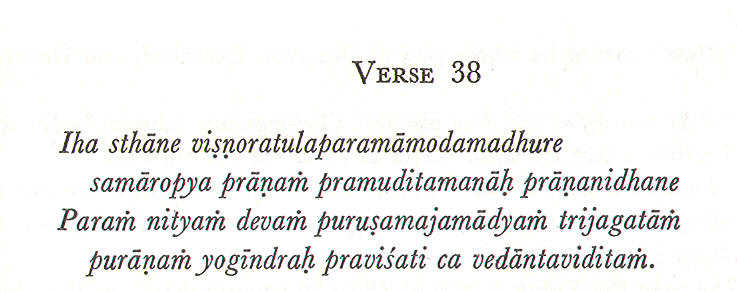
38.Iha sthāne vişṇoratulaparamāmodamadhure
samāropya prāṇaṁ pramuditamanāḥ prāṇanidhane
Paraṁ nityaṁ devaṁ puruşamajamādyaṁ trijagatāṁ
purāṇaṁ yogīndraḥ praviśati ca vedāntaviditaṁ.
This is the incomparable and delightful abode of Visnu. The excellent Yogi at the time of death joyfully places his vital breath (Prana)1 here and enters (after death) that Supreme, Eternal, Birthless, Primeval Deva, the Purusa, who was before the three worlds, and who is known by the Vedanta. presentation: Veeraswamy Krishnaraj
Swami Purnananda talks about Ajna Chakra from Verse 32 to 38.
(Prana)1 = Compare, Bhagavad-Gita, Ch. VIII, vv, 9 and 10, and the commentary of Samkaracarya and Madhusadana-Sarasvatl on those verses.
Bhagavad-Gita
Prāna is life and breath; Purusum is the Supreme
Person; Divyam is divine. This particular moment in the life and times of a
yogi is penultimate. He is in full control of himself and concentrates his
attention and life-breath on the glabellar locus. According to the Kundalini
yoga, the glabellar plane is the Ajna Chakra, which is the seat of the mind.
The yogi who rises to this level of attainment resolves (burns) all previous
prārabda karmas, receives Vijnāna or the intuitional wisdom and
knowledge, and earns liberation in this life: This is jivan mukti (liberation
while alive); and he becomes one with the divine. Such a person is Ramana
Maharishi.
Go to Kundalini Power for details. Glabella = spot in the forehead between the eyebrows.
8.11: I shall briefly explain to you the path,
which the Veda Vidahs call Imperishable (Aksaram), desiring which the ascetics
practice bramacharya. They enter Aksaram by freeing themselves from passion.
Veda Vidhas are those proficient in Vedas. Aksara is the
imperishable word AUM. Brahmacharya or
celibacy is one of the angas, limbs, or steps that an ascetic has to climb,
before he can be called an ascetic.
The
angas are eight in all:
(1) Yama, Abstinence
(2) Niyama, Restraint (Dos)
(3) Asana, Body Postures
(4) Prānayama, Breath Control
(5) Pratyahara, Abrogation of contact with sense objects
(6) Dharana, Concentration
(7) Dyana, meditation
(8) Samādhi, Union or Absorption
38.Iha sthāne vişṇoratulaparamāmodamadhure
samāropya prāṇaṁ pramuditamanāḥ prāṇanidhane
Paraṁ nityaṁ devaṁ puruşamajamādyaṁ trijagatāṁ
purāṇaṁ yogīndraḥ praviśati ca vedāntaviditaṁ.
COMMENTARY
He now speaks of the good to be gained by giving up the Prana by Yoga in the Ajna-Cakra.
This verse means: The excellent Yogi (Yogindra) at the time of death (prāṇa-nidhane) joyfully (pramudita-manāḥ) places his Prana (prāṇaṁ samāropya) in the abode of Visnu in the Ajna-Cakra (Iha sthāne vişṇoh--i.e., in the abode of Bhagavan in the Bindu already described), and passes away, and then enters the Supreme Purusa.
" At the time of death" (prāṇa-nidhane)., feeling the approach of death.
"Joyfully" (pramudita-manāḥ)-Glad in mind in the enjoyment of the blissful union with Atma. (Atmanandena hrsta-cittah.)
" Visnu"=Bhagavan=Parama-Siva (see previous Sloka).
" Here" (Iha sthāne-i.e., in the Bindu in the Ajna-Cakra spoken of above).
"Places the Priina here" (Iha sthāne prāṇaṁ samāropya)-i.e., he places it on the Bindu already spoken of. He describes Purusa as Eternal.
----------------------------------------------------------------------------------------------------------------------
Paraṁ nityaṁ devaṁ puruşamajamādyaṁ trijagatāṁ
purāṇaṁ yogīndraḥ praviśati ca vedāntaviditaṁ. (38)
" Eternal" (nityam).-Indestructible (VinaSarahitarm).
" Birthless" (aja).
" Primeval" (purāṇa).-He is the one known as the purāṇa Purusa1
" deva" means he whose play is Creation, Existence, and Destruction.
" Who was before the three worlds" (tri-jagatāṁ ādyaṁ)2 -By this the implication is that He is the Cause of all as He preceded all.
"Known by the Vedanta" (vedānta-vidita)3 -Vedanta are sacred texts dealing with the inquiry concerning the Brahman. He is known by a Knowledge (Jnana) of these.
The way the Prana is placed (Pranaropana-prakara) in the place of Visnu is described below: Knowing that the time for the Prana to depart is approaching, and glad that he is about to be absorbed into the Brahman, the Yogi sits in Yogasana and restrains his breath by Kumbhaka. He then leads the Jivatma in the heart to the Muladhara, and by contracting the anus4 and following other prescribed processes rouses the Kundalini, He next meditates upon the lightning-like, blissful Nada which is threadlike and whose substance is Kundali (Kundalini-maya), He then merges the Hamsa which is the Paramatma in the form of Prana5 in the Nada, and leads it along with the Jiva through the different Cakras according to the rules of Cakra-bheda to Ajna-Cakra. He there dissolves all the diverse elements from the gross to the subtle, beginning with Prthivi, in Kundalini. Last of all, he unifies Her and the Jivatma with the Bindu whose substance is Siva and Sakti (Siva-Sakti-maya); which having done, he pierces the Brahma-randhra and leaves the body, and becomes merged in the Brahman.
1 Purana Purusa1 According to Samkara, it is an adjective, and means "He who is the cause of Creation," and the like.
2 tri-jagatāṁ ādyaṁ)2 That is, the three spheres Bhuh, Bhuvah, Svah, the Vyahrtis of the Gayatri.
3 vedānta-vidita3 Samkara reads Vedanta-vihita, and explains the expression to mean this is the teaching of the Vedanta".
4 by contracting the anus4 GudariI akuncya-that is, by Asvini-Mudra.
5 form of Prana5 Pranarupa-svasa-paramatmakam. See Jnana-arnava- Tantra, Ch. XXI, "VV. 13-18.

|
Nadi |
meaning |
nature |
Energy |
Therm |
origin |
Terminus |
River |
Brain |
psychology |
|
Ida |
Comfort |
Lunar |
Female Energy |
Cool white |
Rt testicle |
left nostril |
Yamuna |
Rt. Brain |
Introvert |
|
Pingala |
Tawny |
Solar |
male |
Red--hot |
left testicle |
Rt Nostril |
Ganga |
lt.Brain |
Extrovert |
|
Nadi |
Color |
mode |
Metabolism |
eye |
mode |
mind |
Sense |
psychosomatic |
personality |
|
Ida |
White |
Tranquility |
anabolic |
Left |
Sattvic/Tamas |
Emotional |
Intuitive |
Mind |
obverse |
|
Pingala |
Red |
Action |
Catabolic |
Right |
Rajasic |
Rational |
Verbal |
Body |
Reverse |
|
|
|
|
|
|
|
|
|
|
|
|
Nadi |
dominance |
Polarity |
Polarity |
State |
Organs |
Nectar |
body |
Siva-Sakti |
Brain |
|
Ida |
Chita |
Negatine |
Yin |
Static |
Janendriyas |
Nectar |
nourishment |
Sakti Form |
Right brain |
|
Pingala |
Prana |
positive |
Yang |
Dynamic |
Karmendriyas |
Non-nectar |
digestion |
Rudra Form |
Left brain |
|
Nadi |
personality |
In or Out |
hearing/vocal |
Bija Mantra |
ANS:Autonomic nervous system |
ANS |
Locus |
Dominance |
|
|
Ida |
Type B |
Introspection |
listener |
Tha |
parasympathetic |
Relaxation |
Occipital lobe |
Sensory |
|
|
Pingala |
Type A |
Extroversion |
talker |
Ha |
Sympathetic |
Fight/Fright |
Frontal cortex |
Motor |
|
SUMMARY OF THE AJNA CAKRA, VERSES 32 TO 38
The Ajna Cakra has two petals and is white. The letters Ha and Ksa, which are white,1 are on the two petals. The presiding Sakti of the Cakra, Hakini, is in the pericarp. She is white, has six red-coloured faces each with three eyes, and six arms, and is seated on a white lotus. With Her hands She displays Vara-mudra and Abhaya-mudra,2 and holds a Rudraksa rosary, a human skull, a small drum, and a book. Above Her, within a Trikona, is Itara-Linga, which is lightning-like, and above this again, within another Trikona, is the inner Atma (Antar-atma), lustrous like a flame. On its four sides, floating in air, are sparks surrounding a light which by its own lustre makes visible all between Mula and the Brahmarandhra. Above this, again, is Manas, and above Manas, in the region of the Moon, is Hamsah, within whom is Parama-Siva with His Sakti.
(Here ends the sixth section)
[Visvanatha,3 in the Commentary to the Satcakra, gives under this verse a description, taken from the Svacchanda-samgraha, of the region beyond the Ajna-that is, beyond the Samasti or collective or cosmic Ajna: " Within the Bindu is a space a hundred million Yojanas 4 in expanse, and bright with the brightness of ten million suns. Here is the Lord of the State beyond Santi (Santyatitesvara), with five heads and ten arms and lustrous as a mass of lightning flashes. On His left is Santyatita Manonmani. Surrounding them are Nivrtti, Pratistha, Vidya, and Santi.5. Each of these is adorned with a moon and has five heads and ten arms. This is Bindu-Tattva. Above Bindu is Ardha-candra, with the Kalas of the latter-namely, Jyotsna, Jyotsnavati, Kanti, Suprabha, Vimala. Above Ardha-candra is Nibodhika, with the Kalas of the latter-Bandhati, Bodhini, Bodhii, Jnana-bodha, Tamo'paha. . Above Nibodhika is Nada and its five KalAs-Indhika, Recika, Ordhvaga, Trasa, and Parama. On the lotus above this last is Isvara, in extent a hundred million Yojanas, and lustrous as ten thousand moons. He is five-headed, and each head has three eyes. His hair is matted, and he holds the trident (Sula). He is the one who goeth upwards (Urdhva-gamini), and in His embrace (Utsanga) is the Kala Urdhva-gamini."]
white,1 = Karbura = white, and also means variegated.
Vara-mudra and Abhaya-mudra,2 = V. p. 337 ante.
Visvanatha,3The portion in brackets is my note.-A. A.
Within the Bindu is a space a hundred million Yojanas 4 = A Yojana is over eight miles.
Nivrtti, Pratistha, Vidya, and Santi.5 = See, as to the Kalas, Introduction to Vol. III, Tantrik Texts, ed. Avalon. See also Introduction to this volume; and The Garland of Letters.

39. Layasthānaṁ vāyostadupari ca mahānādarūpam śivārdhaṁ
sirākāraṁ śāntaṁ varadamabhayaṁ śuddhabuddhiprakāśaṁ
Yadā yogī paśyed gurucaraṇayugāmbhōjasevāsuśīlas-
tadā vācāṁ siddhiḥ karakamalatale tasya bhūyāt sadaiva.
When the actions of the Yogi are, through the service of the Lotus feet of his Guru, in all respects good, then he will see above it (i.e., Ajna-Cakra) the form of Mahanada, and will ever hold in the Lotus of his hand the Siddhi of Speech1. The Mahanada, which is the place of dissolution of Vayu2 is the half of Siva, and like the plough in shape3, is tranquil and grants boons and dispels fear, and makes manifest pure Intelligence (Buddhi)4.
Layasthanam vāyostadupari ca mahānādarupaṁ śivārdhaṁ
sirākāraṁ śantaṁ varadamabhayaṁ śuddhabuddhiprakāsaṁ
Yadā yogi paśyed gurucaraņayugāmbhōjasevāsuśīlas-
Tadā vācām siddiḥ karakamalatale tasya bhūyāt sadaiva.
WHEN the actions of the Yogi are, through the service of the Lotus feet of his Guru, in all respects good, then he will see above it (i.e., Ajna-cakra) the form of the Mahanada, and will ever hold in the Lotus of his hand the Siddhi of Speech.1 The Mahanada, which is the place of dissolution of Vayu 2 is the half of Siva, and like the plough in shape, 3 is tranquil and grants boons and dispels fear, and makes manifest pure Intelligence (Buddhi). 4
Siddhi of Speech.1 = That is, all powers of speech.
dissolution of Vayu 2 = Vayoh layasthanam. Samkara defines it by saying: Etat sthanam vayoh virama-bhutam-this is the place where Vayu ceases to be.
the plough in shape, 3 = That is, Siva is Hakara; and if the upper part of Ha is removed, the remaining portion of the letter has the form of an Indian plough.
pure Intelligence (Buddhi). 4 = Suddha-buddhi-prakasa.
pure Intelligence (Buddhi). 4 = Karanavantara-sarira, Karana=cause; Avantara = secondary or intermediate or inclusive; Sarira=body. Body is so called because it wastes and fades. It is derived from the root Sri, to wane. Karanavantara-sarira would thus mean" the intermediate Sarira of the Cause ". The primary cause is the Great Cause. Its effects are also intermediate causes of that which they themselves produce; they are thus secondary or intermediate causal bodies. Taking the Sakala-Paramesvara to be the first cause, Mahanada is one of its effects and a Karanavantara-sarira as regards that which it produces and which follows it.
COMMENTARY
He now wishes to describe the intermediate causal body (Karana-vantara-sarira) situate above Ajna-Cakra and below Sahasrara and says: When the actions of the Yogi are, through the service of the Lotus feet of his Guru, in all respects good-that is, when he excels by intense concentration of the mind in Yoga practice-he then sees the image of Maha-nada above it (above Ajna-Cakra), and he becomes accomplished in speech (Vak-siddha).
Kāranā-vāntara-śarīra = Karana = cause; AvAntara = secondary or intermediate or inclusive; Sarira = body. Body is so called because it wastes and fades. It is derived from the root SrI, to wane. Kāranā-vāntara-śarīra would thus mean "the intermediate sarira of the cause". The primary cause is the Great Cause. Its effects are also intermediate cause of that which themselves produce; tehy are thus secondary or intermediate causal bodies. Taking the sakala-paramesvara to be the First Cause, Mahanada is one of its effects and a Kāranā-vāntara-śarīra as regards that which it produces and which follows it.
"Actions in all respects good" (suśīla).-The good inclination for Yoga practice rendered admirable by strong and undivided application thereto. This result is obtained by serving the Guru.
The author then qualifies Nada, and says it is the place of dissolution of Vayu (vāyor-Laya-sthanam). The Rule is "things dissolve into what they originate from." Hence, although in Bhūta-suddhi and other practices it has been seen that Vāyu dissolves into Sparśa-tattva,l and the latter in Vyoma:"2 Vayu dissolves in Nada also. We have the authority of Revelation (Sruti) for this:
" Prthivi, the possessor of Rasa (Rasa-vati), originated from I-kara.3 From Ka-kara,3 who is Rasa, the waters and Tlrthas4 issued; from Repha (Ra-kara)3 originated Vahni-tattva5; from Nada3 came Vayu6 which pervades all life (Sarva-Pranamaya). From Bindu3 originated the Void7 which is empty of all things and is the Sound-container. And from all these8 Issued the twenty-five Tattvas which are Guna-maya, All this Universe (Visva), which is the mundane egg of Brahma, is pervaded by Kalika."
Sparsa-tattva,l = The "touch principle," also called Tvak-tattva. As to Bhutasuddhi, see the same described in Author's "Introduction to TantraSastra ".
Vyoma2 Ether.
I-kara3; Ka-kara3; Repha (Ra-kara)3; Nada3: The Bija Krim is here being formed, Kakara = Kali ; Ra-kara= Brahma as fire; Ikara= Mahamaya, Anusvara or Candra-bindu (m) is divided into two-viz., Nada, which is Visvamata, or Mother of the Universe; and Bindu, which is Duhkha-hara, or remover of pain (Bijakosa) .
Alpha is for A; likewise Ka-kara is for Ka.
Tlrthas4 = Places of pilgrimage where the devotees bathe. It also means sacred waters.
Vahni-tattva5 = Fire.
Vayu6 = Air.
Void7 = Gagana or Ether.
From all these8 That is, from KrIm as composed of Ka+Ra+I+m.
39. Layasthanam vāyostadupari ca mahānādarupaṁ śivārdhaṁ
sirākāraṁ śantaṁ varadamabhayaṁ śuddhabuddhiprakāsaṁ
Yadā yogi paśyed gurucaraņayugāmbhōjasevāsuśīlas-
Tadā vācām siddiḥ karakamalatale tasya bhūyāt sadaiva. --39
We should therefore realize in our mind that at the time the letters of the Kim-mantra1 are merged into that which is subtle, VAyu is absorbed in Nāda.
" Half of Siva" (śivārdha).-By this is meant that here Siva is in the form of Arddha-narisvara, Half is Sakti which is Nāda.
Like a Plough" (sirākāra).-The word Sirā is spelt here with a short i, and in Amara-Kośa it is spelt with a long ī but it is clearly the same word, as it begins with a dental s.
Cf. " Above it is Mahanāda, in form like a plough, and lustrous (Isvara-Kartikeya-Sarṁvāda).2
If the text is read as "Sivākāra instead of Sirākāra," then the meaning would be that the Nāda is śiva-śaktimaya.3
Cf. Prayoga-sāra: "That Sakti which tends towards seat of Liberation4 is called male (Puṁrūpā-that is, Bindu) when, quickened by Nāda, She turns towards Siva5 (śivon-mukhi)," It is therefore that RaghavaBhatta has said that " Nāda and Bindu are the conditions under which She creates ".6
It has elsewhere been said: "She is eternal7 existing as Cit (Cinmātrā)8: when being near the Light She is desirous of change, She becomes massive (Ghaņi-bhūya) and Bindu."
1 Kim-mantra1 = Krīn,
2 (Isvara-Kartikeya-Sarṁvāda). i.e., Sammohana-Tantra. Ed., R. M. Chattopadhyaya,
3 Nāda is śiva-śaktimaya.3 = That is, its substance is Siva and Sakti,
4 Liberation4 = Nirāmaya-padōnmukhī = She who is turned to the place of Liberation: that is Sakti in the supreme state.
5 She turns towards Siva5 = Tending towards, intent on, or with face uplifted to, Siva, that is here tending to creation. That is, the first state is Cit. Nāda is the Mithah-samavāya of Sakti or Bindu, The establishment of this relation quickens Her to turn to Siva for the purpose of creation when She appears as male, or Bindu. Mithah-samvāya = Mutual agreement or obligation.
6 She creates ".6 = Tasyā eva shakter nādabindū sriṣtyupayogyarūpau (Upayoga is capacity or fitness for creation).
7 She is eternal7 = According to another reading this part would mean "She who is the Tattva".
8 (Cinmātrā)8: = She is there, existing as Cit, with whom she is completely unified. She" measures Cit "-that is, co-exists with and as Cit, and is also formative activity. The above translation is that of the text, but the verse has been quoted elsewhere as if it were Cinmātrajyotiṣah, and not Cinmātrā jyotiṣah, in which case the translation would be: "She who when near Jyotih, which is mere consciousness, becomes desirous of change, becomes massive and assumes the form of Bindu."
So in the word of the honoured (Srimat) Acarya: 1" Nada becomes massive and the Bindu." Now, taking all these into consideration, the conclusion is that Sakti manifests Herself as Nada-bindu, like gold in ear-rings made of gold.2
Nada and Bindu again are one-that is the deduction.
1 Samkaracarya,
2 made of gold.2 =That is, they are both gold in the form of an ear-ring. CJ. Chandogya Up., 6. 1. 4. "Gentle One, by one lump of clay all things made up of clay are known. The variation is in the names given to it when spoken about. The clay alone is real."


40. Tadūrdhve śaṅkhinyā nivasati śikhare sūnyadeśe prakāśaṁ
visargādhaḥ padmaṁ daśaśatadalaṁ pūrņacandrātiśubhraṁ
Adhōvaktraṁ kāntam taruņaravikalākāntikiñjalkapuñjaṁ
ḷakārādyairvarņaiḥ pravilasitavapuḥ kevalānandarūpaṁ.
Above all these, in the vacant space1 wherein is Sankhini Nadi, and below Visarga is the Lotus of a thousand petals2. This Lotus, lustrous and whiter than the full moon, has its head turned downward. It charms. Its clustered filaments are tinged with the colour of the Voung Sun. Its body is luminous with the letters beginning with A, and it is the absolute bliss.3
The Acarya enjoins that Sadhakas who wish to practise Samadhi Yoga" should before such time with every consideration and effort dissolve .all things in their order from the gross to the subtle in Cidātmā ".4 All things, both gross and subtle, which make up creation should first be meditated upon. As the knowledge thereof is necessary, they are here described in detail. presentation: Veeraswamy Krishnaraj
1 in the vacant space1: This place is called the Supreme Ether (Parama-Vyoma) in the Svacchanda-samgraha, cited by 'Visvanatha. Parama-vyoma is the name given in the Pancaratra to the Highest Heaven or Vaikuntha, See Ahirbhudhnya, 49.
2 Lotus of a thousand petals2: The Sahasrāra is called Akula, according to the Svacchanda-samgraha, cited by Visvanatha.
3 the absolute bliss.3 : Kevalananda-rupam, i.e., Brahman Bliss.
4 Cidātmā ".4 :The Atmā considered as Cit.
-----------------------------------------------------------------------------------------------------------------------------
The five gross elements--Prthivi0 and so forth--have been spoken of as being in the five Cakras from Muladhara to Visuddha. In the Bhumandala1 in the Mūladhara there are the following-viz., feet, sense , of smell, and Gandha-tattva,2 for this is their place. In the jala-mandala.3 similarly, are the hands, sense of taste, and Rasa-tattva.4 In the Vahni-mandala5 are the anus, the sense of sight, and Rupa-tattva.6 In the Vayumandala,7 are the penis, sense of touch, and Sparsa-tattva.8 In the Nabho-mandala9 are speech, the sense of hearing, and Sabda-tattva.10 These make fifteen tattvas. Adding these fifteen to Prthivi and so forth we get twenty gross tattvas,
We next proceed to the subtle forms. In the Ajna-Cakra the subtle manas has been spoken of. Others have been spoken of in the Kankalamalini-Tantra (Ch. II) when dealing with the Ajna-Cakra: "Here constantly shines the excellent Manas, made beautiful by the presence of the Sakti Hakini, It is lustrous, and has Buddhi11 Prakrti,12 and Ahamkara13 for its adornment."
From the above the presence of the three subtle forms-viz., Buddhi, Prakrti, and Ahamkara--in this place becomes clear. We must, however, know that Ahamkara is not placed in the order shown in the above quotation. We have seen that from the Mūladhara upwards the generated is below the generator; that which is dissolved is below what it is dissolved into, and we also know that the Sabda-krama is stronger than Pāta-krama.14 We must remember that Vyoma is dissolved in Ahamkara, and hence the latter is next above Vyoma. Cf. " In Ahamkara, Vyoma with sound should be dissolved, and Ahamkara again in Mahat." Ahamkara, being the place of dissolution, comes first above Vyoma Ether), and above it are Buddhi and Prakrti.
The Sarada-tilaka (I. 17, 18) speaks of their connection as Janya (effect, generated, produced substance) and Janaka (cause, generator, substrate).
"From the unmanifest (Avyakta) Mula-bhūta, Para-vastu15 when Vikrta originated Mahat-tattva.15 which consists of the Gunas and Antahkarana, From this (Mahat-tattva) originated Ahamkara, which is of three kinds according to its source of generation."16 By Vikrti which means change is here meant reflection or image (Prati-bimba)17 of the Para-vastu, and as such reflection it is Vikrti ; but as it is the Prakrti of Mahat-tattva, etc., it is also called Prakrti.18 Cf." Prakrti is the Paramā (Supreme) Sakti, and Vikrti is the product thereof."(Vikrtih pratibimbata--in a mirror, one is seen but the image is not oneself.) It has also been shown before that the Prakrti of the Para Brahman is but another aspect of Him (Pratibimba-svarupini).
0 Prthivi0: Earth,Water, Fire, Air, Ether.
1Bhumandala1 Region of the Earth Element, or Mūladhara-Cakra.
2 Gandha-tattva,2 Smell principle or Tanmatra.
3 jala-mandala.3 Svadhistana, which is the region of Water (jala). ,
4 Rasa-tattva.4 Principle of taste.
5 Vahni-mandala5 Manipura, which is the region of Fire (Viihni).
6 Rupa-tattva.6 Principle of sight.
7 Vayumandala,7 Anahata, which is the region of Air (Vayu).
8 Sparsa-tattva.8 Principle of touch.
9 Nabho-mandala9 Visuddha, which is the region of Ether (Nabhas).
10 Sabda-tattva.10 Principle of sound.
11 Buddhi11 See next note. Intellect, discrimination
12 Prakrti,12 See Introduction, and post, Commentary. Sakti residing in Prakrti Tattva, creates objects as separate existences. the Sāṁkhya view: according to it the state of equilibrium of Sattva, Rajas and Tamas is Prakrti, which is also called Pradhana and Avyakta. This is the Supreme (Para-vastu).
13 Ahamkara13 Egoism-self-consciousness.
14 Pāta-krama.14 That is, the actual arrangement of things as compared with the order in which they are stated.
15 Para-vastu15; Mahat-tattva.15. Mahat-tattva is a Vikrti of Prakrti, The Mūlabhūta avyakta (unmanifested root-being) corresponds with the Samkhyan Mūla-prakrti. Here, as Raghava-Bhatta says, Tattvasrsti is indicated (Comm. to Ch. I, vv . 17,18 of Sarada) , and interprets (Ch. I. vv. 17, 18) thus: Unmanifest Mūlabhūta Para-vastu may mean either the Bindu or Sabda Brahman. By Vikrta is meant readiness or proneness to create (Srstyunmukha). From this Bindu or Sabda-Brahman emanates Mahat-tattva by which is meant the Padartha Mahat: which is known as Buddhi-tattva in Saivamata, This Mahat or Buddhi-tattva consists of the three Gunas--Sattva, Rajas and Tamas. That is, it includes Manas, Buddhi, Ahaṁkāra and Citta. These four are the product (Kārya) of the Gunas as cause (Kārana), and the cause (Kārana) inheres (Upacāra) in the effect (Kārya). After quoting the words of Isana-Siva, Raghava remarks that Vamakesvara-Tantra also says that from the Unmanifest Sabda-Brahman originates Buddhi-tattva wherein Sattva Guna is manifest. He then distinguishes the Sāṁkhya view according to which the state of equilibrium of Sattva, Rajas and Tamas is Prakrti, which is also called Pradhana and Avyakta. This is the Supreme (Para-vastu), From a disturbance in the equilibrium of the Gunas arises Mahat. This Mahat consists of Gunas and is the cause of the Antahkaranas, By Gunas according to this are meant the five Tanmatras, Sabda, Sparsa, etc. According to this view also from Prakrti comes Mahat and from the latter Ahamkara. www.bhagavadgitausa.com/Sat-Chakra-Nirupana-Kundalini Chakras.htm
Raghava thus shows the different ways in which the text of Sarada can be interpreted from the Sakta, Saiva and Samkhya points of view.
16 its source of generation.16 Srsti-bheda---that is, one Ahamkara is the result of the predominance of Sattva, another of Rajas, and a third of Tamas.
17 (Prati-bimba)17 That is in the sense of product. In Saiva-sakta-darsana, Mulaprakrti is itself a product of the Siva-sakti-tattva, for the Self becomes object to itself.
18 Prakrti.18 That is, as regarded from the point of view of the Para-vastu it is an effect, but regarded in relation to that which it produces it is a cause.
----------------------------------------------------------------------------------------------------------------------------
(Supreme) Sakti, and Vikrti is the product thereof."1 1 It has also been shown before that the Prakrti of the Para Brahman is but another aspect of Him (Pratibimba-svarupini).
According to Saradā-tilaka, Mahat-tattva, is the same as Buddhi.2 Isāna-Siva says: "The objective Prakrti,3 which is evolved by Sakti, is, when associated with Sattva-Guna, Buddhi-tattva. It is this Buddhi that is spoken of as Mahat in Samkhya."
Mahat-tattva consists of the Gunas and the Antah-karana, The Gunas are Sattva, Rajas and Tamas. The Saradā-tilaka says: "Antahkarana is the Manas, Buddhi, Ahamkara and Citta, of the Atma.4 All these are comprised in the term Mahat-tattva.
Now, a question may be raised--namely, if Manas be within Mahattattva, what of that which has been said in v, 33, where Manas has been spoken of as having an independent existence? But the answer to that is, that that Manas is the product of Ahamkara, and Raghava-Bhatta quotes a text which says: "In so much as the other Manas is the one which selects and rejects (Sa-semkalpa-vikalpaka),"5 it is known to be the product of Tejas."6 Thus it is that, as Manas and other Tattvas in the Ajna-Cakra are placed in their order, Ahamkara and others should be known as being placed above them. In the Ajna-Cakra are Hakini, Itara-Linga, Pranava, Manas, Ahamkara, Buddhi, and Prakrti placed consecutively one above the other. No place being assigned to Candra-mandala, which has been spoken of before, it should be taken to be placed above all these. If it be asked, why is it not below all these? then the reply is that it has been said in the Sammohana-Tantra: "Moon (Indu) is in the forehead, and above it is Bodhini Herself." From this it would appear that Indu and Bodhini are above Ajna-Cakra, placed one above the other without anything intervening between them. Bodhini is above all the rest.
1 product thereof."1 Vikrtih pratibimbatii-in a mirror one is seen but the image is not oneself.
2 Buddhi.2 Raghava-Bhatta says that this is so according to Saiva doctrine.
3 objective Prakrti,3 Boddhavya-laksana---that is, that which can be known Jneya); the objective or manifested Prakrti.
4 Atma.4 See Introduction.
5 (Sa-semkalpa-vikalpaka),"5 As to Sa-samkalpa-vikalpa, see Introduction.
6 Tejas6 That is, Taijasa ahamkara, which is the source of the Indriyas.
-------------------------------------------------------------------------------------------------------------------------------------------------------
The Sammohana-Tantra speaks of the Cause (Karanarūpa) as above Ajna-Cakra: "Indu (the Moon, here-Bindu) is in the region of the forehead, and above it is Bodhini Herself. Above Bodhini shines the excellent Nada, in form like the half (crescent) moon; above this is the lustrous Maha-nada, in shape like a plough; above this is the Kalā called Anji the beloved of Yogis. Above this last is Unmani,1" which having reached, one does not return."
In the above passage, in the words "above it is Bodhini," the word " it " stands for the forehead or Ajna-Cakra.
The Bhūta-suddhi-Tantra speaks of the existence of the Bindu below Bodhini: "Devi, above Bindu and Mātrārdhā is Nada, and above this, again, is Maha-nada, which is 'the place of the dissolution of Vayu." Mātrārdhā is Mātrārdhā-Sakti2.
The following passage from Brhat-trl-vikrama-samhitā proves that the Ardha-mātrā means Sakti: "Lustrous like the young Sun is Aksara, which is Bindumat (Bindu itself); above it is Ardha-mātrā associated with the Gāndhārarāga3."
As both the above passages point to the same thing, we must take it that Ardha-mātrā and Bodhini are identical. Bindu, Bodhini, and Nada, are but different aspects of the Bindu-maya-para-sakti,
1 Unmani,1 In this passage Ajni is Samani, The Bhūta-suddhi (see post), makes a distinction too between Ajni and Samani. These are the Avāntarasarlras of the First Cause enumerated in Laya-krama. The text quoted from the Sārada gives the Srsti-krama.
2 Mātrārdhā-Sakti2. Mātrārdhā. In the Devi Bhigavata there occurs the expression Ardhamātrā (which is a name for Nada) in I, 1, v, 55, and III, 5, v, 29, and Nllakantha defines it to mean Param padam = the supreme state, or the Brahman. The expression Ardha-matra also occurs in Candi, I, 55, in practically the same sense. Gopila Chakravarti quotes a passage which says: " Ardha-mātra is attributeless (Nirguna), and realizable by the Yogi." He quotes another passage which says: "Om--this is the three Vedas, three Lokas, and after the three Lokas, Mātrārdhā is the fourth-the Supreme Tattva," See Candl "Tvamudgithe ardhamatrasi " and Devibhāgavata, I, 5, v, 55. Sruti says: "Thou art the Ardhamatra of Pranava, Gāyatri, and Vyāhrti." Here the unity of Devi and Brahman is shown. She is Brahman united with Māya (Māya-viśita-brahmarūpini). The Nada-bindu Upanisad (v. 1) says: " A-kāra is the right wing (of Om figured as a bird), U-kara is the other (left) wing, Ma-kara the tail, and Ardhamātra the head. Sattva is its body, and Rajas and Tamas are its two feet. Dharma is its right eye and Adharma is its left eye. The Bhurloka is its feet; the Bhuvarloka its knees; the Svarloka is its middle; the Maharloka its navel; Janaloka is the heart; Tapoloka its throat, and Satyaloka the place between the eyebrows." See also Brahmavidya Up., v, 10.
3 Gāndhārarāga3 The third of the seven primary subtle tones.
------------------------------------------------------------------------------------------------------------------------------
The Sarada-tilaka says: "From the Sakala Paramesvara.1 who is Sat, Cit, and Ananda, Sakti emanated; from Sakti, again, emanated Nada; and Bindu has its origin from Nada. He who is Para-Sakti-maya manifests Himself in three different ways. Bindu and Nada and Bija are but His different aspects. Bindu is Nadatmaka,2 Bija is Sakti, and Nada, again, is the union or relation of the one to the other.3 This is spoken of by all who are versed in the Agamas4" ,
" Para-Sakti-maya ": Para=Siva; hence Siva-Sakti-maya = Bindu.
The Bindu who is above the forehead is Nadatmaka---that is, Sivatmaka5, Bija is Sakti as Bodhini (Bodhint-rupam). Nada is the connection between the two whereby the one acts upon the other; hence it is Kriya-Sakti. Above these three is Maha-nada. This has already been shown.
" Above this is Kalā," etc.: Kalā=Sakti. Anji is crooked, awry, bent, line. This is in shape like a bent or crooked line over a letter. This Sakti appeared in the beginning of creation, Cf. Pancaratra: "Having thus seen, the Supreme Male in the beginning of creation makes manifest the eternal Prakrti who is the embodiment of Sat, Cit and Ananda, in whom 6 are all the Tattvas, and who is the presiding (Adhistātri) Devi of creation.
Also elsewhere: "From the unmanifested (Avyakta) Paramesvara, the united Siva and Sakti, emanated the Adya (first) Devi Bhagavati, who is Tripura-sundari, the Sakti from whom came Nada, and thence came Bindu."
1 Paramesvara.1 Sarada, Ch. I, vv. 7-9, Sakala, as opposed to Niskala, or Nirguna, means united with Kala, which according to Samkhya is Sāmyāvasthā of the Gunas which is Prakrti, According to the Vedantists of the (MāyaVāda) , Kalā is Avidya, in the Saiva-Tantra Kalā is Sakti (RaghavaBhatta),
2 Nadatmaka,2 Another text has Sivatmaka---that is, Bindu is the Siva aspect.
3 union or relation of the one to the other.3 Samavāya ksobhya ksobhaka-sambandha---lit., connection which is the connection of reciprocity.
4 Agamas4 See Introduction.
5 Sivatmaka5 In the Benares edition as also in Rasika Mohana Chattopadhyaya's edition of the Sarada-tilaka the text reads Sivātmaka, as if qualifying Bija, which seems erroneous.
6 Sat, Cit and Ananda, in whom 6 Raghava reads: "Samasta-tattva-samghatma-spiūrtyadhisthatrirūpinim "-which means" who is the Devi presiding over or directing the evolution or manifestation of all the mass of Tattvas ".
------------------------------------------------------------------------------------------------------------------------------
" Above it is Unmani," etc.: Cf. 'By going where 'Manasness' (Manastva) of Manas ceases to be called Unmani, the attainment of which is the secret teaching of all Tantras1."
The state of Unmani is the Tattva which means the dispelling of the attachment prompted by Manas towards worldly objects.
Unmani, again, is of two kinds: (1) Nirvana-kala-rūpa which also has its place in the Sahasrara2; (2) Varnāvalī-rūpa, which also has its place in this region. Cf. Kankala-malini: " In the pericarp of the Sahasrara, placed within the circle of the moon, is the seventeenth Kala, devoid of attachments3. The name of this is Unmani, which cuts the bond of attachment to the world."
Cf. also: "By mental recitation of the Mālā-varna (rosary of letters) is Unmani the granter of Liberation (attained)." Mālā-varna = Varnāvalī-rūpa.
The Bhūta-suddhi speaks of the Samani below Unmani. "Next is the Vyapika-Sakti (Diffusive Energy) which people know as Āñjī. Samanī4 is over this, and Unmani is above all." This (Samani) also is an intermediate aspect (Avāntara-rūpa) of Parasakti.
We now get the following:
Above Ajna-Cakra is the second Bindu-which is Siva (Siva-svarūpa). Above Bindu is the Sakti Bodhini in shape like an Ardhamātrā; next is Nada which is the union of Siva and Sakti, in shape like a half (crescent) moon; next (above this) is Mahanada, shaped like a plough; above Mahanada is the Vyapika Sakti, crooked (Āñjī) in shape; above this last is Samani and highest of these all is U nmani. This is the order in which the seven causal forms (Karana-rūpa) are placed.
1Tantras1 Visvanatha, quoting Svacchanda-samgraha, which speaks of Unmani as above Samana, says that in the Unmani stage there is no cognition of and no distinction is made between Kāla and Kalā; there is no body, and no Devatas, and no cessation of continuity. It is the pure and sweet mouth of Rudra. Cf. Vrttīnaṁ manah in the Siva-Samhita, V, 219.
2 Sahasrara2 Sahasrārādharā, See introduction.
3 attachments3 Sarva-samkalpa-rahitāi.e., who is free from all attachment, not prompted by anything in any action. The passages quoted are from ch. v, Kankala-malini.
4 Samanī4 Visvanatha speaks of it as Samanā, and says that She is Cidānanda.svarūpa (that is, Cit and Ananda), and the cause of all causes (Sarva.kāraņa-kāraņam). presentation: Veeraswamy Krishnaraj
----------------------------------------------------------------------------------------------------------------------------
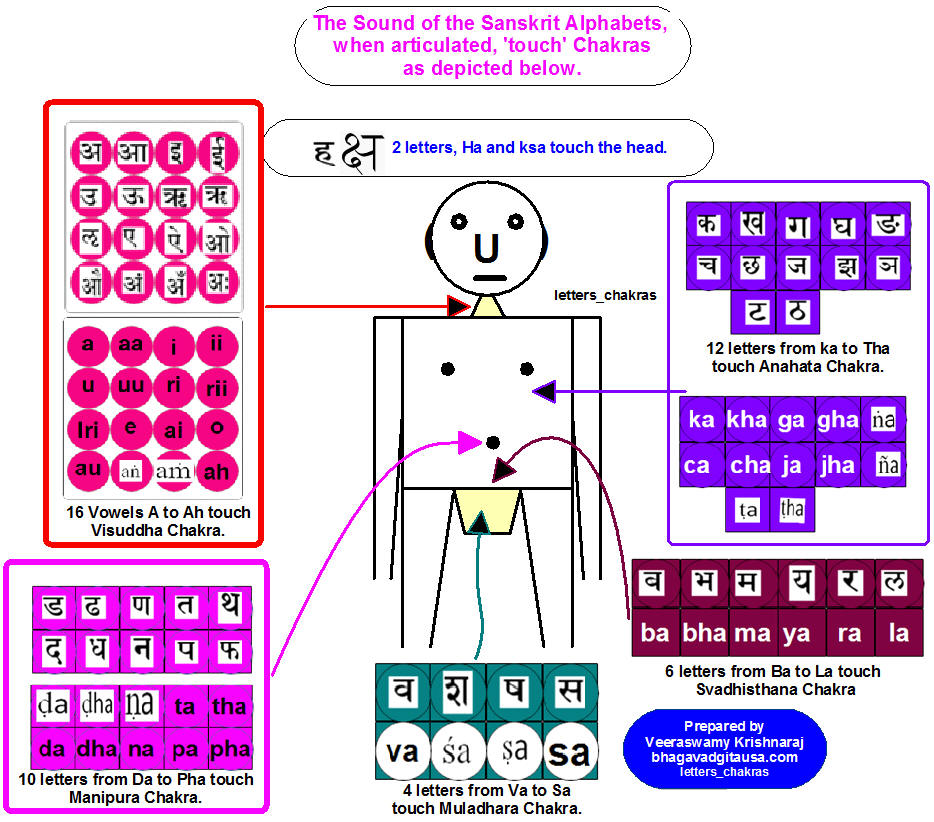
40. Tadūrdhve śaṅkhinyā nivasati śikhare sūnyadeśe prakāśaṁ
visargādhaḥ padmaṁ daśaśatadalaṁ pūrņacandrātiśubhraṁ
Adhōvaktraṁ kāntam taruņaravikalākāntikiñjalkapuñjaṁ
ḷakārādyairvarņaiḥ pravilasitavapuḥ kevalānandarūpaṁ. 40
There is no need to go into further detail. Let us then follow the text.
Wishing to describe the Sahasrara he speaks of it in ten more verses.
Above all these (Tadūrdhve).-Above every other that has been described or spoken before.
"Over the head of the Sankhini-Nadi "-a sight of which has been given to the disciple.
" Vacant space" (Sūnya-deśa)-that is, the place where there are no Nādis; the implication is that it is above where susumna ends. .
" Below Visarga is the lotus of a thousand petals."-This is the purport of the Sloka, Visarga is in the upper part of the Brahma-randhra. Cf. " (Meditate) in that aperture on Visarga the ever blissful and stainless." There are other similar passages.
" Its body is luminous with," etc. (Lalātadyaih varnaih pravilasitavapuh).-The word Lalāta stands for the first vowel, A. By this we are to understand that the second Lakāra (L) is to be left out in counting the letters of the Alphabet. In counting the fifty letters, the second Lakāra1 is always left out.
If the text is read as " Lakārādyaih varņaih," as is done by some, we must leave Ksa-kāra out in counting the letters. The fifty-one letters. cannot be taken to be in the petals of the Sahasrāra2. With fifty-one letters repeated twenty times, the number is 1,020, and repeated nineteen times is 969. By leaving out Ksakara we are freed of this difficulty. By "Lakārādyaih" is it not meant that the letters are to be read Viloma.3 The Kaṅkālamālinī in the following passage distinctly says that it is to be read Anuloma4 "The Great Lotus Sahasāra is white and has its head downward, and the lustrous letters from A-kāra (A), ending with the last letter before Ksakāra (Ksa), decorate it." Here it is distinctly stated that the letter Ksa is left out.
Akārādi-ksa-kārāntaih: This compound, ksa-kārānta, if formed by Bahu-vrīhi-samāsa5 would mean that Ksakāra is left out of calculation.
1 Lakāra1 Vaidika Lakāra (La).
2Sahasrāra2 fifty-one letters cannot be arranged in the Sahasrara,
3 Viloma.3 i.e., from end to beginning.
4 Anuloma4 From beginning to end.
5 Bahu-vrīhi-samāsa5 A form of Sanskrit verbal compound.
There is nothing said of the colour of the letters, and, as the Mātrkā (letters) are white, they are to be taken as being white on the Sahasrara petals. These letters go round the Sahasrara from right to left.1
Some read Pravilasita-tanuh in place of pravilasita-vapuh, and say that, as the word padma alternatively becomes masculine in gender (vā pumsi padmam), therefore the word Tanu, which qualifies a word in the masculine gender, is itself masculine. That cannot be. The verb Nivasati (=is, dwells) has for its nominative Padmam, and, as it ends with the Bindu (m), it is in the neuter gender and not masculine. For in that case it would have ended with visarga (i.e., h), and its adjective tanu, would also end with a visarga. The word tanu (if their reading is accepted) would be in the neuter; therefore it cannot end with a Bindu. And if there is no Bindu the metre becomes defective. Therefore the correct reading is Pravilasita-vapuh.
The rest is clear.
1from right to left.1 Daksinavarta---the opposite way to that in which the hands of a clock work.
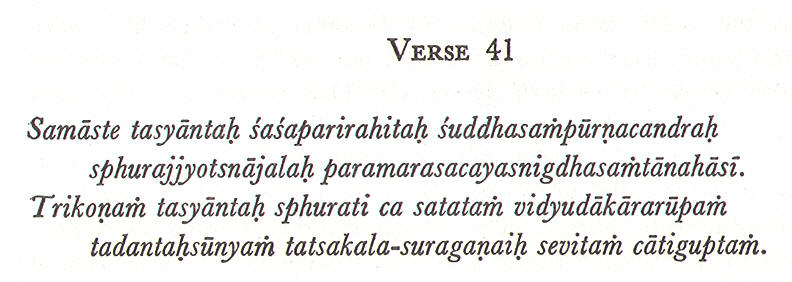
41. Samāste tasyāntaḥ śaśaparirahitaḥ śuddhasaṁpūrncandraḥ
sphurajjyotsnājalaḥ paramarasacayasnigdhasaṁtānahāsī.
Trikoņaṁ tasyāntah sphurati ca satataṁ vidyudākārarūpam
tadantahūanyaṁ tatsakala-suragaņaih sevitaṃ cātiguptaṁ.
Within it (Sahasrara) is the full Moon, without the mark of the hare1, resplendent as in a clear sky. It sheds its rays in profusion, and is moist and cool like nectar. Inside it (Candra-mandala), constantly shining like lightening, is the Triangle2 and inside this, again, shines the Great Void3 which is served by all the Suras4.
COMMENTARY
He here speaks of the existence of the Candra-mandala in the pericarp of the Sahasrara.
resplendent as in a clear sky (Suddha)---seen in a cloudless sky (nirmalo-daya-viśista)
" Is moist and cool," etc. (Parama-rasa-cāya-snigdha-santāna-hāsī). Snigdha which means moist here implies the moisture of the nectar.
1 without the mark of the hare1 The man in the moon.
2 Triangle2 The A-ka-thādi triangle according to Visvanatha.
3 Great Void3 Sūnya=Bindu-that rs, the Para-bindu, or Isvara, having as its centre the abode of Brahman (Brahmapada). In the northern Saiva and Sakta schools Sadasiva and Isvara are the Nimesa and Unmesa aspects of the experience intermediate between Siva-Tattva and Suddha-vidya, the former being called Sūnyatisūnya. The positions of the Sun and Moon circles in the Sahasrara and of the twelve-petalled lotus with the Kāmakalā are given in the Text.
4 Suras4 i.e., Devas.
Parama-rasa (Amrta) is free from heat. Hence the meaning of this compound word: Its rays are cool and moist, and produce a feeling of smilinggladness.
The Kankala-malini speaks of the presence of Antarātmā, etc., in the upper portion of the space below Candra-mandala. In dealing with the Sahasrāra, it says: "In its pericarp; O Devesi, is the Antarātmā. Above it is the Guru; The Mandalas of Sūrya and Candra are also there. Above this is Mahā-vāyu, and then the Brahmarandhra. In this aperture (Randhra) is Visarga, the ever blissful Brahman. Above this (Tadūrdhve) last is the Devi Sankhinī, who creates, maintains, and destroys."
Samāste tasyāntaḥ śaśaparirahitaḥ śuddhasaṁpūrncandraḥ
sphurajjyotsnājalaḥ paramarasacayasnigdhasaṁtānahāsī.
Trikoņaṁ tasyāntah sphurati ca satataṁ vidyudākārarūpam
tadantahūanyaṁ tatsakala-suragaņaih sevitaṃ cātiguptaṁ. --41
" Within Candra-mandala constantly shines, like lightning, the triangle ,. (Trikonam tasyāntah vidyudākāra-rūpam).- That is, the shining triangle is there.
" Inside this shines the Great Void" (Tadantah sūnyam sphurati).That which as a void within is, the body of the Para-bindu (Para-bindusarīram). Within the triangle the excellent Bindu (Sūnya) shines, or within the triangle the Sūnya which is the excellent Bindu shines.
Cf. Todala- Tantra, 6th Ullāsa: "The Supreme Light is formless (Nirākara), and Bindu is imperishable. Bindu means the void (Sūnya) and implies Guna also." 1
"Served in secret" (Sevitam cātiguptam).-The rule is, "Eating (Āhāra), evacuation (Nirāhara), sexual intercourse (Vihāra), and Yoga, should be done in secret by him who knows the Dharma." Hence Suras (Devas) serve or worship It in secret.
1Guna also." 1 When it assumes the form of Bindu, It is with the operating Gunas, or then It is Sakala.

Well concealed, and attainable only by great effort, is that subtle Bindu (Sunya) which is the chief root of liberation and which manifests the pure Nirvana-kala with Ama-Kala1. Here is the Deva who is known to all as Parama-Siva. He is the Brahman and the Atma of all beings. In Him are united both Rasa and Virasa2 and He is the Sun which destroys the darkness of nescience3 and delusion4.
Suguptaṁ tadyatnādatiśayaparammoda-saṁtānarāśeḥ
paraṁ kandaṁ sūkṣmaṁ sakalāśaśikalasuddharūpaprakāśaṁ
lha sthāne devaḥ paramaśivasamākhyānasiddhaḥ prasiddhaḥ
svarūpī sarvātmā rasavirasanutoऽiñānamohāndhahaṁsaḥ 42.
This verse describes the ascendant course of liberation of the soul, after it shed all impurities. The Yogi in his ascent from Muladhara Chakra goes to Bindu before he reaches other Saktis for merger with Siva.
COMMENTARY
The sense is that the void (Sūnya) is very secret and subtle, being, as described later, like the ten millionth part of the end of a hair. It is attainable only by great effort consisting of long and incessant performance of Dhyana and like practices. It makes manifest the purity of the sixteenth Kala of the moon along with Nirvāna-Kalā --i.e., the void (Antah-sūnya) along with the Amā Kalā and Nirvāna-Kalā within the triangle is realized (Prakāsam bhavati) by meditation (Dhyāna), It is the source of all the mass of great Bliss, which is Liberation. Some, however, read Sakalasasi-kalā-suddha-rūpa-prakāsam as qualifying the great Void within the triangle, and read 'sakala ' to mean with all the sixteen kalās and say that the Para Bindu manifests the moon with such kalās.
1 Ama-Kala1 There are seventeen Kalās (digits) of the Moon, but the nectardropping Ama and the Nirvana-kalā are only at this stage revealed. The other Kalās are mentioned in Skanda-Purana Prabhāsa-Khanda.
2 Rasa and Virasa2 The Bliss of liberation and that arising from the union of Siva and Sakti: vide post.
3 darkness of nescience3 Ajnana.
4 delusion4 Moha. This verse occurs in Tripurā-sāra-samuccaya, ch. V. 40.
This requires consideration. When it was said that the Trikona (triangle) is within the full moon, the repetition of it is useless. Furthermore, in the previous verse we have got "served by the Suras ". The term "service" as applied to a void is inappropriate. The object of service is the Bindu within the triangle. If it be said that the void should be worshipped by reason of the presence of the Para-Bindu, then the Para-Bindu being there present there is no void.
42. Suguptaṁ tadyatnādatiśayaparammoda-saṁtānarāśeḥ
param kandaṁ sūkṣmaṁ sakalāśaśikalasuddharūpaprakāśaṁ
" Well concealed" (Suguptaṁ ).-By reason of its being like the ten millionth part of a hair.
" By great effort" (Yatnāt)---i.e., by long-continued practice of meditation (Dhyana) and so forth.
"Chief root" (Param kandam.l-e-Para usually means supreme, excellent; here chief, principal. Kanda = Mūla.
" Liberation," etc., (Atiśaya-paramāmoda-samtāna-rāśi).-The compound word means, literally, continuity of all the mass of great and supreme bliss, and this is Liberation (Moksa),
"Manifests, etc., Amā-kalā " (sakala-śaśi-kalā-suddha-rūpa-prakāśam).-This compound word is to be broken up as follows:
Sakala=with the Kalā: Kalā here meaning Nirvana- Kalā, In the word Sasi- Kalā the Kalā means Amā- Kalā, the sixteenth Kalā, or digit, of the moon. Suddha=pure; the lustre is not obscured by anything.
The sense is that the Para-bindu, though subtle and otherwise imperceptible, is seen by meditation (Dhyana) with the Amā- Kalā and Nirvana- Kalā in the Trikona, If Sugopyam be read in place of Suguptarn, then it would be qualified by Yatnāt.
Some read Sakala-sasi-kalā-suddha-rūpa-prakasam. to qualify Sūnya in the previous verse, and say Sūnya means "vacant space" but that is absurd." 2
Next he speaks of the presence of Parama-Siva in the pericarp of the Sahasrāra.
1 Kanda means bulb or root. The Yoginl-hrdaya says that this Kanda is the subtle Parananda-kanda-bindu-rupa, or the root of supreme Bliss in Bindu form (Visvanatha).
2 According to the Commentator, it qualifies Kanda. Bindu is the circle O, the void is the Brahmapada or space within.
-------------------------------------------------------------------------------------------------------------------------------
lha sthāne devaḥ paramaśivasamākhyānasiddhaḥ prasiddhaḥ
svarūpī sarvātmā rasavirasanutoऽiñānamohāndhahaṁsaḥ 42.
lha sthāne devaḥ
paramaśivasamākhyānasiddhaḥ prasiddhaḥ
svarūpī
sarvātmā rasavirasanutoऽiñānamohāndhahaṁsaḥ
42.
" Paramasiva " 1 (Paramashiva-samākhyāna-siddha).-He who is known by the name Parama Siva.
" The Brahman" (Kharūpī).2-Kha=Ātmā, the spirit.
" The Atma of all beings" (Sarvātmā).-Sarva=all (beings). He is the Jivātma, but in fact there is no distinction between Jivātma and Paramātmā. The Ātmā is the Jīva. The Adhyātma Rāmāyana says:
"The Jivātma is merely another name, (Paryāya) for the Paramātma, When by the instruction of the Acārya and the Sastras their oneness is known, then the disciple possesses Mūlavidyā concerning Jivātmā and Parammātā. "
The Sruti also, when it says" That thou art "-Tat tvam asi,' identifies the Tvam (Thou) with the Tat (That).
" Rasa and Virasa" (Rasa-virasamita).-Rasa is Paramānandarasa -i.e., the experience of Supreme Bliss4. Virasa is the bliss which is the product of the union of Siva and Sakti, He is both. Or Rasa may mean the natural attachment to worldly enjoyment, and Virasa detachment from it. The meaning would then be: in Him is the Supreme Bliss arising from his detachment from worldly enjoyments5.
" The Sun " = Hamsa, As the sun dispels darkness, so does He
dispel nescience (Ajnāna) and delusion (Moha).
1 Visvanatha says that this Siva is the Saguna-Siva,
2 Cf. Sruti " Kham Brahma " Chao 4-10-5; Br. -1-1. 3" That thou art." See Introduction.
4 i.e., Moksa.
5 That is, the Rasa in Him has become Virasa.
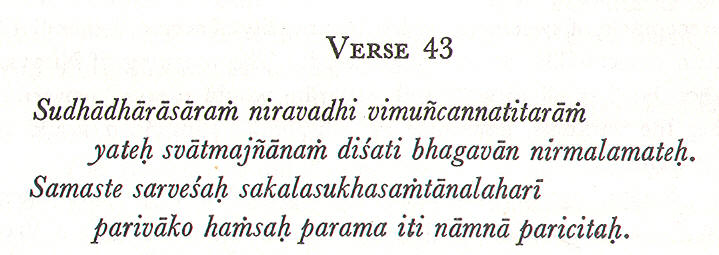
43. Sudhādhārāsāraṁ niravadhi vimuñcannatitarām
yateḥ svātmajñānaṁ diśati bhagavān nirmalamateḥ.
Samaste sarveśaḥ sakalasukhasaṁtānalaharī
parivāko haṁsaḥ parama iti niāmnā paricitaḥ. 43
By shedding a constant and profuse stream of nectar-like essence,1 the Bhagavan2 instructs the Yati3 of pure mind in the knowledge by which he realizes the oneness of the Jivatma and the Paramatma. He pervades all things as their Lord, who is the ever-flowing and spreading current of all manner of bliss known by the name of Harnsah Parama (Paramahamsah).
1Essence1 As appears from the Commentary post, this may be
variously translated as follows: "By shedding a constant and profuse
stream of nectar resembling the silvery beam of the Moon," or" By
unremitting and nectarlike words strong for the destruction of the darkness of
delusion," or " By constant repetition of the word which is
nectar-like in its mercy and contains the essence of the Brahma-mantra."
www.bhagavadgitausa.com/Sat-Chakra-Nirupana-Kundalini Chakras.htm
2 Bhagavan2 That is, the Lord as the possessor of the six forms of Aisvarya,
3 Yati3 Self-controlled, whose mind is unified with the object of worship.
COMMENTARY
"Constant and profuse" (Niravadhi atitaram).
"By shedding a stream of nectar-like essence" (Sudhā-dhārāsāram vimuñcan).-The compound word can be made up and interpreted in four different ways:
1) Shedding a stream of nectar-like essence.
2) The Adhara (receptable) of Sudha (nectar) is Sudhadhara, by which is meant the Moon ; Asara is what flows therefrom, a stream. Now, what flows from the Moon is Nectar, which is silvery; hence the whole word means "the silvery beams of the moon". This adjective proves that the qualified noun is white or transparent like the moon. Shedding = Vimuncan.
3. Asara may, again, mean" what is uttered," "word". Sudhadhara = receptacle of sweetness, which is a quality of nectar; hence Sudhadharasaram=nectar-like or ambrosial word. The meaning of Niravadhi would then be " at all times," and Atitaram would mean "powerful in destroying the darkness, ignorance or delusion." Vimuncan should then mean " uttering".
4. Sudha, again, may mean "nectar of mercy," and Sare is essence "-i.e., the essence of Brahma-mantra; and Dhara is a stream (continuous repetition) of the merciful word containing the essence of the Brahma-mantra.
yateḥ svātmajñānaṁ diśati bhagavān nirmalamateḥ. (verse 43 line 2)
" Instructs the Yati," etc., (Bhagavān nirmala-mater yateh svātma-jñānam diśati),
" Yati."-He whose mind intently rests upon the Devata of his worship.
Knowledge by which, etc., Paramātmā (svātma-jñāna): Svam= Jivatma and Atma=Paramatma; and Jnana1 that by which one knows-namely, the Taraka-brahma-mantra, which leads to a knowledge of the Paramatma, and thereby helps the worshipper to realize the oneness of the Jivatma and Paramatma. Disati = Upadisati (instructs). The above qualifying expressions imply that the qualified noun is the Guru, as instructions regarding Taraka-brahma-mantra proceed from Him. So it qualifies " Parama-Siva " in the preceding verse, as He is the Guru. Cf. Gurus-tattva-nirūpana in Lalita-rahasya,
After describing Guru as "the well-known and excellent Purusa who is ever fond2 of enjoyment with the Self (Atma-rati-priya)," it goes on to say: "His beloved is the lustrous One who may be gained with difficulty by the Brahma-vartma (Brahman road). The Para-Brahman is but the effulgence of Her lotus feet."
By the above passage is meant that the great beauty of Her lotus feet overspreads the heart-lotus of Parama-Siva who is Para-Brahman.
1 Jnana1 Jnana is spiritual knowledge or wisdom, and Vijnana is the knowledge of the material world (science).
2 who is ever fond2 i.e., who is engrossed in.
--------------------------------------------------------------------------------------------------------------------------
The place for the feet of the lustrous (Tejo-rūpa) Beloved (Sakti) of the Guru is on the breast of the Guru1 and not on that of any other Purusa. Hence Parama-Siva and the Guru are one and the same.
The Nirvana-Tantra also says 2: "In the Lotus in the head is Mahadeva---the Parama-Guru: there is in the three worlds no one, O Devesi, who is so deserving of worship as He. O Devi, meditate on His form3," which includes all the four Gurus."4
This Parama Siva is outside the triangle in the pericarp, and above the Hamsah of which we speak below.
The kankāla~mālini Tantra5 says: " In the pericarp of this Lotus, ,O Devesi, is the Antaratma, and above it the Guru. The Mandalas of Sun and Moon are also there." And after having spoken of the presence of different things in their order up to Maha-sankhinl, it then proceeds: " Below it, O Devesi, is the Trikona (triangle), placed in the Mandala of Moon; and having meditated there on the undecaying Kalā, (one should meditate within upon the 17th KalA, by name NirvAna which is like a crescent(KutilA6).
1.Guru This is in praise of Sakti, without whom Siva is Sava (a corpse, and 'unable to move.)
2Nirvana-Tantra also says 2 This passage occurs in the 3rd Patala of the Nirvana-Tantra (Rasika Mohana Chattopadhyaya's Edition, p. 3), and is in answer to the following question of the Devi: "The Deva who is in the Turiyadhama (the fourth state) is unquestionably the Paramatma ; if he be placed in the Lotus in the head, how can obeisance be made to him outwardly? " That is, How can the Sadhaka bow to him who is in the head which is itself bowed?
3 meditate on His form3 The passage as quoted by the Commentator reads "Tadamśaṁ" (his part); in R. M. Chattopadhyaya's Edition it reads "Tadrūpaṁ" (his form), which reading is here adopted.
4 Gurus."4 i.e., Guru, Parama-Guru, Parapara-Guru, and Paramesti-Guru.
5 The kankāla~mālini Tantra5 This passage occurs in Patala II (p. 3 of R. M. Chattopadhyaya's Edition), which in its entirety runs thus: "In it (Sahasrara), O Devesi, is the Antaratma, and above it Vāyu, and above Mahanada is Brahmarandhra. In the Brahmarandhra is Visarga, which is Eternal Peace and Bliss. (Peace-Niranjana, which also means stainless, free from delusion). Above it is Devi Sankhini, the Creatrix and Maintainer and Destructress . Having meditated on the Triangle placed below; He thinks that Kailāsa (the paradise of Siva) is there. O Mahadevi, by placing the undisturbed Cetas (heart or mind) here one lives in bliss to the full term of one's life (Jīva-jīvi) free from all ills, and for such a one there is no rebirth. Here constantly shines Amā Kalā which knows neither increase nor decay, and within it, again is the seventeenth digit, known as Nirvana-Kala. Within Nirvana-Kala is the flery Nibodhika. Above lt is unmanifested Nada, effulgent as ten million suns. It is the excellent Nirvana Sakti, the cause of all. In this Sakti it should be known that Siva who is changeless and free from illusion abides."
---------------------------------------------------------------------------------------------------------------------------------
6 KutilA: See Jnanarva-Tantra XXIV, 36.
Nirvana Sakti has two KalAs or Inner Force: NirvAna KalA and AmA KalA, the 17th and 16th KalAs respectively. Nirvana Sakti is both Unmani1and Samani2. Nirvana KalA is Vyapini3 or Sakti Svarupa and above the 16th KalA. Nirvana Sakti is Antargata (indweller) of Nirvana KalA. Ananda is the Bliss or Joy which arises from the union of Para (Bindu-Rupa Siva) and ParA (Sakti or Prakrti); from such union flows the nectar, of which AmA KalA is the receptacle. --Woodroffe. AmA is the one that maintains the bodies. AmA is also the Sakti (Urdhva Sakti-Rupa = Form of Sakti that moves [the soul] upwards); who propels the soul towards (upwards to) Brahman.
AmA KalA is Creative Sakti and becomes Nirvana KalA of Pure Consciousness.
NirvAna KalA
= 17th KalA = Vyapini Tattva = Sakti Svarupa = VyApini Tattva. It is the
Supreme aspect of VyApini Tattva as Vyapika. is more excellent than Ama KalA.
It is the CinmAtra SvabhAvA or Pure Consciousness aspect of AmA KalA.
AmartAkArarUpini. VyApinI = Expansive. Nirvana Sakti is the Antargata(Indweller) of Nirvana KalA.
www.bhagavadgitausa.com/Sat-Chakra-Nirupana-Kundalini Chakras.htm
TATTVA11.gif
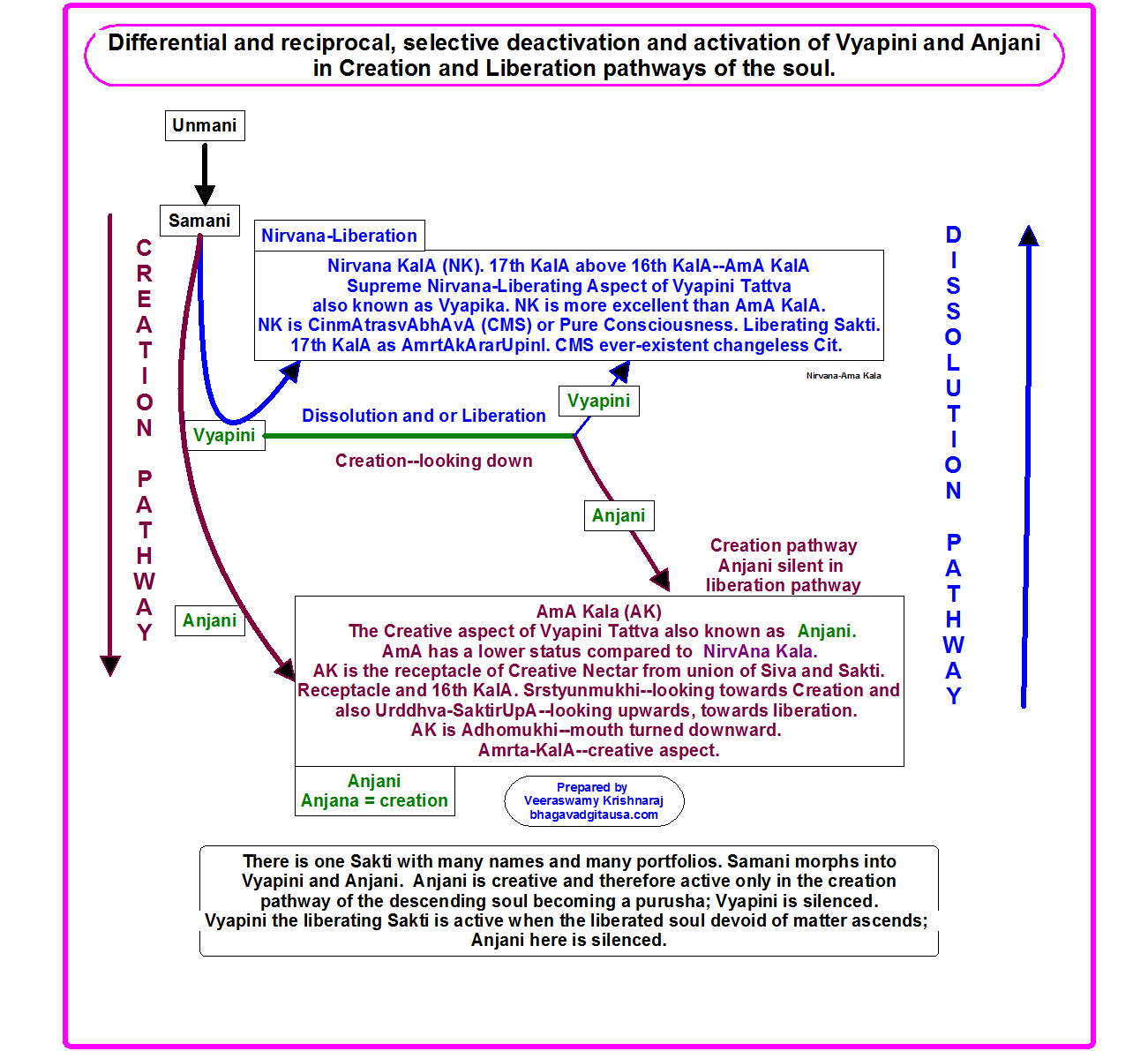
AmA KalA = 16th KalA = Vyapika Sakti = Paratpara = Receptacle of the Nectar that flows from the union of Para (Bindurupa Siva) and ParA (Sakti). It is the Creative aspect (Anjani) of Vyapini Tattva. AmA is both Srstyunmukhi (looking towards creation) and Urddhva-Saktirupa (looking upwards or towards liberation; takes the soul to liberation upwards.) Ama is Creative Anjani and Adhomukhi, and Liberating. Srstyunmukhi is Adhomukhi meaning downward-turned-mouth (petals). Petals turned down before Kundali ascends.
AmA KalA and NirvAna KalA are two aspects (creative and supreme ) of VyApini Tattva as VyApikA and Anjani. NirvAna KalA is more excellent or beyond AmA KalA.
NirvAna Sakti or Samani in Sakti Tattva is the abode of PAsajAla (bondage).
NirvAna KalA is CinmAtra SvabhAvA or Pure Consciousness aspect of what in the creative aspect is called AmA KalA.
----------------------------------------------------------------------------------------------------------------------------
The above passage speaks of the presence of Amā-Kala, and so forth, within the triangle in the Candra-Mandala, The Guru therefore is below them and above Antarātma. Now, if it be asked how it is that, the kankala-Malini having placed the Guru over the Antaratma, the Guru is spoken of as placed above Hamsah, the answer is that the Antarātma and the Hamsah are one and the same.
Guru Dhyana in Kankala-malini1: "Meditate on your Guru seated on a shining throne (Simhasana) placed on the excellent Antarātma between Nada and Bindu," etc. Also elsewhere: "Meditate on your' Guru, who is the image of Siva Himself, as seated on the Hamsa-pita which is Mantramaya." Also cf the Annada-kalpa-Tantra2: "Meditate on your Guru in the white Lotus of a thousand petals in the head; He is Parama-Siva seated on the Hamsa among the filaments." presentation: Veeraswamy Krishnaraj
On a careful consideration of the above authorities, the identity of Hamsa with Antaratma becomes clear. By the expression" one's own Guru, who is Parama-Siva," it is to be understood that Parama-Siva Himself is the Guru.
The following passage, which relates to the Sahasrara, shows that Parama-Siva is in the triangle: "Within (or near) it (Sahasrara) is the lightning-like Triangle, and within the Triangle are the two Bindus which make the imperishable Visarga-There in the empty void is Parama Siva.
These conflicting views lead to the conclusion that the Guru is within the triangle ill. the pericarp of the upturned Lotus of twelve petals, below the pericarp of the Sahasrara and inseparable from it. This has been made clear in the Paduka-pancaka-Stotra3. From these passages it is not to be inferred that the Guru is within the triangle in the pericarp of the Sahasrara. The triangular Hamsa is below the middle triangle; otherwise it would conflict with the authority of the Kankala-maliniTantra.
1 Kankala-malini1 Patala III.
2 Annada-kalpa-Tantra2: This quotation is not traceable in Prasannakumara Siistri's Edition of this Tantra.
3 Paduka-pancaka-Stotra3: See notes to v. 7 of the Paduka-Pancaka.
---------------------------------------------------------------------------------------------------------------------------
Samaste sarveśaḥ sakalasukhasaṁtānalaharī
parivāko haṁsaḥ parama iti niāmnā paricitaḥ. Verse 43, line 3-4
" He pervades all things as their Lord "-(Samaste sarveśah)-i.e., in this pericarp dwells He who is the Lord of All. Now, by saying that Parama-Siva is there, it has been said that Isvara (Lord) is there; then why this repetition? But there is an object in so doing, as the following qualifying expressions will show. The Sarvesa (Lord of All) is the Hamsa--i.e., He is the Mantra" Ham-Sah ".
Cf. Prapañca-sara: "She whose name is Tattva is Cinmatra1: when by proximity to the Light she wishes to create2 She becomes massive (Ghanibhūya) and assumes the form of Bindu. Then in time She divides Herself in two: the one on the right is Bindu and that on the left side is Visarga. The right and the left are respectively distinguished as male and female. Ham is the Bindu, and Sah is Visarga; Bindu is Purusa, and Visarga is Prakrti ; Hamsah. is the union of Prakrti and Purusa, who
pervade the Universe."
The Mahakali-Tantra speaks clearly on the subject (PatalaI): "In the empty space3 in the Candra-Mandala4 which is within the Sahasrara, adorned with a celestial gateway, are the letters Ham and Sah, over which (meditate on) Him who is pure like rock crystal and dressed in pure white silken raiment, and so forth." Here the letters Ham and Sah are explicitly spoken of.
Or if Hamsa and Parama be read separately as Hamsa and Parama it would mean" He who is known as Hamsa and Parama ", The Author himself speaks of Him as Hamsa in the forty-ninth verse. Or if the two words be read together, then the meaning would be "He who is known by the name of Parama-hamsa," by one of the exceptional rules of Karmadhāraya-Samāsa this word having been formed, the word 'antah ' being omitted. Cf. Āgama-kalpa-druma: He is called Parama-hamsah, pervading all that is moving and motionless."
Samaste sarveśaḥ sakalasukhasaṁtānalaharī
parivāko haṁsaḥ parama iti niāmnā paricitaḥ. Verse 43, line 3-4
"Who is the ever flowing," etc., (Sakala-sukha-santāna-laharī-parīvāha)-i.e., in Him becomes manifest in every possible way all kinds of imperishable and increasing happiness; that is, He is, as it were, an interminable chain of happiness.
It has previously been said that this Hamsa is below Parama-Siva.
1 Cinmatra1 Vide ante, v. 39. The text quoted here differs from that of the edition published by me (See ch. I, vv. 41-44, Tantrik Texts, Vol. III).
2 create2 = Vicikīrsu---" wishes to distort herself." Here" distortion," or stress, is creation. See Introduction.
3 empty space3 = Sūnya. The Sūnya is the empty space within the Bindu.
4 Candra-Mandala4 = The locative is to be read Sāmīpye-saptamī---that is, the space is not in, but near, the Candra-Mandala ; otherwise there appears to be a contradiction. End Verse 43.

44. Śivasthānam śaivāḥ paramapuruṣaṁ vaiṣņavagaņā
lapantīti prāyo hariharapadam kecidapare.
Pabaṁ devyā devicaraņayugalāṁbhojarasikā
munīndrā apyanye prakṛtipuruṣasthānamamalaṁ.
The Saivas call it the abode of Siva1; the Vaisnavas call it Parama Purusa2; others again, call it the place of Hari-Hara3. Those who are filled with a passion for the Lotus feet of the Devi4 call it the excellent abode of the Devi; and other great sages (Munis) call it the pure place of Prakrti-Purusa5.
1 Siva1 Siva-sthanam.
2 Purusa2 i.e., the place of Parama-Purusa---Visnu,
3 Hari-Hara3 Visnu and Siva.
4 Devi4 Sakti, or the Goddess.
5 Prakrti-Purusa5 Sakti-Siva,
COMMENTARY
As Hamsah, who has in Him all the Devatās (Sarvadevatāmaya) and others, are in this pericarp, it is the place of the Devatās of worship of all classes of worshippers, such as Saivas, Sāktas, etc.
" The Saivas "-i.e., the worshippers of Siva-call it the place of Siva.
"The Vaisņavas6 call it Parama-Purusa "-i.e., the place of the Parama-Purusa, or Visņu (Vishnu).
" Others, again" (Kecid apare)-i.e., others who are worshippers of Hari-Hara, or, in other words, United Visņu and Siva and not of Siva alone or Visņu alone-call it the place of Hari-Hara7. They do not call it either the place of Hari (Visnu) or of Siva (Hara) but the place of their united selves.
6 Vaisņavas6 Worshippers of Visnu,
7 Hari-Hara7 Hari-Hara-padam.
-----------------------------------------------------------------------------------------------------------------------------
44. Śivasthānam śaivāḥ paramapuruṣaṁ vaiṣņavagaņā
lapantīti prāyo hariharapadam kecidapare.
Pabaṁ devyā devicaraņayugalāṁbhojarasikā
munīndrā apyanye prakṛtipuruṣasthānamamalaṁ. Verse 44
" Other great sages1" (Munīndrā apyanye).-By this the author here means the worshippers of the "Hamsah" Mantra who call it the pure place of Prakrti-Purusa. Hamsah is the union of Prakrti and Purusa2 hence it is the place of Prakrti and Purusa,
The above shows that, as this Lotus is the dwelling-place of the Para Bindu, in which are all the Devatas, each worshipper calls it the place of the Devatās of his own separate worship.
1 Other great sages1 Muni means "knower" and whose Mind is therefore always in a state of Meditation.
2 Purusa2 Hamsasva prakrti-puruṣobhayarūpatvāt. Ham is the Purusa, and Sah is Prakrti.
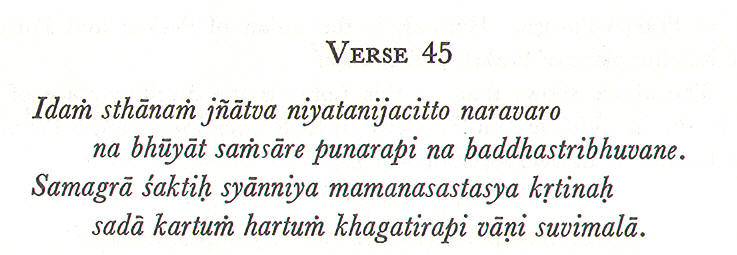
45. Idam sthānam jñātva niyatanijacitto naravaro
na bhūyāt saṁsāre punarapi na baddhastribhuvane.
Samagrā saktiḥ syānniya mamanasastasya krtinaḥ
sadā kartuṁ hartuṁ khagatirapi vāņi suvimalā.
That most excellent of men who has controlled his mind1 and known this place is never again born in the Wandering2, as there is nothing in the three worlds which binds him. His mind being controlled and his aim achieved, he possesses complete power to do all which he wishes, and to prevent that which is contrary to his will. He ever moves towards the Brahman3. His speech, whether in prose or verse, is ever pure and sweet.
COMMENTARY
In this verse he speaks of the fruit of a complete knowledge of the Sahasrara, The idea sought to be conveyed is that a knowledge of this place should be gained as a whole and in detail.
" Who has controlled his mind" (Niyata-nija-citta)-i.e., he who has controlled and concentrated the inner faculties on this place. Such an one becomes free from Samsara, or, in other words, he is released from bondage, as there is nothing to bind or attract him in these worlds. By bondage is meant the Mayik bonds of virtue (Punya) and sin (Papa).
1 mind1 Citta.
2 Wandering2 Samsāra, the world of birth and rebirth to which men are impelled by their Karma.
3 Brahman3 The interpretation of Visvanatha is here adopted, according to which Kha = Brahman. As the term also means the" air" or "ether," the text is capable of translation as " He is able to roam the sky".
----------------------------------------------------------------------------------------------------------------------------------------------
The Bhāgavata says: "If the action which is the product of the operation of the Gunas is attributed to the self, then such (false) attribution is bondage and Samsara and servitude." Also cf. Bhagavad-Gita: "O Son of Kunti, Man is bound by action which is the product of his own nature (Sva-bhāva),"1
To inhabit this body for the purpose of undergoing Papa (sin) and Punya (virtue) is bondage. In heaven one enjoys (the fruit of) Punya, and in the nether world (Patala) one suffers sorrow, and on earth man is subject to both Papa and Punya, For the Tattva-jnanl (him who knows the truth) there is neither Punya nor Papa, which are the causes of bondage; his accumulated (Saṁcita) Karma of merit (Punya) and demerit (Papa) is also destroyed. He is in consequence under no bondage whether in heaven (Svarga), earth (Martya), or nether world (Pātāla), and he is not truly embodied.2 Such a one stays on earth so long only as he has not worked out what he has begun. He is liberated though living (Jivanmukta), and attains complete Liberation on the dissolution of the body.
The Kularnava-Tantra says: "Those who have the Brahman in the heart can acquire neither merit by performing a hundred horse sacrifices, nor demerit by killing a hundred Brahmanas." The Gita (III, 18) also says: "For him there is nothing in this world that should or should not be done. For such an one there is no dependence on any being."3
The Subodhini4 interprets this verse to mean that the " knower" (Tattvajnani) acquires no merit by the performance of actions nor demerit by the omission thereof.
Sruti5 speaks of the destruction of accumulated (Samcita) Punya and Papa: "When Manas, which is now selecting and now rejecting, is dissolved in That; when Papa and Punya are destroyed (lit., burnt), Sadasiva, who is Sakti and Atma (if. Hamsah, ante), is Santa." Cf: Bhagavad-Gita: " And so the fire of knowledge destroys all actions."
1 Sva-bhāva),"1 Ch. XVIII, v. 60.
2 not truly embodied.2 Na sariri bhavati--though he has a body, he is not of it.
3 no dependence on any being."3 Telang's Translation: "He has no interest at all in what is done, and none whatever in what is not done, in this world; nor is any interest of his dependent on any being" (p. 54, Sacred Books of the East, Vol. VIII).
4 Subodhini4 That is, Sridhara-svami's Commentary on the Gita.
5 Sruti5 The text quoted is from Hamsa Upanisad but differs slightly from the published texts of that Upanisad.
------------------------------------------------------------------------------------------------------------------------------------------------------
45. Idam sthānam jñātva niyatanijacitto naravaro
na bhūyāt saṁsāre punarapi na baddhastribhuvane.
Samagrā saktiḥ syānniya mamanasastasya krtinaḥ
sadā kartuṁ hartuṁ khagatirapi vāņi suvimalā. Verse 45
Sruti5 speaks of the destruction of accumulated (Samcita) Punya and Papa: "When Manas, which is now selecting and now rejecting, is dissolved in That; when Papa and Punya are destroyed (lit., burnt), Sadasiva, who is Sakti and Atma (if. Hamsah, ante), is Santa1." Cf: Bhagavad-Gita: " And so the fire of knowledge destroys all actions.2"
"Complete power" (Samagrā-saktī) i.e., power which enables him to do everything. By power, or Sakti, is meant ability to do all he desires to do3 and counteract all harm, to fly across the air4,' and to become possessed of great powers of speech and of poetic composition.
1Santa1 That is, peace and quietude like the still surface of an ocean characteristic of the Supreme State.
2 the fire of knowledge destroys all actions.2" IV, 37.
3 ability to do all he desires to do3 Such an one may have such a power but will not wrongly exercise it.
4 fly across the air4 Khagati; this is Kallcarana's interpretation.
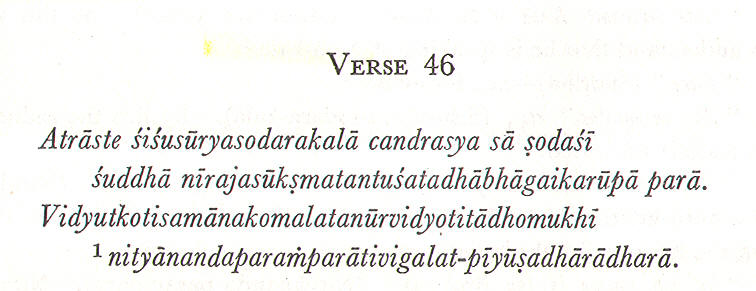
46. Atrāste śiśūsuryasodarakalā candrasya sā sodaśī
śuddhā nirajasūkşmatantuśatadhābhāgaikararūpā parā.
Vidyyutkotisamānakomalatanūrvidyotitādhomukhī
nityānandapararṁparātivigalat-pīyūşadhārādharā.
Here is the excellent (supreme) sixteenth Kala of the Moon. She is pure, and resembles (in colour) the young Sun. She is as thin as the hundredth part of a fibre in the stalk of lotus. She is lustrous1 and soft like ten million lightening flashes, and is down-turned. From Her, whose source is the Brahman, flows copiously the continuous stream of nectar2 (or, She is the receptacle of the stream of excellent nectar which comes from the blissful union of Para and Parâ).3
COMMENTARY
Verses 41 and 42 speak of the presence of Amā-kala, Nirvāna-kalā, and Para-Bindu, within the triangle in the pericarp of the Sahasrāra, He now desires to describe them by their distinctive attributes, and speaks in this verse of the distinctive features of Amā-kalā. www.bhagavadgitausa.com/Sat-Chakra-Nirupana-Kundalini Chakras.htm
1 lustrous1 Kālīcarana reads "Vidyotitā," but Saṁkara reads "Nityodita, " " constantly shining".
2 nectar2 Alternative reading of Commentator: "Nityananda-pararhparativigalat-piyiisa-dhara-dhara." Parampara may mean" in a continuous course," or Pararn may mean Siva and Para-Sakti, This difference in meaning is due to the different ways in which these words may be read.
3 blissful union of Para and Parâ).3 Para, according to Samkara, may mean Para, Pasyanti, Madhyama, and Vaikhari collectively. Para and Para are the Bindu-riipa Siva and Sakti.
46. Atrāste śiśūsuryasodarakalā candrasya sā sodaśī
śuddhā nirajasūkşmatantuśatadhābhāgaikararūpā parā.
Vidyyutkotisamānakomalatanūrvidyotitādhomukhī
nityānandapararṁparātivigalat-pīyūşadhārādharā. 46
"Excellent or supreme" (Para)-i.e., She is Cit-Sakti. In the Prabhasa-khanda occurs the following passage: "The excellent Maya who maintains the bodies of all that have bodies." This is attributive of Ama.
" The sixteenth Kala of the Moon" (candrasya sodaśī ).-By this we are to understand that he is speaking of Ama-kala1.
" Pure" (śuddhā)-i.e., stainless.
"She resembles," etc., (śiśu-sūrya-sodara-kalā- (śiśūsuryasodarakalā)-By this the redness of this Kalā is indicated.
" Thin as the hundredth part of a fibre in the stalk of the lotus" (Nīrajasūkṣma-tantu-śatadhā-bhāgaika-rūpa). -Thin like a hundredth part of the fibre in the lotus-stalk split length-wise.
" Whose source is the Brahman" (Nityānanda-paraṁpara).-Nityananda=Pūrņananda=Brahman.
. "Flows," etc., (Ati-vigalat-pīyūṣa-dhārā-dharā).-If the last two compound words be read as one long compound word, as follows, Pūrņananda-paraṁparati-vigalat-pīyūṣa-dhārā-dharā, the meaning, of it will be as given within brackets at the end of the verse. Ananda will then mean the joy of union, and Paraṁ-Parā will then mean Siva and Sakti,
Para = Bindu-rūpa, Siva; Parā = Prakrti, Sakti. Ānanda is the joy which arises from the union of the two, and from such union flows the nectar of which Amā-kalā is the receptacle.
1 Ama-kala1 Visvanatha says that this Amā-kalā is Urdhva-sakti-rupa, or the upward (towards the Brahman) moving Sakti.

47. Nirvāṇākhyakalā parā paratparā sāste tadantargatā
Keśāgrasya sahasradhā vibhajitasyaikāmśarūpā satī.
Bhutānāmadhidaivataṁ bhagavati nityaprabodhodayā
Candrārdhāngasamānabhaṇguravatī sarvārkatulyaprabhā
Inside it (Ama-Kala) is Nirvana-kala, more excellent than the excellent. She is as subtle as the thousandth part of the end of a hair, and of the shape of the crescent moon. She is the ever-existent Bhagavati, who is the Devata who pervades all beings. She grants divine knowledge, and is as lustrous as the light of all the suns shining at one and the same time.
COMMENTARY
In this verse the Nirvana-kalā is described.
47. Nirvāṇākhyakalā parā paratparā sāste tadantargatā
Keśāgrasya sahasradhā vibhajitasyaikāmśarūpā satī.
Bhutānāmadhidaivataṁ bhagavati nityaprabodhodayā
Candrārdhāngasamānabhaṇguravatī sarvārkatulyaprabhā-47
" Inside it" (Tadantargatā)-i.e., placed in the lap1 of Ama-kalā, The Kala has already been described as the" crescent seventeenth Kalā placed within Amā, and known by the name of Nirvana-kalā."
" More excellent than the excellent" (Parā-paratarā).-The Amā-Kalā is excellent; this is more excellent than Amā, If" Parātparatarā " be accepted for ' Parā-paratarā,' then the meaning will be that She is the most excellent.
" She is as subtle . . . hair" (Keśāgrasya sahasradhā vibhajitasyaikāmśa-rūpa).-She is equal in dimension to the thousandth part of the end of a hair, so very subtle is She.
_ " Of the shape of the crescent Moon" (Candrārdhānga-samāna-bhangu- ravatī)-like Amā-Kalā she is in shape like the crescent,
1 placed in the lap1 of Ama-kalā That is, within the curve of Amā-Kalā . Visvanatha says, not within Amā-Kalā, but within the Candra-Mandala, of which the Amā-Kalā is one of the digits, Nirvana-Kalā is, he says, Vyāpinī-tattva.
----------------------------------------------------------------------------------------------------------------------------------------------------------
Bhutānāmadhidaivataṁ bhagavati nityaprabodhodayā, Verse 47 line 3
" That Devatā who pervades all beings" (Bhūtānām adhidaivataṁ).Adhi-daivataṁ=Hārdda-caitanyam,l and this Kalā is Hārdda-caitanyasvarūpa of all beings.
"She grants divine knowledge" (Nitya-prabodhodayā)i.e., She grants Tattva-jnana, or knowledge of the Brahman.
Candrārdhāngasamānabhaṇguravatī sarvārkatulyaprabhā- Verse 47 line 4
" And is lustrous," etc. (Sarvārka-tulya-prabhā).-There are twelve suns (Dvādaśāditya). "When all the twelve suns are shining "-such is Her lustre. This adjective also implies that She is red.
1 Hārdda-caitanyam. Amara defines Hārdda to mean Prema, Sneha -i.e., affection, love. That is, the Istadevata worshipped in the heart; the Sakti who is Herself the heart of the Lord. The word is derived from hṛd=heart. The Devata also exists as what is called the Hardda-kalā, See Introduction. presentation: Veeraswamy Krishnaraj

48. Etasyā madhyadeśe vilasati paramāpūrvanirvāṇaśaktiḥ
Kotyādityaprakāśā tribhuvanajananī koṭibhāgaikarūpā.
Keśāgrasyātisūkşmā niravadhi vigalapremadhārādharā sā
Sarveşam jīvabhūtā munimanasi mudā tattvabhodhaṁ vahanti.
Within its middle space (i.e., middle of the Nirvana-kala) shines the Supreme and Primordial NirvAna-Sakti1; She is lustrous like ten million suns, and is the Mother of the three worlds. She is extremely subtle, and like unto the ten-millionth part of the end of a hair. She contains within her the constantly flowing stream of gladness2, and is the life of all beings. She graciously carries the knowledge of the Truth (Tattva)3 to the mind of the sages.
COMMENTARY He now speaks of the Para-Bindu.
" Its" (Etasyah)-i.e., of the Nirvana-kala,
" Middle" (Madhya-deśe).-Within the lap.4
Etasyā madhyadeśe vilasati paramāpūrvanirvāṇaśaktiḥ verse 48, line 1
" The Supreme and Primordial Nirvāna-Sakti" (Paramā-pūrva-nirvāna-śakti= paramā apūrva-nirvāna-sakti).-Parama5-i.e., the Supreme Brahman as sakti. Apūrva-i.e., She before whom there was nothing, She having appeared at the beginning of creation.
1NirvAna-Sakti1 This is, according to Visvanatha, the Samanapada or Samani Sakti, This state is not free from the multitude of bonds (Pasajala).
2 flowing stream of gladness2 Prema. See notes, post.
3 knowledge of the Truth (Tattva)3 This word " Tattva " has by Visvanatha been said to be Sivabhedajnanam-i.e., the non-distinction between Siva and Sive.
4 Within the lap.4 That is, within the crescent. According to Visvanatha the locative indicates proximity and means near the middle but slightly above it.
5 Parama5 This word has been defined by Samkara to mean "She who is as great as the Para or Supreme". Visvanatha says it means "She who measures futurity (Para = Uttara-kāla) "-that is, all future time is in Her control.
----------------------------------------------------------------------------------------------------------------------------------------------------------
Etasyā madhyadeśe vilasati paramāpūrvanirvāṇaśaktiḥ Verse 48 line 1
Kotyādityaprakāśā tribhuvanajananī koṭibhāgaikarūpā. verse 48 line 2
Keśāgrasyātisūkşmā niravadhi vigalapremadhārādharā sā verse 48 line 3
Sarveşam jīvabhūtā munimanasi mudā tattvabhodhaṁ vahanti. Verse 48 line 4
" Shines" (Vilasati parama)1 i.e., dwells resplendent.
" Mother of the three worlds" (Tri-bhuvana-janani)-i.e., She is the origin of the Universe which comprises Svarga, Martya, and Patala and the like.2
"She is extremely subtle, like unto the ten-millionth part of the end of a hair" (Keśāgrasya-koţi-bhāgaika-rūpa-tiśukşmā).-As She is like the tenmillionth part of the end of a hair, She is extremely subtle.
"She contains within her the constantly flowing stream of gladness" (Niravadhi-vigalat-prema-dhārā-dharā).-Prema is the tenderness of mind produced by feeling of gladness; that is, She holds within Her the stream of excellent nectar which has its origin in the blissful union of Siva and Sakti, and which flows incessantly.
." Is the life of all beings " (Sarveśāṁ jīva-bhūta)-i.e., animated being is but a part of Her.
Cf. " O Devl, as sparks fly forth from a flame, so does the Parabindu (as Jiva) issue from Her (Nirvāṇa-Sakti), and becomes knowing3 when it touches the Earth."4
By "Her" is meant the Sakti who is in the Para-bindu, who is both Siva and Sakti ; and from Her emanates the Jiva.
Nirvana-Sakti is situated below Nirvana-kala, and over Nibodhika5, which is Nada-rūpa6, Cf. "Placed within Nirvana (Kalā) is the fiery (Vahni-rūpa) Nibodhika, who is unmanifested Nada7; above it is the supreme Nirvana-Sakti, who is the cause of all and is possessed of the lustre of ten million suns.
1 Parama--She who is co-existent or of equal degree with the Supreme(Para) or she who knows the Supreme. This is as applied to Maya.
2 the like.2 Heaven, Earth, and Netherworld.
3 knowing3 Samjñāyuktah, i.e., Jiva-consciousness. It may also mean' becomes endowed with a name '. Name and form characterize the world as Sat, Cit and Ānanda do Brahman.
Cf. Asti bhati priyam rfipam nama cetyamsa-pancakam.
Adyam trayam Brahma-rupam jagadrupam tato dvayam,
4 the Earth."4 Yadā bhūmau patati tadā sam ñāyukto bhavati. The creation of Jiva is here spoken of. The Text quoted is from Nirvana-tantra I.
5 Nibodhika5 See Introduction, and note to v. 40, particularly the portion dealing with Nada, Bodhini and Bindu.
6 Nada-rūpa6 That is Sakti, as Nada,
7 unmanifested Nada Avyakta-nada-unmanifested sound.
----------------------------------------------------------------------------------------------------------------------------------------------------
It is in Her that there is the Brahman1 who is the changeless Siva2; it is here that Kundali-Sakti enjoys with Paramatma."
Nibodhikā is a phase of Avyakta-nada (Avyakta-nādātmikā), and is fire-like. Raghava-bhatta says: "Nāda exists in three states. When Tamo-guna is dominant, it is merely sound unmanifest (Avyakta-nada)3 in the nature of Dhvani; when Rajo-guna is more dominant, there is sound in which there is somewhat of a placing of the letters4; when the Sattvaguna preponderates, Nada assumes the form of Bindu5." Hence Nada, Bindu, and Nibodhika, are respectively the Sun, the Moon, and Fire6 and their activities are Jnāna, Iccha, and Kriya, Jnana, again, is Fire, Iccha the Moon, and Kriya the Sun. This has been said in the Sarada. Therefore, insomuch as it has been said that Nirvana Sakti is above the fiery (Vahni-rūpa) Nibodhika, the wise should conclude that NirvānaSakti is placed above the Mandalas of the Sun, the Moon, and Fire.
This has been clearly stated in the Kularnava-Tantra, in the ParaBrahma-dhyana, which begins, "The Bindu-rūpa Para-Brahma in the Sahasrāra," and ends, "Beautified by the three Mandalas within the triangle in the pericarp." By three Mandalas are meant the Mandalas of Sun, Moon, and Fire. We shall show that the Nirvana-Sakti is in the form of Para-bindu (Para-bindu-rūpā).
1 Brahman1 Nirañjana. This word may either be equal to Nir+añjana (i.e.,. stainless) or Nih--añjana (unaffected by pleasure or pain, unmoved). It is one of the aspects of the Brahman.
2 Siva2 Nirvikara. Some read Nirvikalpa, or of unconditioned, consciousness. Nirvikalpa is also the last stage of Samadhi, in which there are no (Nir) specific distinctions (Vikalpa); and no "this" and" that".
3 (Avyakta-nada)3 Tamo-gunādhikyena kevala-dhvanyātmako'vyakta-nādah.
4 the letters4 Raja ādhikyena kiṁcidvarṇa-baddha-nyāsātmakah. The sense appears to be that the letters exist anyhow together in massive undifferentiated form.
5 Bindu5 Sattvadhikyena bindu-rūpah.
6 Fire6 Tatash cha nāda-bindu-nibodhikā arkendu-vahni-rūpah. Jñāna is Fire, because it burns up all actions. When the result of action is realized, action ceases (see note to v. 45). Icchā is the Moon, because Icchā is the precursor of creation and is eternal. The Moon contains the Amā-kalā, which knows neither increase nor decay. Kriyā is the Sun, because like the Sun it makes everything visible. Unless there is striving there cannot be realization and manifestation. Cf." As one Sun makes manifest all the Lokas " (Gītā).
The Text will be made clearer if an arrangement be made in the following groups: (I) Nada, Sun, Kriyā; (2) Bindu, Moon, Icchā; (3) Nibodhikā, Fire, Jñana. But see Introduction.
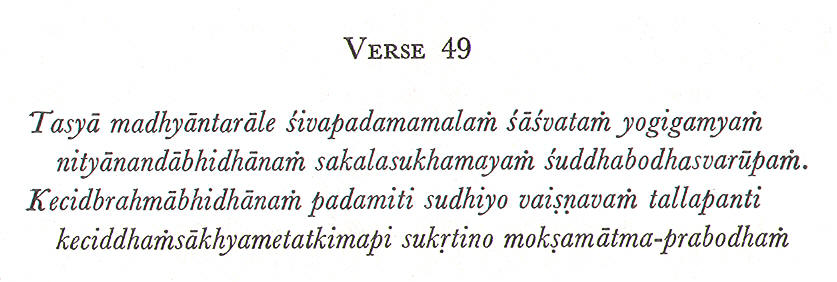
49. Tasyā madhyātarāle śivapadamamalaṁ śāśvataṁ yogigamyaṁ
Nityānandābhidhānam sakalasukhamayaṁ śuddhabhodhasvarūpaṁ.
Kecidbrahmābhidhānaṁ padmiti sudhiyo vaişṇavaṁ tallapanti
Keciddhaṁsakhyametatkimapi sukṛitno mokşamātma-prabodhaṁ
Within her is the everlasting place called the abode of Siva1, which is free from Maya, attainable only by Yogis, and known by the name of Nityananda. It is replete with every form of bliss2, and is pure knowledge itself3. Some call it the Brahman; others call it the Hamsa. Wise men describe it as the abode of Visnu, and righteous men4 speak of it as the ineffable place of knowledge of the Atma, or the place of Liberation.
COMMENTARY
He speaks of the Para-Brahma-sthāna (place of Para-Brahma) in the Void within Nirvana-Sakti.
1 Siva1 Siva-padam or state of Siva. This, Visvanatha says, is the Unmani state of Sakti where there is neither Kāla nor Kalā, time nor space. It is the body of Siva (Siva-tanu}. It is then said Unmanyante Para-sivah, The following verse which occurs in Padma-Purana (Uttara-Khanda, ch. 78, v. 43) puts the idea in a more popular form. It says:
Saivāh Saurāsh ca Gāneśāh Vaişnavas śākti-pūjakāh.
Māmeva prāpnuvantī hi varsāṁbhah sāgaraṁ yathā.
" Saivas, Sauras, Ganesas, Vaisnavas and Saktas, all verily come to me like rain water to the ocean."
2 bliss2 Sakala-sukhamayam. Visvanatha reads here Parama-kulapadarn, which he interprets as Param Akula-padaṁ, or the abode of the Supreme Siva, who is known as Akula, as Kula is Sakti, It is so called because it is here that the universe finds its rest.
3 pure knowledge itself3 Suddha-bodha-svarūpaṁ www.bhagavadgitausa.com/Sat-Chakra-Nirupana-Kundalini Chakras.htm
4 men4 Sukŗtinah,
--------------------------------------------------------------------------------------------------------------------------------------------------------------------------------------
49. Tasyā madhyātarāle śivapadamamalaṁ śāśvataṁ yogigamyaṁ verse 49 line 1
Nityānandābhidhānam sakalasukhamayaṁ śuddhabhodhasvarūpaṁ. verse 49 line 2
Kecidbrahmābhidhānaṁ padmiti sudhiyo vaişṇavaṁ tallapanti verse 49 line 3
Keciddhaṁsakhyametatkimapi sukṛitno mokşamātma-prabodhaṁ verse 49 line 4
"Within Her" (Tasyāh madhyāntarale) i.e., within Nirvana1
Sakti in Her form of Param Bindu, i.e., the empty space within the Bindu.
" Abode of Siva" (Siva-padaṁ).-This is the place of the Brahman.
" Free from Maya" (Amalaṁ)-i.e., free the impurity of Maya.
"Called "-i.e., called by those who know the Tattva.
"Attainable only by Yogis " (Yogi-gaṁyam).-On account of its extreme subtlety, it is beyond the scope of word and mind, is attainable by Yogis by pure jñāna2 only.
" Some call it "-i.e., the Vedāntists (Vaidāntikas) call it.
" Ineffable" (Kimapi)-i.e., wonder-inspiring.
"Place of the knowledge of the Ātmā" (Ātmā -prabodham).-The place where the Ātmā is seen or realized.
"Liberation." (Mokşa)-i.e., where one is liberated from Māyā by which one is surrounded.
Now be good enough to mark the following: the Para-bindu which is Prakrti and Purusa is surrounded3 by Maya, and is within the triangle in the pericarp of the Lotus of a thousand petals. So it has been said:
"In the Satya-Ioka is the formless and lustrous One; She has surrounded Herself by Māyā, and is like a grain of gram; devoid of hands, feet, and the like. She is Moon, Sun, and Fire. When casting off (Utsŗjya) the covering (Bandhana) of Māyā, She becomes of two-fold aspect (Dvidhā bhitvā) and Unmukhi,4 then on the division or separation of Siva and Sakti5 arises creative ideation."6
The word" Satya-Ioka " in the above passage means Sahasrāra, Also if. " The attributeless Bindu is without doubt the Cause (of the attainment) of Siddhis. Some say that the Deva who is one, stainless
1 Nirvana1 Visvanatha says Samana,
2 jñāna2 Spiritual knowledge, as it is said: Mokse dhir jnanam anyatra vijnanam shilpa-sastrayoh. The knowledge which gains Moksa (Liberation) is called Jnana, other forms of knowledge, such as fine arts, and the Sastras being Vijnana.
3 Prakrti and Purusa is surrounded3 Maya- bandhana-cchadita- prakrti- purusatmaka-para, bindu.
4 Unmukhi,4 By Unmukhi is meant that She becomes intent on creation.
S Sakti5 Śiva-Śakti-vighāgena. By division or separation is not meant that Siva is really divided or separated from Sakti-for the two are ever one and the same-but that Sakti, who exists latently as one with the Brahman in dissolution, appears to issue from It on creation as the manifested universe.
6 creative ideation."6 Sŗṣţi-kalpanā, That is, the subject knows itself as object.
------------------------------------------------------------------------------------------------------------------------------
(Nirañjana), all-embracing (Mahā-pūrna) and united with the primordial Sakti as in the form of a grain of gram1 is Brahmā, and by some, again, He is called Visnu : by others, again, He is called the Deva Rudra."
The luminous empty space within the Nirvāna-Sakti (i.e., the outer circle of the Para-bindu), which is more minute than the ten-millionth part of the end of a hair, is according to the author, the abode of Brahman (Brahma-pada). Cf." Within it2 is Para-bindu, whose nature it is to create, maintain, and destroy. The space within is Siva Himself and Bindu3 is Parama-kundali."
Also: "The circumference (Vŗtta) is the Kundalini-Sakti, and She possesses the three Gunas, The space within, O Beloved Maheśāni is both Siva and Sakti4."
This Bindu is, according to some, Isvara, the Cause of All. Some Paurānikas call Him Mahā- Visnu; others call Him Brahma Purusa,
. Cf." There was neither day nor night, neither the firmament nor the earth, neither darkness nor any other light; there was That, the Brahma-Male.5 imperceptible to hearing, and the other sources of knowledge united with Pradhana." 6
The Sarada7 says: "The eternal Siva should be known both as Nirguna (attributeless) and Saguna (possessed of attributes). He is Nirguna when (considered as) dissociated from the workings of Prakrti, but when Sakala (i.e., so associated with Prakrti) He is Saguna." 8
This shows that the Bindu is Saguna-Brahman. We should know that Saguna-Brahman is in reality but one, though He is called by different names according to the inclinations of men. There is no need to go into further details.
1 grain of gram1 Canaka, which under its outward sheath contains two undivided halves.
2 Within it2 Apparently NirvAna-kalA,
3 Bindu3 That is, the circumference as opposed to the inner space. '
4 Sakti4 Jñānarṇava-Tantra, XXIV, 21.
5 Brahma-Male.5 Pradhānikam Brahma-pumān.
6 Pradhana." 6 Kālikā-Purāṇa, XXIV, v, 125.
7 Sarada7 Ch. I.
8 Saguna." 8 And, so, also, the Saktānanda-taraṇginī (Ch. I) says of the Devi that Maha-māyā without māyā is Nirguna, and with māyā Saguna.
-------------------------------------------------------------------------------------------------------------------------------
SUMMARY OF VERSES 41 TO 49
Above (the end) of the Suṣumnā-Nadi is the Lotus of a thousand petals; it is white and has its head downward turned; its filaments are red. The fifty letters of the Alphabet from A to La, which are also white, go round and round its thousand petals twenty times. On its pericarp is Hamsah, and above it is the Guru who is Parama-Siva Himself. Above the Guru are the Sūrya-and Candra-Mandalas, and above them Mahā·vāyu. Over the latter is placed Brahmarandhra, and above it Mahasankhini. In the Mandala of the Moon is' the lightning-like triangle within which is the sixteenth Kalā 1 of the Moon, which is as fine as the hundredth part of the lotus-fibre, and of a red colour, with its mouth downward turned. In the lap of this Kala is the Nirvana-Kala, subtle like the thousandth part of the end of a hair, also red and with the mouth downward turned. Below Nirvana-Kala is the Fire called Nibodhika which is a form of Avyakta-nada.2 Above it (Nibodhika), and within Nirvanakala, is Para Bindu, which is both Siva and Sakti. The Sakti of this ParaBindu is the Nirvana-Sakti, who is Light (Tejas) and exists in the form of Hamsah (Hamsa-rupa), and is subtle like the ten-millionth part of the end of a hair. That Hamsah is Jiva. Within the Bindu is the void (Sūnya) which is the Brahma-pada (place of the Brahman).
According to the view expressed in the fifth chapter of the Agamakalpa-druma and other works, the triangle A-Ka-Tha3 is in the pericarp of the Sahasrara. At its three corners are three Bindus: the lower Bindu at the apex of the triangle is Ha-kara4 and is male (Purusa}; and the two Bindus at the corners constitute the Visarga in the form Sa 5 and represent Prakrti. Hamsah which is Purusa and Prakrti thus shows itself in the form of three Bindus. In its middle is Ama-kala, and in Her lap is NirvanaSakti, and the vacant space within Nirvana-Sakti is Para-brahman. It has been said: "Within the Mandala of the moon in the white Lotus of a thousand petals shines like lightning the triangle A-Ka- Tha united with
1 Kalā 1 That is, Amā-kalā,
2 Avyakta-nada.2 Avyakta-nadatmaka-nibodhikiākhya-vahni.
3 the triangle A-Ka-Tha3 That is, the letters arranged in the form of the triangle referred to in v, 4 of Paduka-panchaka. The Devi is Matrka-mayi.
4 apex of the triangle is Ha-kara4 Viz., Ham representing the" Male" Bindu,
5 Sa 5 That is, literally" standing Sa," or Visarga, in the form Sa. The letter Sa, or more strictly Sa without the vowel, changes into Visargah; thus, Tejas becomes Tejah, Rajas Rajah.
------------------------------------------------------------------------------------------------------------------------------
Ha-La-Ksa1 Within it, is the excellent (Para) Bindu (Sunya), placed below Visarga. In this region is the downward-turned sixteenth Kala (AmA KalA), of the colour of the rising sun, in shape like the crescent moon who discharges a stream of nectar, and within Her is Para-Sakti, possessing the effulgence of ten million suns. She is as subtle as the thousandth part of the Lotus fibre, and is Cidātmikā.2 Within Her is Bindu who is the Nirañjana-Purusa, who is beyond mind and speech and is Saccidananda, and Visarga (who is also there) is Prakrti. Hamsa who is both Pum3 and Prakrti shines by His own effulgence."
Those who follow this view, place Sa-kāra over the Bindu, and place the Guru above Visarga4 and Bindu which together make Hamsah, But this cannot be right. The Nirvana-Tantra speaks of the Guru as worshipping the Para Bindu-rupa-Sakti, and as being close to Her and in the act of worshipping Her. The worshipper should always sit at a .level lower than, and in front of the object of worship, and never at a higher level than, and behind the object of worship. Cf. Nirvana5: " Meditate upon the Niranjana Devi within the Satyaloka in the Cintāmani-gŗha6 as placed on the jewelled throne or lion-seat (Simhasana), and on your Guru as being near Her and worshipping Her."
The Mahakali Tantra, moreover, speaks explicitly of the presence of the Guru over the two letters Ham and Sah7. It is to be understood that if there be any texts which differ from, or add to, those here adopted, then they must be taken to refer to different methods and opinions.
(This is the end of seventh section)
1 Ha-La-Ksa1 These Varnas are inside the triangle A-Ka-Tha.
2 Cidātmikā.2 Of the nature of Cit. Cf. definition of Maya-Sakti in Tattvai Samdoha 14.
3 Pum3 The Male, Purusa,
4 Visarga4 Lit. Generator of Visarga, for from Sa Visarga comes.
5 Nirvana5 Nirvana- Tantra, Ch. X.
6 Cintāmani-gŗha6 The room made of Cintāmani stone which grants all desires, described in the Rudra-yāmala and Brahmānda-Purāna, The Lalita refers to it as being the place or origin of all those Mantras which bestow all desired objects (Cintita).
7 Ham and Sah7 In the Jñānārnava Tantra (I, v. 13) it is said: ,. Pārvati, in Hakāra with Bindu (Ham) is Brahma and, O Mahesvara, the two Bindus of Visarga (Sah) are Hari and Myself. By reason of this inseparable connection men in this world speak of Hari-Hara,"
THE KUNDALINI

50. Hūṁkāreṇaiva devīm yamaniyamasamabhyāsaśīlaḥ suśīlo
Jñātva śrīṇāthavaktrāt-kramamiti ca mahāmokşavartmaprakāśaṁ
Brahmadvārasya madye viracavati sa tāṁ śuddhabuddhisvabhāvo
Bhitvā talliṅgarūpam pavanadahanayorākrameṇaiva guptaṁ.
HE whose nature is purified by the practice of Yama, Niyama, and the like,1 learns from the mouth of his Guru the process which opens the way to the discovery of the great Liberation. He whose whole being is immersed in the Brahman then rouses the Devi by Hurh-kara, pierces the centre of the Linga, the mouth of which is closed, and is therefore invisible, and by means of the Air and Fire (within him) places Her within the Brahmadvara.2
COMMENTARY
Having described the Cakras ending with the Sahasrara, he now wishes to speak of the union of Kundalini, and preliminary to that he refers to the mode of rousing Kundalini3.
The sense conveyed by this verse is that the man who has attained success in Yoga learns from his Guru the process, which consists of contracting the heart, rousing Kundalini by the power of the air and fire, and so forth4 and having learned it from the mouth of his Guru, he rouses Kundalini, attacking Her with air and fire, and by uttering the Kūrca presentation: Veeraswamy Krishnaraj
1 the like,1 See Introduction.
2 Brahmadvara.2 That is, within Citriņi-Nadi.
3 Kundalini3 In the Yoga-process known as Satcakrabheda, generally described in the Introduction, but which practically must be learned of the Guru.
4 so forth4 The Commentator Sarnkara, citing Goraksa Samhita, says that air makes the fire go upwards, and the fire awakens Kundalini and She also goes upwards.
--------------------------------------------------------------------------------------------------------------------------------------------------
50. Hūṁkāreṇaiva devīm yamaniyamasamabhyāsaśīlaḥ suśīlo --Verse 50, line 1
Jñātva śrīṇāthavaktrāt-kramamiti ca mahāmokşavartmaprakāśaṁ --Verse 50, line 2
Brahmadvārasya madye viracavati sa tāṁ śuddhabuddhisvabhāvo --Verse 50, line 3
Bhitvā talliṅgarūpam pavanadahanayorākrameṇaiva guptaṁ. --Verse 50, line 4
" Hum" and piercing the mouth of the Svayambhu-Linga places Kundalini within Brahmadvara, or, in other words, within the mouth of the Nādi Citrinl,
" He whose nature is purified" (Suṣila)-i.e., the man who regularly practices Yama and so forth, and has trained himself.
" By practicing Yama, Niyama," etc. (Yama-niyama-sama-bhyāsaśila). -It must be observed that it is not merely by the practice of Yama and Niyama that perfection in the preliminary Yoga practices 1 is attained. But the Sadhaka has by practice to destroy such inclinations as lust, anger, and the like which interfere with Yoga, and cultivate others, such as controlling the inner air, steadiness of mind, and so forth, which are helpful in Yoga practice. It is because of this that in verse 54 the Author has used the word" Yamādyaih " in the plural. Practicing Yama and the like is necessary, however, for those whose minds are disturbed by lust and other propensities. If, however, a man by reason of merit and good fortune acquired in a previous birth, and by his nature, is free from anger, lust, and other passions, then he is capable of real Yoga without the preliminary practices. This must be well understood.
Jñātva śrīṇāthavaktrāt-kramamiti ca mahāmokşavartmaprakāśaṁ --Verse 50, line 2
"From the mouth of his Guru" (Sri-nātha-vaktrāt).-The process cannot be learnt without the instructions of the Guru. Hence it has been said: "It can be learnt from the Guru alone, and not from ten million Sastras."
" Process" (Krama).-Steps, order.
" Which opens the way to the discovery of the great Liberation" (Mahamoksa-vartma-prakāśa)--By this is meant the 'process' by which the entrance into the channel of the Nādi Citrinl is opened out. 'Way of Liberation ' (Moksa-vartma) is the way through the channel within Citrini). The' discovery' (Prakāśa) is made of this by making one's way through it.
" He" (Sah)-i.e., the man who has distinguished himself by his success in Yoga practices.
Brahmadvārasya madye viracavati sa tāṁ śuddhabuddhisvabhāvo --Verse 50, line 3
" Whose whole being is immersed in the Brahman" (śuddha-buddhisvabhāva 2) .-Suddha-buddhi means the Brahman, and he whose Svabhava (own being) is in Him. This compound word may also mean' He whose being (Bhava) by reason of the purity of his mind (Suddha-buddhi) is immersed in the Spirit (Sva=Atma)."
1 Yoga practices 1 Anga-yoga. See Introduction, and Visvanatha citing GautamīyaTantra (See post, p. 123.)
2 śuddha-buddhisvabhāva 2 Samkara reads prabhava, and renders the passage as "He whose power is due to the purity of the Buddhi ".
Hūṁkāreṇaiva devīm yamaniyamasamabhyāsaśīlaḥ suśīlo --Verse 50, line 1
"Rouses the Devi by Hūm-kāra " (Hūm-kāreņaiva Devīm).-The Agama-kalpa-druma says: "Then having mentally recited Hamsa, gently contract the anus."1 It therefore follows that in moving Kuṅḍalinī the Hamsa-Mantra should be uttered. The Author of the Lalita-rahasya, following this, says that in moving Kuṅḍalinī the Mantra" Hūṁ Harṁsah " should be employed. But from the fact that the part is to be contracted after the Haṁsa-Mantra is recited, the intention appears to be that the Jīvātmā, which is of the shape of the flame of a lamp, should by the recitation of the Haṁsa -Mantra be brought from the heart to the Mūlādhara, and then moved along with Kuṅḍalinī.
The Āgama-kalpa-druma in a subsequent passage says: "Raising and again raising the Sakti with the Atmā from the abode of Brahmā2 the excellent Sādhaka should (and so forth)." This shows that She should be led away along with Atmā or Jivātmā. The Kālī-Kulāmrta has: Having led Jīva from the heart by the Haṁsa-Mantra to the Mūla Lotus3, and having roused the Paradevatā Kuṅḍalinī by Hūṁ-kāra," The Kaņkala-malini says: " O daughter of the King of Mountains, having drawn the Jīvātmā by the Pranava, let the Sadhaka move Prana and Gandha4 with Kuṅḍalinī by the aid of the ' So' ham Mantra, and make the Devi enter the Svadhistāna."
The wise should, from the above texts, understand that the Jīvātmā should be brought from the heart by the aid of either the Pranava or Haṁsa Mantra, and then Kuṅḍalinī should be roused by the Kūrcabija alone.
Bhitvā talliṅgarūpam pavanadahanayorākrameṇaiva guptaṁ. --Verse 50, line 4
" The mouth of which is closed," etc. (Guptam).-This word may be read either as an adjective qualifying Linga, and mean unmanifested by reason of its mouth being closed.5 or may be read as an adverb qualifying ." places" and then the word would mean " imperceptibly".
In the Agama-kalpa-druma, Pañcama-sākhā, the mode of rousing the Kuṅḍalinī is described in detail thus: "Having seated oneself in the
1gently contract the anus."1 śanair ākuñcayed gudaṁ--that is, by Asvinī-mudrā.
2 Brahmā2 Brahma is in Mūlādhāra,
3 Mūla Lotus3 Mukhāmbhuja, This may be a mis-script for Mulāmbuja.
4Gandha4 i.e., Prthivi.
6 closed.5 On the top of the Liṅga is Nāda-bindu--i,e., Candra-Bindu, The mouth is the Bindu which Kuṅḍalinī pierces.
THE SIX CENTRES AND THE SERPENT POWER
Padmāsana posture, the two hands should be placed in the lap. Thereafter, having mentally recited the Harṁsa Mantra, the anus should be gently contracted. One should then repeatedly raise the air by the same way,1. and having raised it let him pierce the Cakra. I now speak of its processes. In the Mūlādhāra Lotus is a very beautiful triangle. Inside it is Kāma2 (lustrous) like ten million young suns; above Him (Kāma) and surrounding Svayambhu-Linga, is Kundalinl-Sakti." Also cj. As the result of excitation by the Kāmāgni and the action of the Kūrca-mantra on Her, She is seized with desire for Para-Haṁsa."3
The Bhūta-suddhi4 also says: "O Siva, the Sadhaka should contract the chest (lit., heart), letting his breath remain there,5 and he should control the base of the throat and other parts of the body,6 and then suddenly opening the door by means of a key-like motion (Kuñcikā)7 and (the fire of desire) should be kindled, O Paramesvarl, by means of the air (Pavana)." "Then the Serpent8 who is sleeping on the Linga in the Mūlādhāra and who is stung by the heat of the fire, should be awakened in the Linga at the mouth of the Yoni and by the heat (of her desire) be led forcibly upwards9." "Move the air into the Nadi according to the rules of Kumbhaka (retention of breath) and the method shown by the Guru. Let the Jiva thus controlled be led by the concealed passage, and by the upward breath make all the Lotuses turn their heads upwards. Having fully awakened Her, let the wise one lead Her to Bhānu (the Sun) at the summit of the Meru (i.e., the Sahasrāra)."
1way,1Tena vartmanā--that by which Kundalinl is to go.
2 Kāma2 The Kama-vayu, or Air of Kama.
3 Para-Haṁsa."3 Param Haṁsābhilāsinī---i.e., passion is excited in Her, and She is impelled by the fire of Kāma towards the Paraṁ Haṁsa in the Sahasrāra.
4 Bhūta-suddhi4 This passage is obscure, and cannot be traced in the only published edition of the Tantra, but is similar to certain passages in the Hathayogapradīpikā which deal with Bhūta-śuddhi, It seems to contain passages from various texts to illustrate the process of Bhūta-śuddhi. The Commentator has, however, more clearly described the process in his own words.
5 there,5 He thus closes the passage of the upward breath.
6 the body,6 That is, the chest and the anus, thus closing the passage of the upward and downward airs.
7 (Kuñcikā)7 That is, the motion of the Kāma-vāyu spoken of post.
8 Serpent8 Nāginī; one of the names of Kundalinl.
9 upwards9 That is, the Trikona in the Muladhara which surrounds the Svayambhu-Linga.
Now pay attention to the procedure established by a careful consideration of the above textI.: The Yogi should sit in the proper posture and place his two hands with palms upwards in his lap and, steady his mind (Citta) by the Khechari Mudra. He should next fill the interior of his body with air and hold it in by Kumbhaka2 and contract the heart3 By so doing the escape of the upward breath is stopped. Then, when he feels that the air within him from the belly to the throat is tending downward through the channels in the Nadis, he should contract the anus and stop the downward air (Apana); then, again having raised the air, let him give the Kama4 within the triangle in the pericarp of the Muladhara Lotus a turn from the left to the right (Vāmāvartena) ; by so doing the fire of Kama there is kindled, and Kundalini gets heated (excited) thereby. He should then pierce the mouth of the Svayambhu-Linga, and through its aperture with the aid of the" Hūṁ " Bija, lead Her who desires union5 with Parama-Siva, within the mouth of the Citrini-Nadi. This is the clear sense of texts.
I. textI The passages in quotation marks are here cited from different books: on Hathayoga,
2 Kumbhaka2 Retention of breath in Prāņāyāma.
3 heart3 Hrdayaṁ akūñcayet---that is, by Jālaṁdhara-Bandha, etc. See Introduction.
4 Kama4 Kāma-vāyu.
5 union5 Sāma-rasya, a term used on the material plane to denote sexual union.
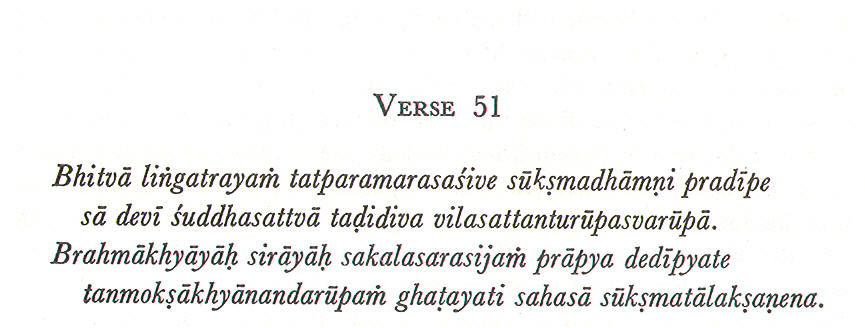
51. Bhitvā lingatrayaṁ tatparamarasaśive sūkşmadhāmṇi pradīpe
Sā devī śuddhasattvā taḍidiva vilasattanturūpasvarūpā.
Brahmākhyāyāḥ sirāyāḥ sakalasarasijaṁ prāpya dedīpyate
Tanmokşākhyānandarūpam ghaṭayati sahasā sūkşmatālakşaṇena.
THE Devi who is Suddha-sattva1 pierces the three Lingas, and, having reached all the lotuses which are known as the Brahma-nadi lotuses, shines therein in the fullness of Her lustre. Thereafter in Her subtle state, lustrous like lightning and fine like the lotus fibre, She goes to the gleaming flamelike Siva, the Supreme Bliss and of a sudden produces the bliss of Liberation.
COMMENTARY
Now he speaks of the mode of the Union of Kuņḍalinī (with Siva). The meaning of this verse, in brief, is that the Devi Kuņḍalinī pierces the three Liṅgas--viz., Svayambhu, Bāņa, and Itara2 and by so doing makes a passage for Herself; and when she reaches the lotuses in (or appertaining to) the Nādī called Brahma- Nādī She shines in the fullness of Her lustre in these lotuses. Then, when in Her subtle form, fine like the lotus fibre, She approaches Siva, who is Supreme Bliss3 Itself, and who is in His Bindu form in the pericarp of the Sahasrara, She brings to the Sadhaka the Bliss of eternal Liberation4 when that is least expected.
Pierces" (Bheda) means making a passage through that which is obstructed.
1 Suddha-sattva1 A form of embodied Caitanya. See Commentary, post. Caitanya: consciousness ; intelligence , sensation , soul , spirit; the Universal Soul or Spirit.
2 Itara2 In the Mūlādhāra, Anāhata, and Ājña-Cakras respectively.
3 Supreme Bliss3 Paramarasa-Paramānanda.
4 Liberation4 Mokśākhyānandarūpaṁ=Nityānandarūpa-muktiṁ.
51. Bhitvā lingatrayaṁ tatparamarasaśive sūkşmadhāmṇi pradīpe --Verse 51 line 1
Sā devī śuddhasattvā taḍidiva vilasattanturūpasvarūpā. --Verse 51 line 2
Brahmākhyāyāḥ sirāyāḥ sakalasarasijaṁ prāpya dedīpyate --Verse 51 line 3
Tanmokşākhyānandarūpam ghaṭayati sahasā sūkşmatālakşaṇena. --Verse 51 line 4
" Śuddha-sattvā."-Sattva, Ati-sattva, Parama-sattva, Suddha-sattva, and Visuddha-sattva are the five different degrees of Caitanya pervading the body1. Suddha-sattva is therefore the fourth [Turiya) stage. By Brahmanādī is meant Citriņī. The Lotuses are the six Lotuses which are strung upon Citriņī, (Ati = surpassing) Caitanya: Consciousness.
" The three Lingas " (Liṅga-trayaṁ).-The three Liṅgās already described. By this we are to understand that the six Cakras and five Sivas are included. She pierces all these, which altogether make fourteen knots (Granthi).
The Sāktānanda-tarangiņī speaks of "Her who goes along the Channel of Brahman2 having pierced the fourteen knots3."
The Svatantra-Tantra speaks of the distinctive features of Liṅga and Śiva.
" The Devi goes to Brahman (Niskala)4 after having pierced the Śivas placed in the six Cakras. As She reaches each of the different Cakras, She acquires the beauty characteristic of each and bewitches Maheśāna5; and having there repeatedly enjoyed Him who is filled with joy, She reaches the Eternal One (Sāśvata). He is said to be transpierced (Bhinna), as He is bewitched by Parā."
The Māyā-Tantra says: "The Devi goes along the Śakti-mārga, piercing the three Lingas in the Cakras in each of Her different forms6 (Tattadrūpena), and having attained union (in the Sahasrāra) with Niṣkala (Brahman) She is satisfied." Tattadrūpena i.e in the forms Vaikharī, Madhyamā, and Paśyantī. Tatta(d) = belonging to. Tattad-rūpena belonging to forms.
It has been said that7 "The first state (Bhāva) is Vaikharl, and Madhyama is placed in the heart; between the eyebrows is the Pasyanti state, and the Para state is in the Bindu8." The meaning of the above quotation is that the four sound-producing (Śabdotpādikā) Śaktis-viz., Para, Pasyanti, Madhyama, and Vaikhari--are identical with Kuṇḍalinī (Kuṇḍalinyabheda-rūpā).
1 Caitanya pervading the body1 Śarīrāvacchinna-Caitanya.
2 Brahman2 Brahma-randhra, the channel within Citrini is called Brahmanāḍī and Brahma-randhra.
3 knots3 That is, 3 Lingas, 6 Cakras, and the 5 Sivas-viz., Brahma and the rest--in the 5 Cakras.
4 Brahman (Niskala)4 The supreme or Nirguna-Brahman.
5 Maheśāna5 That is, the Śiva in the particular Cakra.
6 Her different forms6 That is, She unites, in Her passage along the Nāḍī, with each of the Lingas in that form of Hers which is appropriate to such union.
7 that7 See Commentary on v. I I, ante.
8 Bindu8 According to v. I I, Para is in Mūlādhāra, Paśyantī in Svadhiṣṭhāna, Madhymā in Anāhatā and Vaikharī in the mouth. What is, however, here described is Layakrama.
Hence at the time when Kuṇḍālinī starts to go to Sahasrara She in Her form of Vaikhari bewitches Svayaṁbhū-Liṅga; She then similarly bewitches Bāna-Liṅga in the heart as Madhyama, and Itara- Liṅga between the eyebrows as Pasyanti, and then when she reaches Para-Bindu She attains the stage of Parā (Parābhāva},
The Method of Cakra-bheda is thus described: "O Paramesvart, let the Sadhaka carry along with Her the Lotuses which are on the Citrini, and which have their origin in the mud of blood and fat.1 Let him2 enter the channel (Nāla)3 on the left, from below, and in this way Cakrabheda (piercing the Cakra) is effected. After having thus pierced the six Cakras, She along with Jiva should be led as the rider guides a trained mare by the reins." www.bhagavadgitausa.com/Sat-Chakra-Nirupana-Kundalini Chakras.htm
. Also if. "The Devi should be led by the Hamsa-Mantra to the Sahasrara through the points of union of the six Cakras (with the Nadi along the road of Susurnna."
Bhitvā lingatrayaṁ tatparamarasaśive sūkşmadhāmṇi pradīpe --Verse 51 line 1
"Gleaming flame-like" (Sūkṣma-dhāmnī-pradīpe). The gleam is the Hamsa, which is the luminous energy (Tejas) of the Para Bindu, in its aspect as Nirvana-Sakti (Nirvāṇa-śaktyātmaka). The Parama-Śiva shines with it.
We now describe how the joy of Liberation is brought about.
The Devi by dissolving Kundalini in the Para-Bindu effects the Liberation of some Sadhakas through their meditation upon the identity of Siva and Atma in the Bindu. She does so in the case of others by a similar process, and by their meditation on Sakti4. In other cases, again, this is done by the concentration of thought on the Parama-Puruṣa, and in other cases by the meditation of the Sadhaka on the bliss of union in the Bindu of Siva and Sakti.
1 fat.1 Lotuses grow in the mud, and these Lotuses grow in the blood and fat of the body. The process described is Kundlini-Yoga, or, as it is called in the Tippani of Sarnkara, Bhūta-śuddhi.
2 Let him2 As the Sadhaka, who has taken the Jivatma from the heart to the Mūlādhāra, and thus identifies himself with Kundalini, it is he who enters.
8 (Nāla)3 That is, the Nādi.
4 Sakti4 Saktyātmaka-cintana; or it may mean meditation on the union of Siva and Sakti.
..........................................................................................................................................................................................
The Māyā-Tantra says1: "Those who are learned in Yoga say that it is the union of Jiva and Atma. According to others (i.e., Saivas) it is the experience of the identity of Siva and Atma. The Agama-vādis proclaim that Yoga2 is the knowledge (Jñāna) relating to Sakti. Otherwise men say that the knowledge of the Purāna-Purusa is Yoga, and others again, the Prakrti-vādīs, declare that the bliss of union of Siva and Sakti is Yoga."3 By" union of Jiva and Atma " is meant Samadhi, By Yoga is meant that by which oneness is attained with the Paramatma. Having spoken of Samadhi, he then deals with the different kinds of Yoga in Dhyana, By" bliss of union (Samarasya) of Siva and Sakti " is meant the sense of enjoyment arising from the union of male and female. 4
The Bṛhat-Śrīkrama speaks of the manner in which this is to be meditated upon: "They with the eye of knowledge5 see the stainless Kalā, who is united with Cidānanda6 on Nada. He is the Mahadeva, white like pure crystal, and is the effulgent First Cause (Bimba-rūpanidāna7)." and She is Parā, the lovely woman of beauteous body8, whose limbs are listless by reason of Her great passion9."
By Kalā in the above is meant Kundalinl, Bimba-rūpa-nidāna qualifies Para-Śiva or Cidānanda. Cidānanda is the Bindu-rūpa Śiva or Para-Śiva.
1 Māyā-Tantra says1 These verses also occur in Ch. XXV, vv, 1, 2 of Sarada-Tilaka. By " union of Jiva and Atma " is meant the realization of the identity of the individual with the supreme spirit as indicated in the Mahavakya ," Tat tvam asi (That thou art)." By Purāṇa-Puruṣa the Puruṣa in Sāmkhya-Darśana is meant; the Vaisnava understand by it. Narayana (collective humanity). By" knowledge of Sakti " is meant the Knowledge that Sakti is inseparate from Siva.
2 Yoga2 Saktyatmaka- jñāna.
3 union of Siva and Sakti is Yoga."3 Sāmarasyātmakaṁ jñānam, Tantrāntara says that Sāma-rasya is the Dhyāna of a Kulayogī.
4 union of male and female. 4 Strīpumyogāt yat saukhyaṁ sāmarasyaṁ prakīṛtam, In other words, the bliss of Union of Siva and Sakti, of which sexual union is the material type.
5 knowledge5 jñāna -cakśuh.
6 Cidānanda6 Cidānanda is Consciousness-Bliss.
7 Bimba-rūpanidāna7 A variant reading is Bindu-rūpa-nidāna the First Cause in the Bindu form.
8 beauteous body8 Vāmoru--lit., beautiful thighs, the part being selected as an example of the whole.
9 passion9 Madālasa-vapuh.
............................................................................................................................................................................................
It has also been said elsewhere: " Having united Kundali with the Sūnya-rūpa1 Para-Siva, and having caused the Devi so united to drink the excellent nectar from their union, She by the same way should be brought back to the Kula cavity2."
" Having brought them together and meditated upon Their union3,' let the Deha-devata4 be satisfied with the nectar which flows from such a union."
The Gandharva-mālikā speaks of a different process: "The Sahasrara is the beautiful and auspicious place of Sada-Siva, It is free from sorrow and divinely beautiful with trees which always bear and are adorned by flowers and fruits. The Kalpa Tree5 adds to its beauty. This tree contains all the five" elements," and is possessed of the three Gunas. The four Vedas are its four branches. It is laden with beautiful unfading flowers which are yellow, white, black, red, green, and of variegated colour. Having meditated on the Kalpa Tree in this manner, then meditate upon the jewelled altar below it. O Beauteous One, on it is a beautiful bed adorned with various kinds of cloth and Mandara flowers, and scented with many kinds of scents. It is there that Mahadeva constantly stays. Meditate upon Sadasiva, who is like the purest crystal, adorned with all kinds of gems, long-armed6 and of enchanting beauty. He is ever gracious and smiling. In His ears are ear-rings, and a chain of gems goes round His neck. A garland of a thousand lotuses resting on His neck adorns His body. He has eight arms and three eyes like the petals of the lotus. On His two feet He wears twinkling toe-ornaments, and His body is Sabda-Brahma (Sabda-Brahma-maya). O lotus-eyed One, meditate thus on His Gross Body (Sthula-vapuh), He is the quiescent, corpse-like7 Deva within the Lotus who is void of all action."
Also: "Meditate upon the Devi-Kundalini who encircles the Svayambhu-Linga. Lead the Devi, with the aid of the Hamsa-Mantra to the Sahasrara, where,O Paramesvari, is the great Deva Sadasiva.
1 Sūnya-rūpa1 Sūnya-rūpa. Sūnya means " the void" or space within the Bindu --the Siva who is That, the Supreme Siva.
2 Kula cavity2 Kula-gahvara: the Muladhara.
3 union3 Samarasya : u. ante.
4 Deha-devata4 That is, the body of the Sadhaka considered as Devata.
5 The Kalpa Tree5 A celestial wishing-tree which grants all fruit.
6 long-armed6 Associated with the idea of strength.
7 corpse-like7 Siva without Sakti is Sava (corpse): Devi-bhagavatam, and v. I of the Anandalahari.
.........................................................................................................................................................................................
And then place there the beautiful Kundalini, who is excited by Her desire. Kundalini, O Beloved, then wakes up and kisses the lotus-mouth of Siva, who is gladdened by the scent of Her lotus-like mouth, and O Devesi, She then enjoys Sadasiva but a very little while when immediately, O Devi, O Paramesvarl, there issues nectar. This nectar issuing from their union is of the colour of lac1. With this nectar, O Devesi should the Para-Devata2 be satisfied. Having thus satisfied the Devatas in the six Cakras with that ambrosial stream, the wise one should by the same way bring Her back to Muladhara, The mind should in this process of going and coming be dissolved there3. O Parvatl, he who practices this Yoga day by day is freed from decay and death, and is liberated from the bondage of this world."
Other similar processes should be looked for in other Tantras. presentation: Veeraswamy Krishnaraj
1 lac1 Red which is the colour of lac, is also that of the Rajoguna,
2 Para-Devata2 Kundalini.
3 dissolved there3 In the Sivasthanam.
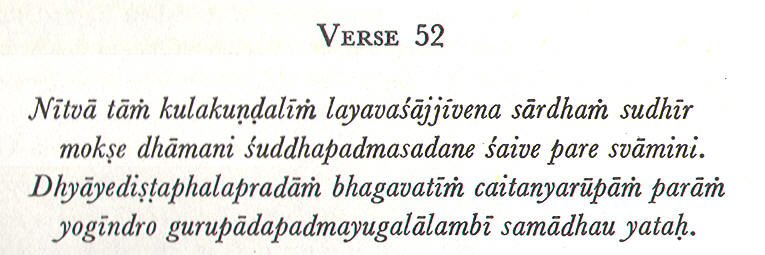
52. Nītvā tāṁ kulakuṇḍalīṁ layavaśājjīvena sārdhaṁ sudhīr
mokṣe dhāmani śuddhapadmasadane śaive pare svāmini.
Dhyāyediṣṭaphalapradāṁ bhagavatīṁ caitanyarūpāṁ parāṁ
Yogīndro gurupādapadmayugalālambī samādhau yataḥ.
The wise and excellent Yogi rapt in ecstasy1, and devoted to the Lotus feet of his Guru, should lead Kula-Kundali along with jiva to Her Lord the Para-siva in the abode of Liberation within the pure Lotus and meditate upon Her who grants all desires as the Caitanya-rupa-Bhagavati2. When he thus leads Kula-Kundalini, he should make all things absorb into Her.
COMMENTARY
Having spoken of the Dhyana-Yoga of Kundalinl, he now speaks of the Samadhi-Yoga of Kundalini. The substance of this verse is that the wise (Sudhi) and excellent Yogi (Yogindra) intent on the attainment of Samadhi should first of all lead Her who has been roused, who then, taking with Her Jiva, reaches the Brahmadvara, causing the absorption into Herself of everything as She moves along. When She who is the Istadevata and the giver of all good fruits is led up to Her Lord and is united with Him, the Para Bindu, She should be meditated upon as the Supreme (Parā, i.e., Para-Bindu, Param-bindu-svarupam). When She has been led to Her Lord Siva, the Para-Bindu, and has been united with Him, She should be meditated upon as the Ista-devata who grants good fruit.
1 ecstasy1 Samadhi, Vide Introduction, and post, Commentary.
2 Caitanya-rupa-Bhagavati2 The Devi who is the Cit in all bodies.
............................................................................................................................................................................................
He should there (in the Sahasrara) dissolve the Para-Bindu in the Cidatma1 which is in the void within the Bindu, and should meditate upon Her (Kundalini) as Suddha-caitanya-rupa2. He thus realizes the identity of Jiva and Atma, being conscious within himself that "I am He" (Soham); and having dissolved the Citta he remains unmoved, by reason of his full and all-pervading Knowledge.
The Revered Preceptor (Srimat-Acarya)3 has said: "The wise one should absorb the Karana4 Ma-kara into the Cidatma, and realize: ' I am Cidatma, I am eternal, pure (Suddha), enlightened (Buddha), liberated (Mukta); I am That which alone is (Sat), without a second (Advaya); I am Supreme Bliss wherein is all bliss and Vasudeva's very self, I amOm5 Having realized that the mind (Citta) is the discriminator, he absorbs it into its witness6 Let not the mind (Citta) be distracted when it is absorbed into Cidatma. Let him (the Sadhaka) rest in the fullness of his Illumination like a deep and motionless ocean."
" Ma-kara7: This is said for those who are Sadhakas of the Pranava, By Karana is here meant Para-Bindu. By "I am Vasudeva" (Vasudevo'ham) the Vaisnavas are alluded to (vide ante, vv. 44, 49).
We thus see that the worshipper of any particular Devata should realize that Kundalini is one with the object of his worship. In Pranava worship, for instance, the worshipper realizes his identity with the Omkara; in other forms of worship he realizes his identity with Kundalini, who is embodied by all the Mantras of different worshippers.
The Tantrantara says: "The King among Yogis becomes full of Brahma-bliss by making his mind the abode of the great void which is set in the light of the Sun, Moon, and Fire8."
1 Cidatma1The Brahman as Cit. 2 Pure Cit.
2 Suddha-caitanya-rupa2 Pure Cit.
3 (Srimat-Acarya)3 That is, Samkaracarya,
4 Karana4 That is, the Bindu is Ma-kara. It is the Karana or Cause of all.
5 Om5
Cidātmāhaṁ nitya-śuddha-buddha-mukta-sadavayaḥ
Paramānanda-saṁdoho'ham vāsudevo'haṁ om iti.
6 witness6 That is, the Atmā, of which it is said Atma sākṣi ceta kevalo nirguṇaśca.
7 Ma-kara7 The Bindu is the Ma-kara.
8 light of the Sun, Moon, and Fire8 That is, in the region of the Sahasrara. See v. 4 of the Pādukāpancake.
...........................................................................................................................................................................................
52. Nītvā tāṁ kulakuṇḍalīṁ layavaśājjīvena sārdhaṁ sudhīr --Verse 52 Line 1
mokṣe dhāmani śuddhapadmasadane śaive pare svāmini.-- Verse 52 Line 2
Dhyāyediṣṭaphalapradāṁ bhagavatīṁ caitanyarūpāṁ parāṁ -- Verse 52 Line 3
Yogīndro gurupādapadmayugalālambī samādhau yataḥ. --Verse 52 Line 4
"Lead Kundali along with Jiva" (Jīvena sārdham nitvā).-The Jivatma which is the Hamsa, in form like the tapering flame of a light, should be brought to the Muladhara from its place in the heart, and then led along with Kundalini.
"Abode of Liberation" (Mokṣe dhāmani).-- This qualifies Pure Lotus (Suddha-padma1).. It is here that Liberation is attained.
" Devoted to the two Lotus feet of his Guru" (Guru-pāda-padma-yugalālambī).-This qualifies Yogindra (excellent yogi). The Author means that Siddhi can only be attained by the instructions of the Guru. The Sadhaka should therefore seek shelter at his feet.
"Rapt in ecstasy" (Samādhau yataḥ.).-The Kulārṇava-Tantra (ix, 9) defines Samadhi thus: "Samadhi is that kind of contemplation2 a in which there is neither' here' nor' not here' which is illumination and is still like the ocean, and which is the Void Itself3."
Also elsewhere: "The Munis declare that the constant realization of the identity of the Jivatma with the Paramatma is Samadhi, which is, one of the eight limbs (Anga) of Yoga4." Pataiijali defines" Yoga to be the control of the modifications (or functions) of Citta (Yogas-citta-vrtti-nirodhah), "
Rapt (Yatāh.)-i.e., he who constantly and with undivided attention practises it.
Nītvā tāṁ kulakuṇḍalīṁ layavaśājjīvena sārdhaṁ sudhīr --Verse 52 Line 1
" When he leads Kula-Kundalini he should make all things absorb into her" (Laya-vasāt-nitvā5).--Below is shown the process of absorption:
"O Deveśī, the Laṁ-kāra6 should next be meditated upon in the Triangle; there should also Brahma and then Kāma-deva be contemplated. Having fixed Jiva there with the utterance of the Pranava, let him lead the Woman, who is longing for the satisfaction of Her passion7," to the place of Her husband8," O Queen of the Devas, O Great Queen, O beloved of my life, let him think of Ghrāṇa (Prthivl) and meditate on the adorable Sakti Dākinī.
1 Suddha-padma1 Samkara reads it as Sukla-padma, white lotus.
2 contemplation2 Dhyana,
3 Void Itself3 Svarūpa-sūnya.
4 Yoga4 This is from Sarada-Tilaka, Ch. XXV, v. 26.
5 Laya-vasāt-nitvā5 Visvanatha reads it as Naya-vaśāt,
6 Laṁ-kāra6 Bija of Pṛthivī.
7 Her passion7 Visarga-nāśa-kāminī.
8 Her husband8 That is, the Bindu in Sahasrāra.
...............................................................................................................................................................................................
O Daughter of the Mountain, O Queen of the Ganas1, O Mother, all these should be led into Prthivi."
Also: "Then, O Great Queen, the blessed Prthivi should be absorbed into Gandha, and then, O Daughter of the Mountain King, the Jivatma should be drawn (from the heart) with the Pranava (Mantra), and the Sadhaka should lead Prāṇa2 Gandha3, and Kundalini into Svadhisthana with the Mantra So'ham."
And also: "In its (Svadhisthana) pericarp should Varuna and Hari4 be meditated upon. And, O Beauteous One, after meditating on Rākinī5 all these and Gandha (smell) should be absorbed into Rasa (taste), and Jivatma, Kundalinj, and Rasa, should be moved into Manipura."
And again: "O thou of beautiful hips6 (Susroni}, in its7 pericarp the Sadhaka should meditate upon Fire, and also on Rudra, who is the destroyer of all, as being in company with the Sakti Lakini and beautiful to behold. And, O Sive, let him next meditate on the lustrous sense of vision, and absorb all these and Rasa (taste) into Rupa (Sight), and thereafter lead Jivatma, Kundalini, and Rupa, into Anahata."
And again: "Let him meditate in its8 pericarp on Vayu, who dwells in the region of Jiva, as also on the Yoni-mandala, which is made beauteous by the presence of the Bana-Linga. Let him there also meditate on Vayu9 as united with Rakini and touch (Tvākindriya or Sparsa), and there, O Thou who purifiest, Jiva, Kundalini, and Rupa, should be placed in Sparśa (Touch), and then Jiva, Kundalini, and Sparsa, should be placed in the Visuddha." www.bhagavadgitausa.com/Sat-Chakra-Nirupana-Kundalini Chakras.htm
And again: "Let him meditate in its10 pericarp on the Ethereal region11 and on Siva accompanied by Sakinl, and having placed Speech (Vak) , and Hearing (Srotra), in Ether, let him, O Daughter of the Mountain, place all these and Spada in Sabda (Sound), and place Jiva Kundalinl, and Sabda, in the Ajna-Cakra."
The above passages are from Kankalamalini-Tantra.
1 Ganas1 Attendant (Upadevatā) on Siva, of whom Gaṇeśa is the Lord.
2 Prāṇa2 Sic in text: Quaere Ghrāṇa or Prāna in sense of Haṁsa.
3 Gandha3 i.e., Gandha-Tanmātra.
4 Hari4 i.e., Visnu,
5 Rākinī5 Purāṇkariṇī-one of her names.
6 i beautiful hips6.e., one who has a beautiful figure, the part being selected for the whole.
7 in its7 " Its "-i.e., of Maṇipura-padma.
8 in its8 " Its "-i.e., of Anāhata-padma.
9 Vayu9 Vayu here is Iśa the Lord of Air.
10 in its10 Viśuddha-padma.
11 region11 Akāśa.
..............................................................................................................................................................................................
(Vak) , and Hearing (Srotra), in Ether, let him, O Daughter of the Mountain, place all these and Spada in Sabda (Sound), and place Jiva Kundalinl, and Sabda, in the Ajiia-Cakra."
The above passages are from Kankalamalini-Tantra.
" Triangle" in the above is the Triangle in the Muladhara, from which the commencement is made. Lam-kara should be meditated upon as within this Triangle. Leading of Jiva with the use of the Pranava is a variant practice. " Visarga-nāsakāmiṇī"; by Visarga is meant the agitation caused by an excess of Kāma (desire). The compound word means She who is striving to satisfy Her desire (Kāma). The bringing of Jiva by the Hamsa-Mantra is, according to the teaching of some, "Place of her husband" (Patyau pade): This is the Bindu, the Siva in the Lotus of a thousand petals. Sadhaka should lead Her there.
The Bija Lam, Brahma, Kamadeva, Dakini-Sakti, and the sense of smell (Ghrāṇendriya)--all these are absorbed into Prthivi, and Prthivi is absorbed into the Gandha-tattva. Jivatma, Kundalini, and Gandhatattva, are drawn upward by the Pranava, and brought into the Svadhisthana by the So'harn Mantra. This is the process to be applied right through. After leading Jiva, Kundalini, and Sabda-tattva, into AjnaCakra, Sabda-tattva should be absorbed into Aharnkara which is there, and Ahamkara into Mahat-tattva, and Mahat-tattva into Suksma-prakrti, whose name is Hiranya-garbha, and Prakrti again into Para-Bindu,
The Mantra-tantra-prakasa says: " Let Vyoma (Ether) be absorbed into Ahamkara, and the latter with Sabda into Mahat, and Mahat again, into the unmanifest (Avyakta), supreme (Para), Cause (Karana), of all the Sakti, Let the Sadhaka think attentively that all things beginning with Prthivi are absorbed into Visnu1 the Cause who is Sat, Cit, and Ananda."
That is, Mahat, which is all Saktis (Sarva-Sakti), should be absorbed into Suksma-prakrti, who is known by the name of Hiranya-garbha, and that Prakrti should be absorbed into Para, by which is meant the Cause in the form of Para-Bindu. In this connection the Acarya has laid down the rule that the gross should be dissolved into the subtle2. Cj.:" It should be attentively considered and practiced that the gross is absorbed into the subtle, and all into Cidatma."
1 Visnu1 Visnu is specified by this particular Tantra, but it may be any other Devata who is the Ista-devata of the Sadhaka.
2 subtle2 Vide, v, 40 and Commentary under it.
..............................................................................................................................................................................................
The absorption of all things, beginning with Prthivl and ending with Anahata1 ,takes place in the aforesaid manner; that being so, the feet and the sense of Smell (Ghranendriya) and all pertaining to Prthivi are dissolved in the place of Prthivi as they inhere in Prthivi,
Similarly, the hands, the sense of Taste (Rasanendriya), and all that pertains to Water, are dissolved in the region of Water. In the region of Fire (Vahni-sthana) are dissolved the anus, the sense of Vision (Cakśurindriya), and all that pertains to Fire. In the region of Air (Vāyusthāna) the genitals, the sense of Touch (Tvākindriya), and all that pertains to Vayu, are dissolved. In the place of Akasa are dissolved the sense of Speech (Vak) and hearing (Śrotrendriya) and all that pertains to Akasa (Ether).
In the Ajna-Cakra the dissolution of Ahamkara, Mahat, Sūkṣmaprakrti, and so forth, takes place, each dissolving into its own immediate cause. The letters of the alphabet should then be absorbed in the reverse order (Viloma), beginning with Ksa-kara and ending with Akara. By "all things" it is meant that "'Bindu," "Bodhini " and so forth, which have been shown above to be causal bodies (Karana Sarira), should be dissolved in a reversed order (Vilomena) into the Primordial Cause (Adi-kārana)--the Para-Bindu, Thus the Brahman alone remains.
The process is thus described: "The Sadhaka, having thus made his determination (Samkalpa), should dissolve2 the letters of the Alphabet in the Nyāsa-sthāna3 The dissolution of Ksa is in La, and La in Ha; Ha, again, is dissolved into Sa, and Sa into ṣa, and thus it goes on till A is reached. This should be very carefully done."
Also4: "Dissolve the two letters into Bindu, and dissolve Bindu into Kalā. Dissolve Kalā in Nāda, and dissolve Nāda in Nādānta5, and this into Unmanī, and Unmanī into Viṣṇu-vaktra6 ; Continued on next page.
1 Anahata1 This seems an error, for the last Mahabhuta Akasa is dissolved in Visuddha,
2 dissolve2 Samharet,
3 Nyāsa-sthāna3 The places where the Varnas have been placed in Matrkli-Nyasa.
4 Also4 Here is shown the Anuloma process. The two letters are Ha and Kṣa.
5 Nādānta5 i.e., that which is beyond Nada, See Introduction.
6 Viṣṇu-vaktra6 Pum-Bindu; v. post.
............................................................................................................................................................................................
Visnu-vaktra should be dissolved into Guru-vaktra1 Let the excellent Sadhaka then realize that all the letters are dissolved in Parama-Siva."
By Visnu-vaktra is meant Pum-Bindu. "The Surya-Bindu is called the Face, and below are Moon and Fire." "Bindu is said to be the Male, and Visarga is Prakrti2."
All these authorities imply the same thing, and go to prove that it is the" mouth of Visnu " (Visnu-vaktra) where dissolution should take place. The following from Kesavacarya3 also leads to the same conclusion:
"Lead Her (Unmani) into the Male, which is the Bindu; lead Bindu into Parātma, and Parātma into Kāla-tattva, and this latter into Sakti, and Sakti into Cidātma, which is the Supreme (Kevala), the tranquil (Sānta), and effulgent."
We have seen that each dissolves into its own immediate cause.
Nadanta is therefore dissolved in Vyapika-Sakti, the Vyapika-Sakti in Unmani and Unrnani in Samani4 and Samani in Visnu-vaktra. When the letters have been thus dissolved, all the six Cakras are dissolved, as the petals of the Lotuses consist of letters5.
The Visvasāra-Tantra says: "The petals of the Lotuses are the letters of the Alphabet, beginning with A6. The Sammohana-Tantra7 describes the dissolution8 of the Lotuses and the petals thus: "Dissolve the letters from Va to Sa of the petals in Brahma,9 and dissolve Brahma in the Lotus of six petals which contains the letters Ba to La, and which is called Svadhisthana.
1 Guru-vaktra1 That is, the mouth of the Supreme Bindu (cited from Sarada-Tilaka, Ch. V, vv. l34-l3!1). Also cf. Sarada, Ch. XII, 123, and Kularnava, IV, 76.
2 Prakrti2 Cf. Sarada, Ch. XXV, v, 51. Also Nitya-ṣoḍaśikā, I, 201, and Kāma- Kalāvilāsa.
3 Kesavacarya3 Also called Kesava-Bharati---a great Vaisnava teacher who initiated Śrī-Caitanya the greatest among latter-day Vaisnavas, into Samnyasa or the path of Renunciation.
4 Samani4 Sic. This is in conflict with other texts, according to which Unmani is above Samani,
5 letters5 Padma-dalnāṁ varṇa-mayatvāt,
6 A6 Ādivarṇātmakaṁ patraṁ padmanām pārikīrtitaṁ.
7 Sammohana-Tantra7 Ch. IV. The passage cited also occurs in Sarada-Tilaka, Ch. V, vv, 129-134.
8 dissolution8 Vilaya.
9 Brahma,9 That is, Muladhara where Brahma or Kamalāsana is.
........................................................................................................................................................................................
Do this as the Guru directs." And so forth. And ending with:
" The wise one should then dissolve it (Visuddha) in the (Lotus of) two petals which contains the two letters Ha and Ksa, and dissolve the two letters which are in the latter lotus into Bindu, and dissolve Bindu into Kalā." 1
We thus see that the four letters in the Muladhara are dissolved therein and Muladhara is dissolved in Svadhisthana, Proceeding in this way till the Ajna-Cakra is reached, the letters Ha and Ksa which are there are also dissolved at this place. Then the Lotus itself is dissolved into Bindu, Bindu into Bodhini, and proceeding in this way as already shown everything is dissolved, into Para-Bindu. When the Ajna-Cakra is dissolved, all that it contains in its pericarp--Hākinī, Itara-Linga, Pranava---are unable to exist without support, and therefore after the dissolution into Prakrti these also are dissolved into Para-Bindu.
1dissolve Bindu into Kalā." 1 That is, the Bindu of the Ajna-Cakra is dissolved into Kundalini.

53. Lākṣābhaṁ paramāmṛtaṁ paraśivātpītvā Punaḥ kuṇḍalī
Nityānandamahodayāt kulapathānmūle viśetsundarī.
Taddivyāmṛtadhārayā sthiramatiḥ saṁtarpayeddaivataṁ
Yogī yogaparaṁparāviditayā brahmāṇḍabhāṇḍasthitaṁ.
THE beautiful Kundali drinks the excellent red1 nectar issuing from Para-Siva, and returns from there where shines Eternal and Transcendent Bliss2 in all its glory along the path of Kula,3 and again enters the Muladhara. The Yogi who has gained steadiness of mind makes offering (Tarpana) to the Ista-devata and to the Devatas in the six centres (Cakra), Dākinī and others, with that stream of celestial nectar which is in the vessel4 of Brahmanda, the knowledge whereof he has gained through the tradition of the Gurus.
COMMENTARY
He now speaks of what should be done after all the different kinds of Yoga described have been understood. The meaning of this verse is that the beautiful Kundali drinks the excellent nectar issuing from ParaSiva, and having emerged from the place of Eternal and Transcendental Bliss She passes along the path of Kula and re-enters Muladhara. The' Yogi, after having understood the different matters mentioned (Tat-tad-dhyānā-nantaram), should think of the inseparate union5 of Siva and Sakti, and with the excellent nectar produced from the bliss of such union with Para-Siva make offering (Tarpana) to Kundalini.
1 red1 Samkara says it is so coloured because it is mixed with the menstrual fluid, which is symbolic, like the rest of his erotic Imagery. Red IS the colour of the Rajo-Guna,
2 Transcendent Bliss2 Brahman is Eternity and Bliss.
3 path of Kula,3 The Channel in the Citrini-nādl.
4 the vessel4 The vessel is Kundalini,
5 inseparate union5 Sāmarasya,
.................................................................................................................................................................................................
53. Lākṣābhaṁ paramāmṛtaṁ paraśivātpītvā Punaḥ kuṇḍalī....Verse 53 line 1
Nityānandamahodayāt kulapathānmūle viśetsundarī.....Verse 53 line 2
Taddivyāmṛtadhārayā sthiramatiḥ saṁtarpayeddaivataṁ ....Verse 53 line 3
Yogī yogaparaṁparāviditayā brahmāṇḍabhāṇḍasthitaṁ. ....Verse 53 line 4
" Path of Kula" (kulapathā).-The path of Brahman, the channel in Citrini,
Kundalī drinks the nectar with which Tarpana is made to her. The following authority says: "Having effected their union and having made (Her drink)," etc. It follows, therefore, that She is made to drink. The nectar is red like the colour of lac.
" From there where shines Eternal and Transcendent Bliss" (Nityānandamahodayāt)--that is She, returns from the place where eternal and transcendental Bliss is enjoyed---i.e., where the Brahman is clearly realized.
" Again enters Mūlādhāra " (mūle viśet),-She has to be brought back in the same way as She was led upward. As She passed through the different Linga and Cakras in their order (Cakra-bheda-kramena) when going upward, so does She when returning to the Muladhara.
The Revered Great Preceptor says: "Kundālinī 1Thou sprinklest all things with the stream of Nectar which flows from the tips of Thy two feet; and as Thou returneth to Thy own place Thou vivifiest and makest visible all things that were aforetime invisible, and on reaching Thy abode Thou dost resume Thy snake-like coil and sleep." 2
"As Thou returnest Thou vivifiest and makest visible." This describes the return of Kuṇḍalī to Her own place. As She returns She infuses Rasa, into the various things She had previously absorbed into Herself when going upward, and by the infusion of Rasa3, She makes them all visible and manifest. Her passage was Laya-krama4 and Her return Srsti-krama5 Hence it has been said: " Kuṇḍalī, who is Bliss,6 the Queen of the Suras,7 goes back in the same way to the Adhara8 Lotus."
1 Kundālinī 1 Kuhara is a cavity; Kuharini would then be She whose abode is a cavity-the cavity of the Muladhara.
2 Thy snake-like coil and sleep." 2 Cited from the celebrated Anandalahari-Stotra, Wave of Bliss Hymn, attributed to Samkaracarya, See" Wave of Bliss," a translation, by A. Avalon. Avalon, Arthur and Woodroffe, Sir John. Wave of Bliss. Madras: Ganesh and Co., 1961.
3 Rasa3 Rasa: sap, sap of life-that is, She re-vitalizes them.
4 aya-krama4 See v. 52 and next note.
5 Srsti-krama5 That is, She recreates or revives as She returns to her own abode; just as She" destroys" or absorbs all things on Her upward progress.
6 Bliss,6 Mudrā-kārā-s-rhar is Ananda-rūpiṇī; for Mudra=Ananda-dāyinī. Mudra is derived from Mud = ānanda (bliss)+Rāti=dadati (gives): Mudra therefore means that which gives bliss.
7 Suras,7Sura =Deva. Here the different Devas in the Cakras.
8 Adhara8 Lotus i.e., Muladhara.
.........................................................................................................................................................................................
The Bhūta-śuddhi-prakaraṇa has the following: "Let the Tattvas Prthivi, etc., in their order, as also Jiva and Kundalini, be led back from Paramatma and each placed in its respective position." She is then particularly described: "She is lustrous when first She goes, and She is ambrosial1 when She returns."
Taddivyāmṛtadhārayā sthiramatiḥ saṁtarpayeddaivataṁ ....Verse 53 line 3
" Stream of celestial nectar" (Divyāmṛtadhārā)---This is the excellent nectar which, as has already been shown, is produced by the union2 of Siva and Sakti, and runs in a stream from the Brahma-randhra to the Muladhara. It is for this reason that the Author says in v. 3 that" the Brahma-dvara which shines in Her mouth is the entrance to the place sprinkled by ambrosia."
Yogī yogaparaṁparāviditayā brahmāṇḍabhāṇḍasthitaṁ. ....Verse 53 line 4
" Knowledge whereof he has gained through the tradition of the Gurus" (Yoga-paramparā-viditayā).-This qualifies "Stream of Nectar". It means that the knowledge is gained from instructions (in Yoga practice) handed down traditionally through the succession of Gurus.
" Which is in the vessel of Brahmāṇda" (Brahmanda- Bhāṇḍa -sthitarn), -This qualifies Amrta (nectar).3 The vessel or support (Bhāṇḍa) on which the Brahmanda (Universe) rests is Kundalinl, Kundalini is the Bhāṇḍa as She is the Source (Yoni) of all.
By Daivatam4 ' is meant the Istadevata and Dakini and others in the six Cakras. It has been said: "O Devesi, with this nectar should offering (Tarpana) be made to the Para-devata, and then having done Tarpaṇa to the Devatas in the six Cakras," and so forth.
1 ambrosial1 Because ambrosia (Amrta) gives life.
2 union2 Samarasya.
3 Amrta (nectar).3 Visvanatha reads this as an adjective qualifying Daivatam, and this seems more in consonance with the text. The Brahmanda is compared to a Bhanda, and the Devatas are in 'that. The offering is then made with that stream of nectar to the Devatas who are in the Universe. Or, according to Kallcarana, offering is made to the Devatas of the Amrta which Kundali has drunk.
4Daivatam4 Daivatam is the collective form of Devatas.

54. Jñātvaitatkramamuttamaṁ yatamanā yogi yamādyair-yutaḥ
śrīdīkṣāgurupādapadmayuglāmodaprvāhodayāt.
Samśare na hi janyate na hi kadā saṁkṣīyate saṁkṣaye
nityānandaparaṁparāpramuditaḥ śāntaḥ satāmagraṇīḥ.
THE Yogi who has after practice of Yama, Niyama, and the like,1 learnt this excellent method from the two Lotus Feet of the auspicious Diksa-guru,2 which are the source of uninterrupted joy, and whose mind (Manas) is controlled, is never born again in this world (Samsara). For him there is no dissolution even at the time of Final Dissolution3 Gladdened by constant realization of that which is the source of Eternal Bliss.4 he becomes full of peace and foremost among all Yogis.5
COMMENTARY
He here speaks of the good to be gained by knowing the method of Yoga practice.
54. Jñātvaitatkramamuttamaṁ yatamanā yogi yamādyair-yutaḥ ---Verse 54 line 1
śrīdīkṣāgurupādapadmayuglāmodaprvāhodayāt. ---Verse 54 line 2
Samśare na hi janyate na hi kadā saṁkṣīyate saṁkṣaye ---Verse 54 line 3
nityānandaparaṁparāpramuditaḥ śāntaḥ satāmagraṇīḥ. ---Verse 54 line 4
" From the lotus feet of his auspicious Diksa-guru, which are the source of uninterrupted joy" (Sri-dīkśā-guru-pāda-padma-yugalā-moda-pravāhodayāt). -Amoda means joy or bliss; and by Pravaha is meant uninterrupted and continuous connection. Amoda pravaha therefore means Nityananda, or "Eternal Bliss". Bliss such as this comes from the Lotus feet of the Guru, which also lead to knowledge of Yoga practice.
1 like,1 See Introduction.
2 Diksa-guru,2 The Guru who has given him initiation.
3 Final Dissolution3 Saṁkṣaya = Pralaya.
4 Eternal Bliss.4 Nityānanda = Brahman.
5 all Yogis.5 Satām--lit., "of the Good".
...........................................................................................................................................................................................
The Diksa-guru is here spoken of as he is the first to initiate, and also by reason of his pre-eminence. But in his absence refuge may be sought with other Gurus. It has therefore been said: " As a bee desirous of honey goes from one flower to another, so does the disciple desirous of knowledge (Jnana) go from one Guru to another1."
nityānandaparaṁparāpramuditaḥ śāntaḥ satāmagraṇīḥ. ---Verse 54 line 4
" Gladdened by constant realization of that which is the source of Eternal Bliss" (Nityānanda-pararṁparā-pramudita)-i.e., who is united with the Stream of Eternal Bliss.
"Foremost among the good" (Satām agraiṇiḥ).)-i.e., he is counted to be foremost among the good who are the Yogis.
1 go from one Guru to another1." This is from Ch. XII, of Niruttara-Tantra. This verse also occurs in Kularnava (Tantrik Texts, Vol. V), Ch. XIII, 132.

55.Yosdhīte niśi saṁdhyayorathe divā yogī svabhāvasthito
mokṣajñānanidānametadamalaṁ śuddhaṁ ca guptaṁ paraṁ.
Śrīmacchrīgurupādapadmayugalālambī yatāntarmanā-
stasyavaśyamabhīṣṭadaivatapade ceto narīnṛtyate.
IF the Yogi who is devoted to the Lotus Feet of his Guru, with heart unperturbed and concentrated mind, reads this work which is the supreme source of the knowledge of Liberation, and which is faultless, pure, and most secret, then of a very surety his mind 1 dances at the Feet of his Ista-devata.
COMMENTARY
He here speaks of the good to be gained by the study of the verses relating to the six Cakras,
55.Yosdhīte niśi saṁdhyayorathe divā yogī svabhāvasthito---Verse 55 Line 1
mokṣajñānanidānametadamalaṁ śuddhaṁ ca guptaṁ paraṁ. ---Verse 55 Line 2
Śrīmacchrīgurupādapadmayugalālambī yatāntarmanā- ---Verse 55 Line 3
stasyavaśyamabhīṣṭadaivatapade ceto narīnṛtyate. ---Verse 55 Line 4
" Heart unperturbed" (Svabhāva-sthitah).-i.e., engrossed in his own true spiritual being.
"Concentrated mind" (Yatāntarmanāh)-i.e., he who by practice of Yoga has steadied and concentrated his mind on the inner spirit (Antarātma),
The rest is clear. www.bhagavadgitausa.com/Sat-Chakra-Nirupana-Kundalini Chakras.htm
Here ends the Eighth Section of the Explanation of the Verses descriptive of the Six Cakras, forming part of the Sri-tattva-cintamaṇī, composed by Srl-Pūrnanandayati,
1 mind 1 Cetas or Citta.

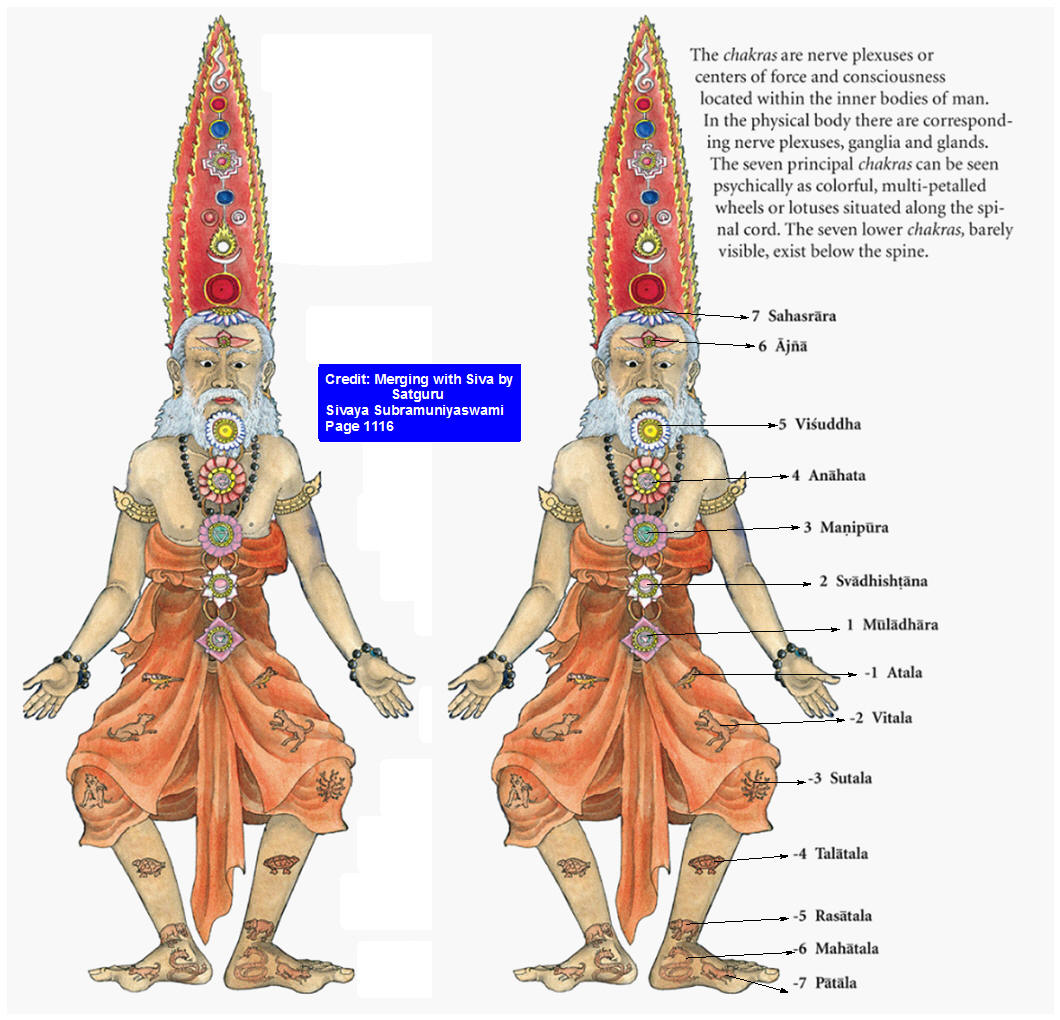
Click here to go to Kundalini Power
Click here for verses plus commentary on paduka panchaka
These are verses only. There is a separate file Paduka Panchaka with commentary as mentioned above.
